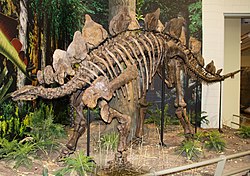йқһжӯЈејҸе‘ҪеҗҚжҒҗйҫҚеҲ—иЎЁ йқһжӯЈејҸе‘ҪеҗҚжҒҗйҫҷеҲ—иЎЁжҳҜдёҖдёӘе…ідәҺжңӘжңүжӯЈејҸ科еӯҰеҗҚз§°зҡ„жҒҗйҫҷзҡ„еҲ—иЎЁпјҢд»…еҗ«жңӘжӯЈзЎ®еҸ‘еёғжҲ–жңӘжӯЈејҸеҸ‘еёғеӯҰеҗҚзҡ„жҒҗйҫҚгҖӮжӯӨеҲ—иЎЁдёӯзҡ„еҗҚз§°жңүд»ҘдёӢзұ»еһӢпјҡ
еҸҰйңҖжіЁж„Ҹпјҡ
AйҳҝжӢүж‘©жҡҙйҫҷ йҳҝжӢүж‘©жҡҙйҫҷпјҲ"Alamotyrannus"пјҢж„ҸдёәвҖңйҳҝжӢүж‘©зҡ„жҡҙеҗӣвҖқпјүжҳҜз§Қе°ҡжңӘжҸҸиҝ°зҡ„жҡҙйҫҷ科жҒҗйҫҷпјҢз”ҹеӯҳдәҺжҷҡзҷҪеһ©дё–зҡ„еҢ—зҫҺ[1]пјҢеҢ–зҹідәҺ20дё–зәӘеҲқеңЁж–°еўЁиҘҝе“Ҙе·һзҡ„зҷҪжҘҠеұұзө„еҸ‘зҺ°гҖӮе®ғиҰҒд№ҲжҳҜдёҖдёӘзӢ¬з«ӢеұһпјҢиҰҒд№Ҳд»…дёәжҡҙйҫҷзҡ„ејӮеҗҚгҖӮжӢҹе®ҡзҡ„жЁЎејҸз§Қеёғж°ҸйҳҝжӢүж‘©жҡҙйҫҷпјҲ"Alamotyrannus brinkmani"пјүжҳҜеңЁ2013е№ҙе»әз«Ӣ[2]гҖӮ вҖңйҳҝжӢүж‘©жҡҙйҫҷвҖқз”ҹеӯҳж–јеӨ§зәҰ7000дёҮе№ҙеүҚзҡ„马ж–Ҝзү№йҮҢиө«зү№йҳ¶ж—©жңҹпјҢжҜ”е·ІзҹҘжңҖж—©зҡ„еҮәзҺ°жҡҙйҫҷиҝҳиҰҒж—©200дёҮе№ҙ[2]гҖӮ ж Үжң¬ACM 7975дёә1924е№ҙеңЁж–°еўЁиҘҝе“Ҙе·һзҷҪжқЁеұұз»„еҸ‘зҺ°зҡ„дёҖеқ—йўҢйӘЁпјҢеҪ“ж—¶еҲқжӯҘйүҙе®ҡдёәе№іиЎЎиӣҮеҸ‘еҘіжҖӘйҫҷпјҢдҪҶжҚ®иҫҫе°”жӣјдёҺеҚўеҚЎж–ҜпјҲ2013е№ҙпјүеҸҠйәҰе…Ӣе”җзәіпјҲ2022е№ҙпјүз§°еҫҲеҸҜиғҪеұһдәҺйҳҝжӢүж‘©жҡҙйҫҷ[2][3]гҖӮиҜҘж Үжң¬зӣ®еүҚеңЁиҙқе°јж–ҜеҹәиҮӘ然еҚҡзү©йҰҶеұ•еҮә[2][3]гҖӮ жҒҗйҫҷиүҫдјҰ жҒҗйҫҷиүҫдјҰпјҲ"Alan the Dinosaur"пјүжҳҜиӢұеӣҪжғ зү№жҜ”зҙўзү№з»ҙе…Ӣз»„пјҲдёӯдҫҸзҪ—дё–йҳҝиҝһйҳ¶пјүеҸ‘зҺ°зҡ„дёҖиҠӮиңҘи„ҡзұ»е°ҫжӨҺпјҲYORYM:2001.9337пјүзҡ„йқһжӯЈејҸеҗҚз§°гҖӮе®ғжҳҜиӢұеӣҪжңҖеҸӨиҖҒзҡ„иңҘи„ҡзұ»еҠЁзү©пјҢеҢ–зҹіж—¶жңҹеҸҜиҝҪжәҜиҮі1.76иҮі1.72дәҝе№ҙеүҚгҖӮе…¶жҳөз§°еҫ—еҗҚиҮӘ1995е№ҙеҸ‘зҺ°иҜҘеҢ–зҹізҡ„иүҫдјҰВ·еҸӨе°”пјҲAlan GurrпјүгҖӮеӣ ж— жі•е®ҡз§ҚпјҢж•…жңӘжңүжӯЈејҸеҗҚз§°гҖӮ2015е№ҙзҡ„дёҖйЎ№еҲҶжһҗеҸ‘зҺ°е®ғжҳҜзңҹиңҘи„ҡзұ»зҡ„дёҖе‘ҳпјҢеҸҜжҺ’йҷӨеңЁжўҒйҫҷ超科д№ӢеӨ–пјҢдёҺйІёйҫҷжңҖдёәзӣёдјј[4]гҖӮ вҖңиүҫдјҰвҖқзҡ„еҢ–зҹіж”¶и—ҸдәҺзәҰе…ӢйғЎеҚҡзү©йҰҶпјҢдёәзәҰе…ӢйғЎдҫҸзҪ—зәӘдё–з•Ңеұ•и§Ҳзҡ„дёҖйғЁеҲҶ[5]гҖӮ ејәеЈ®ејӮзү№йҫҷ ејәеЈ®ејӮзү№йҫҷпјҲ"Allosaurus robustus"пјүжҳҜжҫіеӨ§еҲ©дәҡз»ҙеӨҡеҲ©дәҡе·һж—әиҗЁеҗүз»„пјҲж—©зҷҪеһ©дё–пјүеҸ‘зҺ°зҡ„дёҖеқ—е…Ҫи„ҡзұ»и·қйӘЁпјҲеҚіж Үжң¬NMV P150070пјүзҡ„йқһжӯЈејҸеҗҚз§°[6]гҖӮеҲқж¬Ўз ”з©¶ж—¶и®ӨдёәиҜҘж Үжң¬еұһдәҺејӮзү№йҫҷзҡ„жҹҗдёӘзү©з§ҚгҖӮеЎһзјӘе°”В·дҝқзҪ—В·еЁҒе°”ж–ҜеҜ№иҜҘйүҙе®ҡиЎЁзӨәеҸҚеҜ№пјҢ并жҸҗеҮәе…¶еұһдәҺдјјйёҹйҫҷ科пјҢдҪҶеҜ№ж–№д»ҚеқҡжҢҒиҮӘе·ұзҡ„и§ӮзӮ№гҖӮ21дё–зәӘеҲқпјҢдё№е°је°”В·иҲ’е°”пјҲDaniel ChureпјүжЈҖжҹҘдәҶиҜҘйӘЁйӘјпјҢеҸ‘зҺ°е…¶е№¶йқһејӮзү№йҫҷж–°з§ҚпјҢдҪҶд»Қд»ЈиЎЁжҹҗз§ҚејӮзү№йҫҷ超科[7]гҖӮеҗҢж—¶дёңжҙӢдёҖе’ҢиҸІеҠӣВ·жҹҜйҮҢжҢҮеҮәиҝҷеқ—и·қйӘЁдёҺ他们жҸҸиҝ°зҡ„ж–°еұһзҰҸдә•зӣ—йҫҷеҫҲзӣёдјјгҖӮ[8]е®ғеҸҜиғҪеұһдәҺжҹҗз§ҚдёҺеҚ—ж–№зҢҺйҫҷиҝ‘зјҳзҡ„е…Ҫи„ҡзұ»пјҢдҪҶд№ҹжңүдәәи®Өдёәе…¶еұһдәҺйҳҝиҙқеҠӣйҫҷ超科[9]гҖӮ2019е№ҙзҡ„дёҖйЎ№з ”з©¶иҜҒжҚ®зЎ®еҮҝең°жҳҫзӨәиҜҘи·қйӘЁеұһдәҺеӨ§зӣ—йҫҷзұ»[10]гҖӮ вҖңејәеЈ®ејӮзү№йҫҷвҖқдёҖеҗҚжңҖеҲқд»…з”ЁдҪңеҚҡзү©йҰҶж ҮзӯҫпјҢз”ұиҲ’е°”дәҺ2000е№ҙйҰ–ж¬ЎжҸҗеҮә[11]гҖӮ йҳҝ马еҠ еү‘йҫҷ йҳҝйҰ¬еҠ еҠҚйҫҚпјҲ"Amargastegos"пјүжҳҜйҳҝж №е»·йҳҝйҰ¬еҠ зө„еҸ‘зҺ°зҡ„дёҖз§Қе·ІзҒӯз»қеү‘йҫҷ科жҒҗйҫҚзҡ„йқһжӯЈејҸеҗҚзЁұпјҢз”ұзҪ—жӣјВ·д№Ңе…°ж–ҜеҹәпјҲRoman UlanskyпјүдәҺ2014е№ҙж №жҚ®ж Үжң¬MACN N-43пјҲеҢ…жӢ¬иғҢйғЁзҡ®еҶ…жҲҗйӘЁгҖҒйўҲжӨҺгҖҒе°ҫжӨҺеҸҠдёҖеқ—йЎұйӘЁпјүе‘ҪеҗҚпјҢжӢҹе®ҡзҡ„жЁЎејҸз§ҚжҳҜзҹӯйўҲйҳҝ马еҠ еү‘йҫҷпјҲ"A. brevicollum"пјүгҖӮ2016е№ҙпјҢеҪјеҫ—В·еҠ е°”еҶ¬е’ҢиӮҜе°јжҖқВ·еҚЎеҪӯзү№е®Јеёғе®ғжҳҜдёҖеҖӢз„ЎиіҮж јеҗҚзЁұпјҢ并е°Ҷе…¶йүҙе®ҡдёәеҲҶйЎһдёҚжҳҺзҡ„еү‘йҫҷйЎһ[12]гҖӮвҖңйҳҝ马еҠ еү‘йҫҷвҖқжҳҜеҚ—еҚҠзҗғдёәж•°дёҚеӨҡзҡ„еү‘йҫҷзұ»д№ӢдёҖ[13]гҖӮ е®үеҫ—жӢүйҫҷе®үеҫ—жӢүйҫҚпјҲ"Andhrasaurus"пјүжҳҜеҚ°еәҰ科塔зө„еҸ‘зҺ°зҡ„дёҖз§Қе·ІзҒӯз»қиЈқз”ІйёҹиҮҖзӣ®жҒҗйҫҷзҡ„йқһжӯЈејҸеҗҚзЁұпјҢз”ұзҪ—жӣјВ·д№Ңе…°ж–ҜеҹәдәҺ2014е№ҙж №ж“ҡйғЁеҲҶйЎұйӘЁгҖҒзәҰ30еқ—зҡ®еҶ…жҲҗйӘЁеҸҠжӨҺйӘЁе’ҢеӣӣиӮўйӘЁйӘје‘ҪеҗҚпјҢжӢҹе®ҡзҡ„жЁЎејҸз§ҚжҳҜеҚ°еәҰе®үеҫ—жӢүйҫҷпјҲ"A. indicus"пјүгҖӮжүҖжңүеҢ–зҹізҡҶдҝқеӯҳеңЁGSIзҡ„и—Ҹе“ҒдёӯпјҢ并з”ұзәізү№зӯүдәәпјҲ2002е№ҙпјүеҲҶйЎһж–јз”ІйҫҷдёӢзӣ®[14]гҖӮ 2016е№ҙпјҢеҪјеҫ—В·еҠ е°”еҶ¬е’ҢиӮҜе°јжҖқВ·еҚЎеҪӯзү№жҢҮеҮәвҖңе®үеҫ—жӢүйҫҚвҖқзҡ„е‘ҪеҗҚдёҚз¬ҰеҗҲICZNзҡ„иҰҒжұӮпјҢе®Јеёғе®ғдёәз„ЎиіҮж јеҗҚзЁұпјҢ并е°Ҷе…¶еҲ—дёәиЈқз”Ізұ»жңӘе®ҡеұ¬пјҢеҗҢж—¶жіЁж„ҸеҲ°зәізү№зӯүдәәпјҲ2002е№ҙпјүжҸҸиҝ°зҡ„йўҢйӘЁеұһдәҺйі„еҪўи¶…зӣ®[12]гҖӮй«ҳе°”йЎҝдәҺ2019е№ҙйҮҚж–°жҸҸиҝ°вҖңе®үеҫ—жӢүйҫҚвҖқиЈ…з”ІеҢ–зҹі[15]гҖӮ жҳӮйӣ…е…ӢеӨҸжң—еҫ·зҡ„дјјйёҹйҫҷзұ»жҳӮйӣ…е…ӢеӨҸжң—еҫ·зҡ„дјјйёҹйҫҷзұ»пјҲ"Angeac ornthomimosaur"пјүжҳҜжі•еӣҪиҘҝйғЁжҳӮйӣ…е…ӢеӨҸжң—еҫ·йҷ„иҝ‘ж—©зҷҪеһ©дё–пјҲд»ҘеүҚиў«и®Өдёәе№ҙд»ЈдёәиұӘзү№йҮҢз»ҙйҳ¶иҮіе·ҙеҲ—е§Ҷйҳ¶[16]пјҢдҪҶж №жҚ®еӯўзІүеӯҰпјҢзҺ°еңЁиў«и®ӨдёәжҳҜиҙқйҮҢдәҡйҳ¶иҮіеҮЎи“қд»Ҡйҳ¶[17][18]пјүжҳӮйӣ…е…ӢеӨҸжң—еҫ·йӘЁеұӮпјҲйҳҝеҹәеқҰзӣҶең°ең°еұӮзҡ„дёҖйғЁеҲҶпјүеҸ‘зҺ°зҡ„дёҖз§ҚжңӘжҸҸиҝ°дјјйёҹйҫҷзұ»еҲҶзұ»еҚ•е…ғгҖӮиҜҘеҲҶзұ»еҚ•е…ғжІЎжңүзүҷйҪҝпјҢдё”е·ІеҸ‘зҺ°д»ЈиЎЁиҮіе°‘70е…·дёӘдҪ“гҖҒж¶өзӣ–еҮ д№Һж•ҙеүҜйӘЁйӘјзҡ„еӨ§йҮҸи„ұиҠӮйҒ—йӘё[17]пјҢйғЁеҲҶйҒ—йӘёз”ұиүҫдјҰзӯүдәәдәҺ2014е№ҙжҸҸиҝ°[19]гҖӮ зӣҺж јйӯҜжіўеЎһжқұйҫҚ зӣҺж јйӯҜжіўеЎһжқұйҫҚпјҲ"Angloposeidon"пјүжҳҜиӢұеӣҪеҚ—йғЁжҖҖзү№еІӣж—©зҷҪеһ©дё–пјҲе·ҙеҲ—е§Ҷйҳ¶пјүеЁҒеЎһе…Ӣж–Ҝзө„дёҖз§ҚйқһжӯЈејҸе‘ҪеҗҚзҡ„иңҘи„ҡзұ»жҒҗйҫҷ[20]пјҢиў«и®ӨдёәеҸҜиғҪеұһдәҺи…•йҫҷ科гҖӮи‘—еҗҚеҸӨз”ҹзү©еӯҰ家еҫ·жҒ©В·еҘҲиЁұжӣҫеҸӮдёҺеҜ№е…¶ж Үжң¬зҡ„з ”з©¶пјҢдҪҶе»әи®®д»…йқһжӯЈејҸдҪҝз”ЁжӯӨеҗҚпјҢдёҚиҰҒеҸ‘иЎЁ[21]гҖӮ然иҖҢе…¶жң¬дәәеҚҙеңЁиҮӘе·ұ2010е№ҙеҸ‘иЎЁзҡ„гҖҠеӣӣи¶іеӢ•зү©еӯёгҖӢпјҲTetrapod Zoology Book OneпјүдёҖд№ҰдёӯдәІиҮӘе…¬еёғдәҶиҜҘеҗҚз§°[22]гҖӮе…¶йҒ—йӘёз”ұеҚ•иҠӮйўҲжӨҺпјҲMIWG.7306пјүз»„жҲҗпјҢиЎЁжҳҺе®ғжҳҜдёҖеҸӘйқһеёёеӨ§зҡ„еҠЁзү©пјҢй•·йҒ”20зұіжҲ–жӣҙй•ҝ[23]гҖӮ еҸӨзӣңйіҘ еҸӨзӣңйіҘпјҲ"Archaeoraptor"пјүжҳҜдёҖ件йҮҚиҰҒзҡ„дёӯеӣҪеҢ–зҹізҡ„йқһжӯЈејҸеұһеҗҚпјҢиҜҘж Үжң¬еҗҺиў«еҸ‘зҺ°жҳҜз”ұеҗ„з§ҚеҪјжӯӨж— е…ізҡ„еҢ–зҹіжӢјжҺҘиҖҢжҲҗгҖӮжӯӨеҗҚдәҺ1999е№ҙйҰ–ж¬ЎеҸ‘иЎЁеңЁгҖҠеӣҪ家ең°зҗҶжқӮеҝ—гҖӢзҡ„дёҖзҜҮж–Үз« дёӯпјҢж–Үдёӯз§°иҜҘеҢ–зҹіжҳҜйёҹзұ»е’ҢйҷҶж –е…Ҫи„ҡзұ»жҒҗйҫҷд№Ӣй—ҙзҡ„вҖңзјәеӨұзҺҜиҠӮвҖқгҖӮеңЁиҜҘеҲҠжӯЈејҸеҮәзүҲд№ӢеүҚпјҢдәә们е°ұе·ІеҜ№еҢ–зҹізҡ„зңҹе®һжҖ§дә§з”ҹдёҘйҮҚжҖҖз–‘гҖӮеҗҺз»ӯз ”з©¶иЎЁжҳҺиҜҘеҢ–зҹіжҳҜз”ұдёҚеҗҢзү©з§ҚеҢ–зҹізўҺзүҮйҮҚз»„иҖҢжҲҗзҡ„иөқе“ҒгҖӮе‘Ёеҝ е’ҢзӯүдәәпјҲ2002е№ҙпјүеҸ‘зҺ°еӨҙйғЁе’ҢдёҠеҚҠиә«е®һйҷ…дёҠеұһдәҺеҺҹе§Ӣйёҹзұ»зҮ•йёҹпјҢеҗҢе№ҙеҸҰдёҖйЎ№з ”з©¶еҸ‘зҺ°е°ҫйғЁеұһдәҺ2000е№ҙе‘ҪеҗҚзҡ„е°ҸеһӢжңүзҝјй©°йҫҷ科е°Ҹзӣ—йҫҷ[24][25]гҖӮ и…ҝе’Ңи„ҡеұһдәҺдёҖз§ҚжңӘзҹҘзҡ„еҠЁзү©[26][27]гҖӮ еӨ§дё»ж•ҷ еӨ§дё»ж•ҷпјҲ"The Archbishop"пјүжҳҜз§Қзұ»дјји…•йҫҷеҸҠй•·й ёе·ЁйҫҚзҡ„е·ЁеһӢи…•йҫҷ科иңҘи„ҡзұ»жҒҗйҫҷгҖӮеӣ е…¶дёҺеёғж°Ҹи…•йҫҷпјҲзҺ°дёәй•·й ёе·ЁйҫҚпјүеқҮеңЁеқҰжЎ‘е°јдәҡж•ҰйҒ”еҸӨйӯҜзҡ„еҗҢдёҖең°еұӮеҸ‘зҺ°пјҢеӣ жӯӨиў«й•ҝжңҹи§ҶдёәеҗҺиҖ…зҡ„ејӮеҗҚгҖӮ然иҖҢпјҢвҖңеӨ§дё»ж•ҷвҖқжҳҫзӨәеҮәеҢ…жӢ¬и„ҠжӨҺзҚЁзү№еҪўж…Ӣе’ҢжҢүжҜ”дҫӢ延й•ҝзҡ„йўҲйғЁеңЁеҶ…зҡ„жҳҫи‘—е·®ејӮпјҢиЎЁжҳҺе®ғжҳҜдёҖдёӘзӢ¬з«Ӣеұһз§Қ[28]гҖӮе…¶еҢ–зҹіз”ұеј—йҮҢеҫ·йҮҢе…ӢВ·зұіеҗүеҫ·пјҲFrederick MigeodпјүдәҺ1930е№ҙеҸ‘зҺ°гҖӮвҖңеӨ§дё»ж•ҷвҖқжҳҜдёҖдёӘжҳөз§°пјҢиө·еҲ°еҚ дҪҚз¬Ұзҡ„дҪңз”ЁпјҢеӣ дёәж Үжң¬зӣ®еүҚжІЎжңүеӯҰеҗҚгҖӮиҜҘж Үжң¬зӣ®еүҚдҝқеӯҳдәҺдјҰж•ҰиҮӘ然еҺҶеҸІеҚҡзү©йҰҶпјҢжңҖз»Ҳе°Ҷз”ұеёғйҮҢж–Ҝжүҳе°”еӨ§еӯҰзҡ„йӮҒе…ӢзҲҫВ·жі°еӢ’еҚҡеЈ«йҮҚж–°жҸҸиҝ°[29]гҖӮ2018е№ҙ5жңҲпјҢжі°еӢ’ејҖе§ӢзқҖжүӢжҸҸиҝ°вҖңеӨ§дё»ж•ҷвҖқ[30]гҖӮ еӨ§иҘҝжҙӢйёӯйҫҷеӨ§иҘҝжҙӢйёӯйҫҷпјҲ"Atlantohadros"пјүеҸҲеҗҚй»ҳеҜҹзү№з»ҙе°”зҡ„йёӯеҳҙйҫҷзұ»пјҲ"Merchantville hadrosaur"пјүпјҢжҳҜж–°жіҪиҘҝе·һжҷҡзҷҪеһ©дё–й»ҳеҜҹзү№з»ҙе°”з»„еҸ‘зҺ°зҡ„дёҖз§Қйёӯеҳҙйҫҷ科жҒҗйҫҷзҡ„йқһжӯЈејҸеҗҚз§°гҖӮеёғжң—ж–ҜеқҰпјҲ2021е№ҙпјүеҸ‘зҺ°вҖңеӨ§иҘҝжҙӢйёӯйҫҷвҖқжҜ”зү№жҸҗж–ҜйёӯйҫҷжӣҙдёәиЎҚз”ҹпјҢдҪҶжҜ”ж үйҫҷдәҡ科е’Ңиө–ж°Ҹйҫҷдәҡ科жӣҙеҺҹе§Ӣ[31]гҖӮ е·ІзҹҘжңүдёү件ж Үжң¬пјҡYPM VPPU.021813гҖҒYPM VPPU.021813е’ҢAMNH 13704YPMпјҢзҡҶеңЁ20дё–зәӘ70е№ҙд»ЈеҸ‘зҺ°дәҺи’ҷиҢ…ж–ҜеҺҝ马зәіжӢүжҪҳиҮій©¬е°”дјҜжҙӣдёҖеёҰйҷ„иҝ‘зҡ„еј—з‘һйңҚе°”еҫ·иҘҝеҢ—8е…¬йҮҢпјҲ5.0иӢұйҮҢпјүеӨ„гҖӮеүҚ2件еңЁеҗҢдёҖең°зӮ№еҸ‘зҺ°пјҢдё”е…·жңүзӣёдјјзҡ„йўңиүІгҖҒйЈҺеҢ–зҠ¶еҶөе’Ңе°әеҜёпјҢеӣ жӯӨеҸҜиғҪеұһдәҺеҗҢдёҖдёӘдҪ“пјҢдҪҶеҮәдәҺи°Ёж…ҺпјҢдҪңиҖ…д»…иөӢдәҲдёӨиҖ…зӣёеҗҢзҡ„зј–еҸ·гҖӮеҢ–зҹіеҢ…жӢ¬пјҡдёӨдёӘе–ҷйӘЁгҖҒдёӨдёӘиӮ©иғӣйӘЁгҖҒдёҖдёӘиӮЎйӘЁгҖҒдёҖж №иӮӢйӘЁгҖҒдёҖдёӘж®Ӣзјәзҡ„иғ«йӘЁиҝ‘з«Ҝе’ҢдёҖдёӘж Үжң¬й“ёеһӢзҡ„йҪҝйҪҝпјҲеҺҹе§ӢйӘЁйӘјеҫҲеҸҜиғҪе·Із»ҸйҒ—еӨұпјүгҖӮAMNH 13704з”ұйғЁеҲҶйҪҝйӘЁз»„жҲҗгҖӮе…¶е®ғдёҖдәӣйӣ¶ж•ЈйӘЁйӘјеҢ…жӢ¬дёҖдёӘйҡ…йӘЁгҖҒйғЁеҲҶдёҠйўҢйӘЁгҖҒйғЁеҲҶйў§йӘЁгҖҒйў…йЎ¶зўҺзүҮе’ҢеҮ дёӘиӮӢйӘЁзўҺзүҮ[31]гҖӮ Bе·ҙз“ңйҫҷе·ҙз“ңйҫҷпјҲ"Baguasaurus"пјҢж„ҸдёәвҖңе·ҙз“ңзҡ„иңҘиңҙвҖқпјүжҳҜз§ҳйІҒжҷҡзҷҪеһ©дё–пјҲеқҺеё•йҳ¶иҮій©¬ж–Ҝзү№йҮҢиө«зү№йҳ¶пјүд№”еЎ”з»„дёҖз§ҚжңӘжҸҸиҝ°еІ©зӣ”йҫҷзұ»иңҘи„ҡдёӢзӣ®жҒҗйҫҷзҡ„йқһжӯЈејҸеҗҚз§°гҖӮжӢҹе®ҡзҡ„жӯЈжЁЎж Үжң¬з”ұе°ҫжӨҺз»„жҲҗпјҢеңЁиҺ«з‘һе°”зӯүдәәпјҲ1987е№ҙпјүеҜ№д№”еЎ”з»„зҡ„з ”з©¶дёӯйҰ–ж¬ЎжҸҗеҸҠ[32]пјҢиҖҢвҖңе·ҙз“ңйҫҷвҖқдёҖеҗҚеҲҷжҳҜз”ұжӢүи…Ҡй—ЁиҝӘе’ҢиҺ«еҲ©зәіВ·дҪ©йӣ·е…№пјҲ2020е№ҙпјүеңЁд№ҰдёӯжүҖеҲӣ[33]гҖӮдј°и®ЎвҖңе·ҙз“ңйҫҷвҖқй•ҝ12зұіпјҲ39иӢұе°әпјүгҖҒйҮҚ4е…¬еҷёпјҲ8,800зЈ…пјү[33]гҖӮ дҝҫи·Ҝж”ҜйҫҚдҝҫи·Ҝж”ҜйҫҷпјҲ"Balochisaurus"пјҢж„ҸзӮәвҖңдҝҫи·Ҝж”ҜиңҘиңҙвҖқпјҢеҫ—еҗҚиҮӘе·ҙеҹәж–ҜеқҰдҝҫи·Ҝж”ҜйғЁиҗҪпјүжҳҜз”ҹеӯҳдәҺжҷҡзҷҪеһ©дё–е·ҙеҹәж–ҜеқҰзҡ„дёҖзЁ®жі°еқҰе·ЁйҫҚйЎһиңҘи„ҡдёӢзӣ®жҒҗйҫҷзҡ„йқһжӯЈејҸеҗҚзЁұгҖӮжӢҹе®ҡзҡ„жЁЎејҸз§ҚжҳҜйҰ¬ж°Ҹдҝҫи·Ҝж”ҜйҫҚпјҲ"B.malkani"пјүгҖӮдҝҫи·Ҝж”ҜйҫҷеҢ–зҹіпјҲиҝһеҗҢе…¶д»–жҒҗйҫҷеҢ–зҹіж Үжң¬пјүжҳҜз”ұе·ҙеҹәж–ҜеқҰең°иҙЁи°ғжҹҘеұҖзҡ„дёҖйҳҹеҸӨз”ҹзү©еӯҰ家еңЁз»ҙиҫҫж јйҮҢйҷ„иҝ‘еҸ‘зҺ°[34]гҖӮдҝҫи·Ҝж”Ҝйҫҷз”ұ马尔еҚЎе°јпјҲ2006е№ҙпјүж №жҚ®её•еёғ组马ж–Ҝзү№йҮҢиө«зү№йҳ¶з»ҙиҫҫж јйҮҢж®өпјҲVitakri MemberпјүеҸ‘зҺ°зҡ„дёғиҠӮе°ҫжӨҺеҸҠе…¶е®ғеҪ’е…ҘиҜҘеұһзҡ„жӨҺйӘЁе’ҢйғЁеҲҶйў…йӘЁжүҖжҸҸиҝ°гҖӮдҝҫи·Ҝж”Ҝйҫҷе’ҢвҖң马йҮҢйҫҷвҖқеқҮиў«еҪ’е…ҘвҖңдҝҫи·Ҝж”Ҝйҫҷ科вҖқгҖӮеЁҒе°”йҖҠгҖҒе·ҙйӣ·зү№е’ҢеҚЎжӢүиҜәпјҲ2011е№ҙпјүзҡ„з ”з©¶и§Ҷд№Ӣдёәж— ж•Ҳеұһ[35]гҖӮ е·ҙжӢүе…Ӣйҫҷ е·ҙжӢүе…ӢйҫҷпјҲ"Barackosaurus"пјүжҳҜз”ЁдәҺжҸҸиҝ°жҖҖдҝ„жҳҺе·һиҺ«йҮҢйҖҠз»„еҗҜиҺ«йҮҢйҳ¶жІүз§Ҝзү©дёӯеҸ‘зҺ°зҡ„иңҘи„ҡзұ»еҢ–зҹізҡ„йқһжӯЈејҸеҗҚз§°гҖӮеҢ–зҹіеҸ‘зҺ°дәҺиҫҫзәійҮҮзҹіеңәпјҲDana QuarryпјүпјҢжҚ®жҺЁжөӢпјҢвҖңе·ҙжӢүе…ӢйҫҷвҖқй•ҝ20зұігҖҒйҮҚ20еҗЁ[36]гҖӮдәЁеҲ©В·еҠ еҲ©е®үиҜәпјҲHenry Galianoпјүе’ҢиҺұи’ҷеӨҡВ·йҳҝдјҜж–ҜеӨҡеј—пјҲRaimund AlbersdorferпјүдәҺ2010е№ҙж’°еҶҷдәҶдёҖзҜҮжңӘеҸ‘иЎЁзҡ„ж–Үз« пјҢж №жҚ®жҖҖдҝ„жҳҺе·һеӨ§и§’зӣҶең°пјҲBig Horn BasinпјүиҫҫзәійҮҮзҹіеңәеҸ‘зҺ°зҡ„з§Ғдәә收и—Ҹзҡ„ж•°дёӘе®Ңж•ҙж Үжң¬жҸҗеҮәеҸҢи…”йҫҷж–°з§Қйӣ·жўҒеҸҢи…”йҫҷпјҲ"Amphicoelias brontodiplodocus"пјүпјҢ并дёәд№ӢеҸ–дәҶдёҖдёӘз»°еҸ·вҖ•вҖ•вҖңе·ҙжӢүе…ӢйҫҷвҖқгҖӮ他们и®ӨдёәпјҢиҺ«йҮҢйҖҠз»„зҡ„еӨ§йғЁеҲҶжўҒйҫҷ科еҢ–зҹіе…¶е®һжҳҜеҸҢи…”йҫҷзҡ„дёҚеҗҢз”ҹй•ҝйҳ¶ж®өжҲ–жҳҜдёҚеҗҢжҖ§еҲ«пјҢеӣ жӯӨз§ҚеҗҚз»јеҗҲйӣ·йҫҷдёҺжўҒйҫҷ[37]гҖӮдҪҶиҜҘеҲҶжһҗйҒӯеҲ°дәҶеӨ§еӨҡж•°дәәзҡ„иҙЁз–‘гҖӮйҡҸеҗҺпјҢе…¶дё»иҰҒдҪңиҖ…дәҰеҗҰи®Өд№ӢеүҚзҡ„ж–Үз« пјҢ并解йҮҠиҜҙе®ғвҖңжҳҫ然жҳҜдёҖд»ҪиҚүзЁҝпјҢжңүжү“еӯ—й”ҷиҜҜзӯүзӯүпјҢиҖҢдёҚжҳҜжңҖеҗҺзҡ„и®әж–ҮгҖӮдәӢе®һдёҠпјҢжІЎжңүдәәиҜ•еӣҫе°Ҷе…¶еҚ°еҲ·жҲ–еҸ‘иЎЁвҖқ[38]гҖӮж Үжң¬дәҺ2015е№ҙеңЁж–°еҠ еқЎжқҺе…үеүҚиҮӘ然еҺҶеҸІеҚҡзү©йҰҶеұ•еҮә[39][40]гҖӮ е·ҙжҒ©ж–Ҝй«ҳең°зҡ„иңҘи„ҡзұ»е·ҙжҒ©ж–Ҝй«ҳең°зҡ„иңҘи„ҡзұ»пјҲ"Barnes High sauropod"пјүдёәж Үжң¬MIWG-BP001зҡ„йқһжӯЈејҸеҗҚз§°пјҢдёәжҖҖзү№еІӣеЁҒеЎһе…Ӣж–Ҝзө„еҸ‘зҺ°зҡ„дёҖ件жңӘжҸҸиҝ°зҡ„иңҘи„ҡзұ»ж Үжң¬гҖӮиҜҘж Үжң¬дәҺ1992е№ҙеңЁе·ҙжҒ©ж–Ҝй«ҳең°пјҲBarnes Highпјүйҷ„иҝ‘зҡ„жӮ¬еҙ–дёҠеҸ‘зҺ°пјҢзӣ®еүҚеҪ’еёғиіҙж–ҜйҖҡйҷ„иҝ‘жңӘз»Ҹи®ӨиҜҒзҡ„з§ҒиҗҘжҒҗйҫҷеҶңеңәеҚҡзү©йҰҶжүҖжңү[41]пјҢеҢ–зҹіжүҖжңүжқғжғ…еҶөиў«жҸҸиҝ°дёәвҖңеӨҚжқӮвҖқпјҢзӣ®еүҚз ”з©¶дәәе‘ҳж— жі•жҺҘи§ҰиҜҘж Үжң¬[42]гҖӮж Үжң¬е®Ңж•ҙеәҰжҺҘиҝ‘40%пјҢз”ұеҢ…жӢ¬дёҖжқЎеҹәжң¬е®Ңж•ҙзҡ„еүҚиӮўеңЁеҶ…зҡ„йғЁеҲҶйў…еҗҺйӘЁйӘјз»„жҲҗпјҢеҗ«йӘ¶еүҚжӨҺгҖҒеүҚж®өе°ҫжӨҺгҖҒиӮ©еёҰеҸҠиӮўйӘЁгҖӮе®ғиў«и®ӨдёәжҳҜз§Қи…•йҫҷ科жҒҗйҫҚпјҢйүҙдәҺжӨҺйӘЁзӣёдјјпјҢеҸҜиғҪжҳҜе‘ҪеҗҚиҫғж—©зҡ„е„Әи…”йҫҚзҡ„ејӮеҗҚ[43]гҖӮ е·ҙзҙ„йҫҚе·ҙзҙ„йҫҚпјҲ"Bayosaurus"пјүжҳҜз§Қе°ҡжңӘжҸҸиҝ°зҡ„жҒҗйҫҷзҡ„йқһжӯЈејҸеҗҚз§°пјҢз”ұеҸӨз”ҹзү©еӯҰ家зҪ—еӨҡе°”еӨ«В·з§‘йҮҢдәҡгҖҒиҸІеҠӣВ·жҹҜйҮҢе’Ңе®қзҗіеЁңВ·еҚЎжӢүе·ҙиө«пјҲPaulina CarabajalпјүдәҺ2006е№ҙе‘ҪеҗҚгҖӮвҖңе·ҙзәҰйҫҷвҖқжҳҜз§Қй•ҝзәҰ4зұіпјҲ13иӢұе°әпјүзҡ„йҳҝиҙқеҠӣйҫҷ超科пјҢеҢ–зҹіеҮәеңҹдәҺйҳҝж №е»·еҶ…д№ҢиӮҜзңҒеңҹд»‘йҳ¶зҡ„еҲ©жЎ‘еҫ·зҪ—еұұз»„гҖӮвҖңжӯЈжЁЎж Үжң¬вҖқMCF-PVPH-237еҢ…еҗ«2000е№ҙеҸ‘зҺ°зҡ„иғҢжӨҺгҖҒйӘ¶жӨҺгҖҒдёҖдёӘз ҙзўҺзҡ„йӘЁзӣҶеҸҠе…¶е®ғдёҚе®Ңж•ҙйӘЁйӘјгҖӮиҜҘеҗҚз§°иў«з”ЁдәҺзі»з»ҹеҸ‘иӮІеҲҶжһҗд»ҘзЎ®и®ӨMCF-PVPH-237зҡ„жј”еҢ–дҪҚзҪ®[44]гҖӮ дјҜйҪ’йҫҚдјҜйҪ’йҫҚпјҲ"Beelemodon"пјүжҳҜз§ҚжңӘжҸҸиҝ°зҡ„жҷҡдҫҸзҪ—дё–е…Ҫи„ҡзұ»жҒҗйҫҷпјҢеҸҜиғҪеұһж–јиҷӣйӘЁйҫҚйЎһпјҢеҢ–зҹіжҳҜзҫҺеӣҪжҖҖдҝ„жҳҺе·һеҸ‘зҺ°зҡ„дёӨйў—зүҷйҪҝгҖӮвҖңдјҜйҪҝйҫҷвҖқдёҖеҗҚзі»еҸӨз”ҹзү©еӯҰ家зҫ…дјҜзү№В·е·ҙе…ӢдәҺ1997е№ҙеңЁиҮӘ然科еӯҰйҷўзҡ„дёҖж¬Ўз ”и®ЁдјҡдёҠйҰ–ж¬ЎжҸҗеҮә[45][46]гҖӮдјҜйҪҝйҫҷзүҷйҪҝжңҖзұ»дјјзҫҺйўҢйҫҷпјҢдҪҶжІЎжңүзӢ¬зү№зү№еҫҒпјҢдё”еҗҢж ·дёҺеҺҹе§ӢзҘ–йёҹеҸҠй©°йҫҷ科еӯҳеңЁзӣёдјјд№ӢеӨ„[46]гҖӮ еҸҢеҮ№жіўеЎһдёңйҫҷеҸҢеҮ№жіўеЎһдёңйҫҷпјҲ"Biconcavoposeidon"пјүжҳҜж Үжң¬AMNH FARB 291зҡ„еҚ дҪҚз¬ҰеҗҚз§°пјҢдёәжҖҖдҝ„жҳҺе·һжҷҡдҫҸзҪ—дё–иҺ«йҮҢйҖҠз»„еҸ‘зҺ°зҡ„дә”иҠӮиҝһз»ӯзҡ„и…•йҫҷ科еҗҺж®өиғҢжӨҺ[47]гҖӮйҷӨ1898е№ҙеңЁйӘЁиҲұйҮҮзҹіеңәпјҲBone Cabin quarryпјүеҸ‘зҺ°зҡ„еҢ–зҹіеӨ–пјҢзӣ®еүҚеҜ№еҸҢеҮ№жіўеЎһдёңйҫҷзҹҘд№Ӣз”ҡе°‘[48]гҖӮ жҜ”йңҚзҲҫйҫҚжҜ”йңҚзҲҫйҫҚпјҲ"Bihariosaurus"пјҢж„ҸзӮәвҖңжҜ”йңҚе°”зҡ„иңҘиңҙвҖқпјүжҳҜзҰҪйҫҷзұ»жҒҗйҫҷзҡ„дёҖдёӘж— ж•ҲеұһпјҢеҸ‘зҺ°дәҺзҪ—马尼дәҡж—©зҷҪеһ©дё–зҡ„й“қеңҹзҹҝи§’гҖӮжЁЎејҸз§ҚйӢҒеңҹзӨҰжҜ”йңҚзҲҫйҫҚпјҲ"Bihariosaurus bauxiticus"пјүз”ұ马жһ—ж–Ҝеә“дәҺ1989е№ҙе‘ҪеҗҚдҪҶжңӘдҪңжҸҸиҝ°гҖӮвҖңжҜ”йңҚе°”йҫҷвҖқжҳҜз§ҚдёҺејҜйҫҷзӣёдјјзҡ„зҰҪйҫҷзұ»жҒҗйҫҷгҖӮеҸ‘иЎЁиҜҘеҲҶзұ»еҚ•е…ғзҡ„еҺҹе§Ӣж–ҮзҢ®дёӯжңӘжҸҗдҫӣиҜҰз»ҶжҸҸиҝ°пјҢйӘЁйӘјжҸ’еӣҫд№ҹдёҚиғҪе°Ҷе…¶дёҺд»»дҪ•е…¶е®ғйёҹи„ҡзұ»еҢәеҲҶејҖжқҘ[49][50]гҖӮ жҜ”ж–Ҝ科еӨ«йҫҷжҜ”ж–Ҝ科еӨ«йҫҷпјҲ"Biscoveosaurus"пјүжҳҜеҚ—жһҒжҙІи©№е§Ҷж–ҜзҪ—ж–ҜеІӣйӣӘдёҳеі¶зө„пјҲж—©йҰ¬ж–Ҝзү№йҮҢиө«зү№жңҹпјүеҸ‘зҺ°зҡ„дёҖ件йёҹи„ҡзұ»ж Үжң¬зҡ„йқһжӯЈејҸеҗҚз§°гҖӮиҜҘеҢ–зҹіеҸ‘зҺ°дәҺе…°еёғи§’ж®өпјҲCape Lamb MemberпјүпјҢдёҺеҸҰдёҖз§ҚеҺҹе§Ӣйёҹи„ҡзұ»иҺ«зҪ—йҫҷеҮәиҮӘеҗҢдёҖең°еұӨпјҢж•…жңүдәәзҢңжөӢе®ғжҳҜеҗҺиҖ…зҡ„第дәҢ件ж Үжң¬пјҢдҪҶйүҙдәҺиҺ«зҪ—йҫҷжӯЈжЁЎж Үжң¬з ҙзўҺпјҢдё”дёҺвҖңжҜ”ж–Ҝ科еӨ«йҫҷвҖқеҢ–зҹіжқҗж–ҷж— йҮҚеҸ йғЁеҲҶпјҢеӣ жӯӨж— жі•иҝӣиЎҢжҜ”иҫғгҖӮж Үжң¬еҢ…жӢ¬йҪҝйӘЁгҖҒзүҷйҪҝгҖҒи„‘еЈігҖҒйғЁеҲҶдёҠйўҢйӘЁгҖҒеүҚиӮўгҖҒжӨҺйӘЁе’ҢиӮ©еёҰпјҢд»ӨиҜҘеұһжҜ”и©№е§Ҷж–Ҝзҫ…ж–Ҝеі¶дёҠзҡ„е…¶е®ғйіҘи…ійЎһжӣҙдёәзҚЁзү№пјҢеӣ зӮәеҗҺиҖ…еҢ–зҹідёӯдёҚеӯҳеңЁйў…йӘЁе’Ңйў…еҗҺйӘЁйӘјгҖӮдј°и®Ўиҝҷз§ҚеҠЁзү©й•ҝзәҰ4иҮі5зұіпјҲ13иҮі16иӢұе°әпјү[51]гҖӮ CйҰ–йғҪйҫҚ йҰ–йғҪйҫҷпјҲ"Capitalsaurus"пјүжҳҜдёҖеқ—еӨ§еһӢж—©зҷҪеһ©дё–е…Ҫи„ҡзұ»жҒҗйҫҷе°ҫжӨҺзҡ„йқһжӯЈејҸеұһеҗҚгҖӮвҖңйҰ–йғҪйҫҚвҖқеҢ–зҹідёә1898е№ҙ1жңҲ20ж—Ҙе·ҘдәәеңЁе“ҘдјҰжҜ”дәҡзү№еҢә第дёҖиЎ—е’Ң第дәҢиЎ—зҡ„еҚҒеӯ—и·ҜеҸЈејҖеҮҝдёӢж°ҙйҒ“ж—¶еҸ‘зҺ°пјҢжӣҫе…ҲеҗҺиў«е‘ҪеҗҚдёәдёӨејәжӮҚиӮҢйҫҷпјҲCreosaurus potensпјүе’ҢејәжӮҚдјӨйҫҷпјҲDryptosaurus potensпјүпјҢдҪҶжңҖеҗҺзҡҶиў«жҺЁзҝ»гҖӮ20дё–зәӘ90е№ҙд»ЈпјҢеҸӨз”ҹзү©еӯҰ家еҪјеҫ—В·е…Ӣе…°е…№пјҲ Peter Kranzпјүж–ӯиЁҖиҜҘеҢ–зҹід»ЈиЎЁдёҖз§Қж–°зҡ„жҒҗйҫҷпјҢ并е°Ҷе…¶е‘ҪеҗҚдёәвҖңйҰ–йғҪйҫҷвҖқгҖӮд»–жҲҗеҠҹйҖҡиҝҮеҪ“ең°еӯҰж Ўз»„з»ҮиҝҗеҠЁпјҢдҪҝвҖңйҰ–йғҪйҫҷвҖқжҲҗдёәеҚҺзӣӣйЎҝзү№еҢәзҡ„е®ҳж–№жҒҗйҫҷпјҢ并дәҺ1998е№ҙеҲ—е…Ҙжі•еҫӢ[52][53]гҖӮеҚҺзӣӣйЎҝзү№еҢәеңЁдёҖе№ҙеҗҺе°ҶдҪңдёәеҸ‘зҺ°ең°зҡ„FиЎ—ж”№дёәвҖңйҰ–йғҪйҫҷе…¬еӣӯвҖқпјҢ并жҢҮе®ҡ2001е№ҙ1жңҲ28ж—ҘдёәвҖңйҰ–йғҪйҫҷж—ҘвҖқ[52][54]гҖӮ жҳҢйғҪйҫҚжҳҢйғҪйҫҚпјҲ"Changdusaurus"пјҢдәҰжӢјеҶҷдҪңвҖңChangtusaurusвҖқпјүжҳҜз§ҚдёӯдҫҸзҪ—дё–жҒҗйҫҷзҡ„йқһжӯЈејҸеҗҚз§°пјҢеҢ–зҹіеҸ‘зҺ°дәҺдёӯеӣҪиҘҝи—ҸгҖӮжҳҢйғҪйҫҷиў«еҪ’зұ»ж–јеү‘йҫҷ科пјҢвҖңжЁЎејҸз§ҚвҖқиЈ…з”ІзӣҫйҪҝжҳҢйғҪйҫҷпјҲ"Changdusaurus laminoplacodus"пјүз”ұиөөе–ңиҝӣдәҺ1986е№ҙе‘ҪеҗҚ[55]пјҢдҪҶд»ҺжңӘжӯЈејҸжҸҸиҝ°пјҢзҺ°д»Қдёәз„ЎиіҮж јеҗҚзЁұгҖӮдёҖй …з ”з©¶иЎЁжҳҺеҢ–зҹіе·Із»ҸйҒ—еӨұ[56]гҖӮ еҚЎжӣјеҘҮйҫҚеҚЎжӣјеҘҮйҫҚпјҲ"Comanchesaurus"пјүжҳҜж–°еўЁиҘҝе“ҘдёҖ件жҷҡдёүеҸ дё–еҢ–зҹійҒ—йӘёзҡ„йқһжӯЈејҸеҗҚз§°пјҢжңҖеҲқиў«и§Ҷдёәе…Ҫи„ҡзұ»гҖӮж Үжң¬NMMNH P-4569з”ұи„ҠжӨҺжӨҺдҪ“е’ҢеҗҺиӮўз»„жҲҗпјҢеҮәеңҹдәҺз“ңйҒ”зӣ§дҪ©зёЈдёҠдёүеҸ з»ҹи«ҫеҲ©йҡҺзҡ„зүӣеіҪи°·зө„гҖӮйҳҝеҫ·йҮҢе®үВ·дәЁзү№пјҲAdrian HuntпјүеңЁе…¶жңӘеҸ‘иЎЁзҡ„и®әж–Үдёӯе°ҶжЁЎејҸз§Қе‘ҪеҗҚдёәе…Ӣж°ҸеҚЎжӣјеҘҮйҫҚпјҲ"C. kuesi"пјүпјҢдҪҶиҜҘеҗҚз§°д»ҺжңӘиў«йҮҮз”ЁпјҢ并дәҺ2007е№ҙеҜ№иў«и®ӨдёәеұһдәҺжҒҗйҫҷзҡ„еҢ—зҫҺжҷҡдёүеҸ дё–жқҗж–ҷзҡ„йҮҚж–°жҸҸиҝ°пјҲеҶ…ж–ҜжҜ”зү№гҖҒеҺ„зұіж–Ҝе’Ңеё•е…ӢпјҢ2007е№ҙпјүдёӯйҰ–ж¬ЎеңЁз§‘еӯҰж–ҮзҢ®дёӯжҸҗеҸҠгҖӮдҪңиҖ…еңЁйҮҚж–°жҸҸиҝ°дёӯеҸ‘зҺ°пјҢиҝҷдәӣжқҗж–ҷвҖңз–‘дјјеұһдәҺеҲҶйЎһдёҚжҳҺзҡ„иңҘиҮҖзӣ®жҒҗйҫҚвҖқ[57]гҖӮ йҡҗжҡҙйҫҷйҡҗжҡҙйҫҷпјҲ"Cryptotyrannus"пјҢж„ҸдёәвҖңзҘһз§ҳзҡ„пјҸйҡҗи—Ҹзҡ„жҡҙеҗӣвҖқпјүеҸҲз§°й»ҳеҜҹзү№з»ҙе°”зҡ„жҡҙйҫҷ超科пјҲ"Merchantville tyrannosauroid"пјүпјҢжҳҜзү№жӢүеҚҺе·һжҷҡзҷҪеһ©дё–й»ҳеҜҹзү№з»ҙе°”з»„еҸ‘зҺ°зҡ„дёҖз§Қжҡҙйҫҷ超科е…Ҫи„ҡзұ»жҒҗйҫҷзҡ„йқһжӯЈејҸеҗҚз§°гҖӮе®ғиў«еҸ‘зҺ°жҳҜдјӨйҫҷзҡ„е§җеҰ№зҫӨпјҢе…¶еӯҳеңЁд»ӨдјӨйҫҷ科еҫ—еҲ°жҒўеӨҚ[31]гҖӮ е·ІеҸ‘зҺ°дёӨ件ж Үжң¬пјҲеқҮеңЁ20дё–зәӘ70е№ҙд»ЈеҸ‘зҺ°пјүпјҢеҚіжӯЈжЁЎж Үжң¬YPM VPPU.021795е’ҢеүҜжЁЎж Үжң¬YPM VPPU.022416пјҲе°Ҫз®Ўзӣёдјјзҡ„йўңиүІе’ҢйЈҺеҢ–зҠ¶еҶөиЎЁжҳҺдёӨиҖ…еҸҜиғҪжҳҜеҗҢдёҖдёӘдҪ“пјүпјҢз”ұйғЁеҲҶи„ҡйӘЁгҖҒдёҖиҠӮе°ҫжӨҺеҸҠжүӢзҲӘз»„жҲҗгҖӮи„ҡйғЁзұ»дјјжҡҙйҫҷ超科пјҢеҪўжҖҒд№ҹе’ҢдјӨйҫҷжһҒдёәзӣёдјј[31]пјҢдёҺеҗҺиҖ…зҡ„е”ҜдёҖеҢәеҲ«еҚіз¬¬еӣӣи·–йӘЁжӣҙдёәзәӨз»ҶпјҢеңЁиҝ‘з«Ҝеӣҫдёӯе…·жңүдёүи§’еҪўиҪ®е»“иҖҢйқһдәҡзҹ©еҪўиҪ®е»“гҖӮжӯЈжЁЎж Үжң¬д№ҹжӣҫдёҖеәҰжҡӮж—¶еҪ’е…ҘвҖңеҸӨз©әйӘЁйҫҷвҖқ[31]гҖӮ жӯЈжЁЎж Үжң¬дёҠеӯҳеңЁйІЁйұје’¬з—•пјҢеҸҜиғҪжҳҜе…¶ж®ӢзјәдёҚе…Ёзҡ„еҺҹеӣ [31]гҖӮ DеӨ§иЎқйҫҚеӨ§иЎқйҫҚпјҲ"Dachongosaurus"пјүжҳҜзЁ®жңӘжҸҸиҝ°зҡ„иңҘи„ҡзұ»жҒҗйҫҷпјҢз”ҹеӯҳдәҺж—©дҫҸзҪ—дё–зҡ„дёӯеӣҪгҖӮиҜҘеұһжҳҜд»Һдә‘еҚ—дёӢзҰ„дё°з»ҹпјҲй”ЎеҶ…з©Ҷйҳ¶пјүжҡ—зәўеІ©еұӮпјҲDark Red BedsпјүдёӯеҸ‘зҺ°зҡ„иҮіе°‘дёҖе…·йғЁеҲҶиҝһжҺҘзҡ„йӘЁйӘјеҢ–зҹіиҺ·зҹҘ[58]гҖӮеӨ§еҶІйҫҷеҸҜиғҪеұһдәҺйІёйҫҷ科пјҢвҖңжЁЎејҸз§ҚвҖқдә‘еҚ—еӨ§иЎқйҫҚпјҲ"Dachongosaurus yunnanensis"пјүз”ұиөөе–ңиҝӣдәҺ1985е№ҙе‘ҪеҗҚгҖӮеұһеҗҚзҡ„еҸҰдёҖз§ҚжӢјжі•жҳҜвҖңDachungosaurusвҖқгҖӮвҖңеӨ§еҶІйҫҷвҖқдёҺиөөе–ңиҝӣеңЁ1985е’Ң1983е№ҙеҲӣйҖ зҡ„е…¶е®ғйқһжӯЈејҸеҗҚз§°дёҖж ·пјҢжӯӨеҗҺжІЎжңүд»»дҪ•жҸҸиҝ°еҸ‘иЎЁпјҢиҖҢиҝҷдәӣйҒ—йӘёеҸҜиғҪе·Іиў«йҮҚж–°е‘ҪеҗҚ[59]гҖӮ йҒ”з‘ӘжӢүйҫҚйҒ”з‘ӘжӢүйҫҚпјҲ"Damalasaurus"пјҢж„ҸзӮәвҖңйҒ”з‘ӘжӢүиңҘиңҙвҖқпјүжҳҜз§Қж—©дҫҸзҫ…дё–жӨҚйЈҹжҖ§жҒҗйҫҚзҡ„йқһжӯЈејҸеҗҚз§°пјҢеұһдәҺиңҘи„ҡдёӢзӣ®пјҢдҪҶеңЁиҜҘзұ»зҫӨдёӯзҡ„зЎ®еҲҮдҪҚзҪ®е°ҡдёҚжё…жҘҡгҖӮеҢ…жӢ¬иӮӢйӘЁеңЁеҶ…зҡ„иҫҫзҺӣжӢүйҫҷеҢ–зҹізҡҶеҸ‘зҺ°дәҺиҘҝи—ҸеӨ§еҶ¶зҫӨдёӯж®өгҖӮеҪ’е…Ҙжң¬еұһзҡ„зү©з§ҚеҢ…жӢ¬еҜ¬иӮӢйҒ”з‘ӘжӢүйҫҚпјҲ"Damalasaurus laticostalis"пјүе’ҢеӨ§йҒ”з‘ӘжӢүйҫҚпјҲ"D. magnus"пјүпјҢе°Ҫз®ЎдёӨиҖ…еҸҜиғҪеұһдәҺеҗҢдёҖзү©з§Қ[60][58]гҖӮ дёңз”ҹйҫҷдёңз”ҹйҫҷпјҲ"Dongshengosaurus"пјүжҳҜдёӯеӣҪиҫҪе®ҒзңҒж—©зҷҪеһ©дё–пјҲе·ҙеҲ—е§Ҷйҳ¶иҮійҳҝжҷ®з¬¬йҳ¶пјүд№үеҺҝз»„дёҖз§ҚзҰҪйҫҷзұ»зҡ„йқһжӯЈејҸеҗҚз§°гҖӮжӢҹи®®зҡ„жЁЎејҸз§ҚжҳҜдёӯеӣҪдёңз”ҹйҫҷпјҲ"D. sinensis"пјүпјҢеңЁжҪҳзқҝ2009е№ҙзҡ„зЎ•еЈ«и®әж–ҮдёӯйҰ–ж¬Ўе‘ҪеҗҚгҖӮвҖңжӯЈжЁЎж Үжң¬вҖқIVPP V13290жҳҜдёҖе…·иҝ‘д№Һе®Ңж•ҙзҡ„е№јйҫҷйӘЁйӘј[61]гҖӮ жқңиҙқзәіжӢүеӣ йҫҷ жқңиҙқзәіжӢүеӣ йҫҷпјҲ"Dubeynarainsaurus"пјүдёә马尔еҚЎе°јпјҲ2025е№ҙпјүеңЁзҹҘеҗҚжҺ еӨәжҖ§еҮәзүҲе•ҶзҫҺеӣҪз§‘з ”еҮәзүҲзӨҫж——дёӢжңҹеҲҠдёӯдёәеҚ°еәҰжӢүзұіеЎ”з»„еҸ‘зҺ°зҡ„дёҖз§Қе…Ҫи„ҡзұ»жҒҗйҫҷжҸҗеҮәзҡ„йқһжӯЈејҸеұһгҖӮжҚ®з§°жӢҹз”Ёзҡ„жӯЈжЁЎж Үжң¬жҳҜдёҖеқ—еёҰжңүзүҷйҪҝзҡ„дёҚе®Ңж•ҙйҪҝйӘЁпјҢз”ұжқңиҙқпјҲV. S. Dubeyпјүе’ҢзәіжӢүеӣ пјҲK. NarainпјүдәҺ1944е№ҙ收йӣҶпјҲеұһеҗҚзҡ„иҜҚжәҗпјүгҖӮжҸҗеҮәзҡ„жЁЎејҸз§ҚдёәиҗЁж°ҸжқңиҙқзәіжӢүеӣ йҫҷпјҲ"Dubeynarainsaurus sahni"пјүгҖӮиҜҘж Үжң¬еҺҹдәҺ1946е№ҙйүҙе®ҡдёәзҝјйҫҷйўҢйӘЁпјҢ马尔еҚЎе°јеҲҷе°Ҷе…¶йҮҚж–°еҪ’е…ҘиҘҝеҢ—йҳҝж №е»·йҫҷ科е…Ҫи„ҡзұ»[62][63]гҖӮ жқңе…°зү№и§’йҫҷжқңе…°зү№и§’йҫҷпјҲ"Duranteceratops"пјүжҚ®з§°жҳҜжқҘиҮӘең°зӢұжәӘз»„зҡ„и§’йҫҚ科й–Ӣи§’йҫҚдәһ科新еҲҶзұ»еҚ•е…ғ[64]гҖӮ2012е№ҙжҠҘйҒ“з§°пјҢдёҖдёӘеҗҚеҸ«зәҰзҝ°В·еҚЎзү№пјҲJohn Carterпјүзҡ„дёҡдҪҷеҢ–зҹізҢҺдәәеңЁеҚ—иҫҫ科他е·һеҸ‘зҺ°дёҖеҸӘдёҺдёүи§’йҫҷдёҚеҗҢзҡ„и§’йҫҚ科йЎұйӘЁ[65][66][64]гҖӮе°Ҫз®Ўе°ҡжңӘе‘ҪеҗҚпјҢдҪҶж №жҚ®гҖҠеҸІеүҚж—¶д»ЈгҖӢпјҲPrehistoric Timesпјү2017е№ҙжҳҘеӯЈз¬¬121жңҹжҠҘйҒ“пјҢиҜҘж Үжң¬е°Ҷиў«е‘ҪеҗҚдёәвҖңжқңе…°зү№и§’йҫҷвҖқгҖӮ Eи¶ҠеүҚйҫҷи¶ҠеүҚйҫҷпјҲ"Echizensaurus"пјүжҳҜз§ҚйқһжӯЈејҸе‘ҪеҗҚзҡ„йёҹиҮҖзӣ®жҒҗйҫҷпјҢз”ҹеӯҳдәҺзҷҪеһ©зәӘжҷҡжңҹпјҢеҢ–зҹіеҸ‘зҺ°дәҺж—Ҙжң¬и¶ҠеүҚеёӮ[67]гҖӮеҸӨз”ҹзү©еӯҰ家йӮўз«Ӣиҫҫе°Ҷе…¶еҪ’дёәең°дҪҚжңӘе®ҡзҡ„и§’йҫҷзұ»[68]гҖӮ EKдјӨйҪҝйҫҷ科 EKдјӨйҪҝйҫҷ科пјҲ"EK troodontid"пјҢж Үжң¬зј–еҸ·пјҡSPS 100/44пјүжҳҜи’ҷеҸӨеҸ‘зҺ°зҡ„жңӘе‘ҪеҗҚдјӨйҪҝйҫҷ科жҒҗйҫҷпјҢеӣ еҢ–зҹіеҸ‘зҺ°дәҺж—©зҷҪеһ©дё–жІүз§Ҝзү©пјҢж•…еңЁеӯҰжңҜж–ҮзҢ®дёӯз§°дҪңвҖңEKдјӨйҪҝйҫҷ科[иЁ» 1]гҖӮSPS 100/44жҳҜи°ўе°”зӣ–В·еә“е°”жүҺиҜәеӨ«еңЁ1979е№ҙзҡ„иӢҸи’ҷиҒ”еҗҲеҸӨз”ҹзү©иҖғеҜҹжңҹй—ҙеҸ‘зҺ°пјҢеҮәеңҹдәҺи’ҷеҸӨдәәж°‘е…ұе’ҢеӣҪдёңжҲҲеЈҒзңҒпјҲжҲҲеЈҒжІҷжј дёңеҚ—йғЁпјүе“Ҳ马жһ—д№Ңж–Ҝең°еҢәпјҲKhamareen Us localityпјүе·ҙдјҰе·ҙдәҡж–ҜеҚЎдәҡз»„пјҲBarunbayaskaya Svitaпјүзҡ„жІүз§Ҝзү©дёӯпјҢз”ұз‘һй’ҰВ·е·ҙжҖқй’өе’ҢеҗҢдәӢдәҺ1987е№ҙйҰ–ж¬ЎжҸҸиҝ°[69]гҖӮ еҢ–зҹійҒ—йӘёжҳҜдёҖе…·дёҚе®Ңж•ҙзҡ„йӘЁйӘјпјҢз”ұи„‘еЈігҖҒдёӢйўҢйӘЁдёӢдҫ§еҗҺйғЁгҖҒдёҖеқ—жңүзүҷйҪҝзҡ„дёҠйўҢйӘЁзўҺзүҮгҖҒдә”иҠӮйўҲжӨҺпјҲз–‘дјјдёә第2иҮіз¬¬6иҠӮпјүгҖҒе…іиҠӮиҝһжҺҘдё”еёҰжңүйғЁеҲҶеҚҠжңҲжқҝзҡ„еҸіжүӢгҖҒе·ҰжүӢ第дёҖжҢҮ第дёҖеқ—жҢҮйӘЁгҖҒе·ҰиӮЎйӘЁиҝңз«ҜеҸҠйӣ¶ж•Јзҡ„еҸҢи¶ійӘЁйӘјз»„жҲҗгҖӮе·ҙжҖқй’өжҢҮеҮәпјҢдёҺе…¶е®ғе·ІзҹҘдјӨйҪҝйҫҷ科зӣёжҜ”пјҢиҜҘж Үжң¬дҪ“еһӢиҫғе°Ҹдё”жқҘиҮӘиҫғеҸӨиҖҒзҡ„жІүз§Ҝзү©пјҢдҪҶйў…йӘЁжҹҗдәӣзү№еҫҒеҸҜиғҪиЎЁжҳҺе®ғжҳҜеҸӘе№јйҫҷгҖӮе·ҙжҖқй’өиҝҳжҢҮеҮәпјҢйў…йӘЁй«ҳеәҰиһҚеҗҲе’ҢдёҚеҜ»еёёзҡ„и¶ійғЁеҪўжҖҒд№ҹиЎЁжҳҺпјҢе®ғеҸҜиғҪжҳҜдёҖдёӘжңӘзҹҘеҲҶзұ»еҚ•е…ғзҡ„жҲҗдҪ“гҖӮз”ұдәҺж Үжң¬дёҚеӨҹе®Ңж•ҙпјҢдёҚиғҪжҺ’йҷӨжҳҜжҹҗз§Қе·ІзҹҘдјӨйҪҝйҫҷ科幼йҫҷзҡ„еҸҜиғҪпјҢеӣ жӯӨе·ҙжҖқй’өйҮҮеҸ–дҝқе®Ҳз«ӢеңәпјҢжңӘз»ҷжӯӨж Үжң¬е‘ҪеҗҚгҖӮд»–иҝҳжҢҮеҮәпјҢSPS 100/44е…іиҠӮиҮӘ然иҝһжҺҘзҡ„жүӢйғЁе№¶жңӘжҳҫзӨәеҮәзӣёеә”第дёүжҢҮзҡ„иҝ№иұЎпјҢжӯЈеҰӮзҪ—зҙ е’Ңз‘ҹйҮ‘дәҺ1982е№ҙе°ұдјӨйҪҝйҫҷжүҖжҸҗеҮәзҡ„йӮЈж ·гҖӮ2007е№ҙпјҢзү№зәіе’ҢеҗҢдәӢеҸ‘зҺ°вҖңEKдјӨйҪҝйҫҷзұ»вҖқжҳҜдјӨйҪҝйҫҷ科дёҖдёӘзӢ¬зү№зҡ„еҹәе№ІеұһпјҢдёҺйҮ‘еҮӨйёҹеҸҠжӣҙеӨҡиЎҚз”ҹдјӨйҪҝйҫҷ科жһ„жҲҗзҡ„жј”еҢ–ж”Ҝе…ұеӨ„еӨҡеҲҶж”Ҝдёӯ[70]гҖӮ е§ӢиЈ…з”Ійҫҷе§ӢиЈ…з”ІйҫҷпјҲ"Eoplophysis"пјүжҳҜеҲҶеёғдәҺиӢұеӣҪдёӯдҫҸзҪ—дё–зҹізҒ°иҙЁз ӮеұӮз»„гҖҒеӨҸжҷ®еұұз»„е’ҢеҘҮе№іиҜәйЎҝз»„зҡ„дёҖз§Қеү‘йҫҷзұ»жҒҗйҫҷ[71]пјҢжңҖеҲқз”ұеҫ·еӣҪи‘—еҗҚеҸӨз”ҹзү©еӯҰ家弗йҮҢеҫ·йҮҢеёҢВ·еҶҜВ·дј‘е°је‘ҪеҗҚдёәеҸӨиҖҒиҶҖйҫҷпјҲOmosaurus vetustusпјү[72]гҖӮжӯЈжЁЎж Үжң¬OUM J.14000жҳҜдёҖж №2иӢұе°әпјҲ61еҺҳзұіпјүй•ҝзҡ„еҸіиӮЎйӘЁпјҢеұһдәҺе№је№ҙдёӘдҪ“пјҢеҸ‘зҺ°дәҺиӢұеӣҪзүӣжҙҘйғЎдёӯдҫҸзҪ—дё–пјҲжҷҡе·ҙйҖҡжңҹпјүзҡ„зҹізҒ°иҙЁз ӮеұӮз»„пјҢе°Ҫз®Ўд»ҺйЈҺиҡҖзҠ¶еҶөжқҘзңӢз–‘дјјжҳҜд»Һз•ҘеҸӨиҖҒзҡ„еӨ§зҗҶзҹіжЈ®жһ—з»„еҶҚжІүз§Ҝ并移иҮіжӯӨеӨ„гҖӮз”ұдәҺиҶҖйҫҷеҗҺжқҘжӣҙеҗҚдёәй”җйҫҷпјҢеӣ жӯӨеҸӨиҖҒиҶҖйҫҷдәҰдәҺ1964е№ҙжӣҙеҗҚдёәеҸӨиҖҒй”җйҫҷпјҲDacentrurus vetustusпјү[73]гҖӮ20дё–зәӘ80е№ҙд»ЈпјҢеҪјеҫ—В·еҠ е°”еҶ¬жЈҖжҹҘдәҶиӢұеӣҪе·ҙйҖҡжңҹжүҖжңүе·ІзҹҘеү‘йҫҷзұ»жқҗж–ҷпјҢ并еҫ—еҮәз»“и®әи®ӨдёәеҸӨиҖҒиҶҖйҫҷжҳҜжңүж•Ҳз§ҚпјҢдё”еә”жҡӮж—¶еҪ’зұ»дәҺеӢ’иӢҸз»ҙж–Ҝйҫҷ[74][75]гҖӮ然иҖҢеҗҺз»ӯжүҖжңүеү‘йҫҷзұ»еҲҶжһҗеқҮи§Ҷд№Ӣдёәз–‘еҗҚ[76][77]гҖӮиҳҮзҸҠеЁңВ·жў…еҫ·жӣјзү№зӯүдәәеңЁеү‘йҫҷзұ»з ”究дёӯжҢҮеҮәOUM J.14000дёҺиңҘи„ҡзұ»е’Ңеү‘йҫҷзұ»еқҮжңүзӣёеҗҢзү№еҫҒпјҢдҪҶзјәд№Ҹеү‘йҫҷзұ»зӢ¬жңүзҡ„е…ұжңүиЎҚеҫҒпјҢ并е°Ҷе…¶еҪ’дёәжҒҗйҫҷжңӘе®ҡеұһ[78]гҖӮе°Ҫз®ЎеҰӮжӯӨпјҢдёҡдҪҷеҸӨз”ҹзү©еӯҰ家зҪ—жӣјВ·д№Ңе…°ж–Ҝеҹәд»ҚдёәвҖңеҸӨиҖҒиҶҖйҫҷвҖқеҲӣе»әдәҶж–°еұһеҗҚвҖңе§ӢиЈ…з”ІйҫҷвҖқпјҲж„ҸдёәвҖңй»ҺжҳҺиЈ…з”ІеӨ–еҪўвҖқпјүпјҢ并жҢҮеҮәиӮЎйӘЁдёҺе…¶е®ғеү‘йҫҷзұ»зҡ„дёҚеҗҢд№ӢеӨ„[13]гҖӮ зңҹе·ҘйғЁйҫҚ зңҹе·ҘйғЁйҫҚпјҲ"Eugongbusaurus"пјүжҳҜдёӯеӣҪж–°з–ҶзүӣжҙҘйҳ¶зҹіж ‘жІҹз»„дёҖз§Қж–°йёҹиҮҖзұ»жҒҗйҫҷзҡ„йқһжӯЈејҸеҗҚз§°гҖӮжӢҹе®ҡзҡ„жЁЎејҸз§Қдә”еҪ©ж№ҫе·ҘйғЁйҫҷпјҲ"Gongbusaurus" wucaiwanensisпјүз”ұи‘ЈжһқжҳҺдәҺ1989е№ҙж №жҚ®дёӨе…·дёҚе®Ңж•ҙзҡ„йӘЁйӘјжҸҸиҝ°дёәжүҖзҹҘз”ҡе°‘зҡ„вҖңзүҷйҪҝеҲҶзұ»еҚ•е…ғвҖқе·ҘйғЁйҫҷеұһзҡ„第дәҢдёӘз§ҚгҖӮж–°з§ҚжӯЈжЁЎж Үжң¬IVPP 8302дёәдёҚе®Ңж•ҙзҡ„з ҙзўҺйӘЁйӘјпјҢеҢ…еҗ«йғЁеҲҶдёӢйўҢйӘЁгҖҒдёүиҠӮе°ҫжӨҺеҸҠйғЁеҲҶеҗҺиӮўгҖӮ第дәҢ件ж Үжң¬IVPP 8303з”ұдёӨиҠӮйӘ¶жӨҺгҖҒе…«иҠӮе°ҫжӨҺеҸҠдёӨжқЎе®Ңж•ҙеҗҺиӮўз»„жҲҗгҖӮи‘ЈжһқжҳҺдј°и®Ўе…¶й•ҝзәҰ1.3иҮі1.5зұіпјҲ4.3иҮі4.9иӢұе°әпјүпјҢ并и®Өдёәе®ғжҳҜдёҖеҸӘејәеЈ®ж“…еҘ”иө°зҡ„еҠЁзү©гҖӮд»–е°Ҷе·ҘйғЁйҫҷеұһеҪ’е…Ҙе°ҸеһӢжӨҚйЈҹжҖ§еҸҢи¶іжҒҗйҫҷз»„жҲҗзҡ„并系зҫӨжЈұйҪҝйҫҷ科[79]гҖӮйүҙдәҺжҒҗйҫҷзүҷйҪҝдёҖиҲ¬жІЎжңүи¶іеӨҹзӢ¬зү№зү№еҫҒжқҘе®ҡеұһпјҢе…¶д»–еҸӨз”ҹзү©еӯҰ家е»әи®®е°Ҷдә”еҪ©ж№ҫз§Қ移еҮәе…¬йғЁйҫҷ并е»әз«Ӣж–°еұһ[80]гҖӮеҸҜиғҪзҡ„жӣҝд»ЈеҗҚз§°вҖңзңҹе…¬йғЁйҫҷвҖқж„ҸеӨ–жі„йңІпјҢзӣ®еүҚд»Қ然дёәйқһжӯЈејҸеҗҚз§°[81]гҖӮ FиҠ¬иҝӘйҫҷиҠ¬иҝӘйҫҷпјҲ"Fendusaurus"пјүжҲ–иҜ‘иҠ¬жқңйҫҷпјҢжҳҜиҙ№иҫҫе…ӢпјҲ2006е№ҙпјүдёәж Үжң¬FGM 998GF13-IIпјҲеҢ…еҗ«дёҖдёӘйў…йӘЁпјүжҸҗеҮәзҡ„и®әж–ҮеҗҚгҖӮеҪ’е…ҘвҖңиҠ¬жқңйҫҷвҖқзҡ„е…¶е®ғж Үжң¬еҢ…жӢ¬FGM998GF13-IгҖҒFGM998GF13-IIIгҖҒFGM998GF69гҖҒFGM998GF9е’ҢFGM998GF18пјҢзҡҶз”ұжҷ®жһ—ж–ҜйЎҝеӨ§еӯҰзҡ„дёҖдёӘе°Ҹз»„еҸ‘зҺ°гҖӮжүҖжңүж Үжң¬еқҮеҗ«жңүиӮЎйӘЁе’Ңд№Ңе–ҷйӘЁпјҢиҷҪ然еҪјжӯӨзү№еҫҒз•Ҙжңүе·®ејӮпјҢдҪҶеҸҜиғҪжҳҜз”ұз§ҚеҶ…еҸҳејӮйҖ жҲҗгҖӮвҖңиҠ¬иҝӘйҫҷвҖқе·ІзҹҘж Үжң¬д№ӢеүҚжӣҫеҪ’е…Ҙз Ӯйҫҷиҝ‘дјјз§ҚпјҲcf. AmmosaurusпјүгҖӮиӮЎйӘЁе’Ңе–ҷйӘЁдәҰжңүеҠ©дәҺйүҙеҲ«дёҚеҗҢдёӘдҪ“пјҢж Үжң¬жҸҸиҝ°иҖ…и’ӮиҺ«иҘҝВ·иҙ№иҫҫе…ӢпјҲTimothy J. FedakпјүеҸ‘зҺ°жҜҸеқ—зҹіжқҝеқҮд»ЈиЎЁеӨ§зәҰдёҖе…·дёӘдҪ“гҖӮвҖңиҠ¬иҝӘйҫҷвҖқеҸ‘зҺ°дәҺж–°ж–Ҝ科иҲҚжІғжЈ®еёғжӢүеӨ«ж—©дҫҸзҪ—дё–пјҲиө«еЎҳжңҹпјүзҡ„йәҰиҖғдјҠжәӘз»„пјҢжҳҜд»Һж–°ж–Ҝ科иҲҚеҸ‘зҺ°зҡ„йҰ–дёӘйқһйёҹжҒҗйҫҷгҖӮз”ұдәҺдә”件вҖңиҠ¬иҝӘйҫҷвҖқж Үжң¬зҡҶеҮәиҮӘйәҰиҖғдјҠжәӘз»„пјҢеӣ жӯӨиҜҘең°еұӮжҳҜеҢ—зҫҺеҺҹиңҘи„ҡзұ»жңҖдё°еҜҢзҡ„еҢәеҹҹгҖӮиҜҘең°еұӮд№ҹзұ»дјјдәҺеҢ—зҫҺе’ҢдәҡжҙІзҡ„е…¶е®ғең°еұӮпјҢеӣ дёәе®ғзјәд№Ҹзӣ®еүҚеҪ’зұ»дәҺиҝ‘иңҘйҫҷзҡ„д»»дҪ•йҒ—йӘёгҖӮиҙ№иҫҫе…Ӣе°ҶвҖңиҠ¬иҝӘйҫҷвҖқеҪ’е…ҘеӨ§жӨҺйҫҷ科[82]гҖӮ вҖңиҠ¬иҝӘйҫҷвҖқж Үжң¬еҢ…жӢ¬еӨ§йғЁеҲҶеҺӢзўҺзҡ„жӨҺйӘЁеҸҠиӮўйӘЁгҖӮиҜҘеұһеҸҜж №жҚ®й«ӮйӘЁеҸҠйӘ¶йӘЁеҪўжҖҒдёҺиҝ‘иңҘйҫҷеҢәеҲҶгҖӮ然иҖҢжҹҗдәӣвҖңиҠ¬иҝӘйҫҷвҖқж Үжң¬дёӯзҡ„иӮЎйӘЁдёҺе–ҷйӘЁеҪўжҖҒе·®ејӮе·ЁеӨ§пјҢиҙ№иҫҫе…ӢжҚ®жӯӨжҺЁжөӢйҒ—йӘёдёӯеҸҜиғҪеӯҳеңЁдёҚжӯўдёҖдёӘзү©з§ҚгҖӮжҚ®иҙ№иҫҫе…Ӣз§°пјҢвҖңиҠ¬иҝӘйҫҷвҖқеҸҜж №жҚ®дјёй•ҝзҡ„йўҲжӨҺгҖҒеӣӣиҠӮжӨҺйӘ¶еҢ…еҗ«дёҖиҠӮиғҢйӘ¶е’ҢдёҖиҠӮе°ҫйӘ¶гҖҒй«ӮйӘЁдёӯ延й•ҝзҡ„й«ӢиҮјеҗҺзӘҒеҸҠжү©еј зҡ„иғ«йӘЁеүҚиҝңдҫ§зӘҒдёҺжүҖжңүиңҘи„ҡзұ»иҝ‘дәІеҢәеҲҶејҖжқҘ[82]гҖӮ иҙ№е°”е№Ізәіеү‘йҫҷиІ»зҲҫе№ІзҙҚеҠҚйҫҚпјҲ"Ferganastegos"пјүжҳҜеҗүе°”еҗүж–Ҝж–ҜеқҰдёӯдҫҸзҪ—дё–иҙ№е°”е№ІзәізӣҶең°пјҲеҚЎжҙӣеӨ«жңҹпјүе·ҙжӢүзҸӯеЎһз»„еҸ‘зҺ°зҡ„дёҖз§Қеӯҳз–‘зҡ„еү‘йҫҷзұ»[13][83]гҖӮвҖңжӯЈжЁЎж Үжң¬вҖқIGB 001з”ұеӣӣиҠӮеүҚж®өиғҢжӨҺз»„жҲҗ[84]гҖӮе°Ҫз®ЎйҳҝйҹҰйҮҢдәҡиҜәеӨ«зӯүдәәжңӘиҖғиҷ‘жӨҺйӘЁеҜ№еұһзҡ„йүҙеҲ«ж„Ҹд№үпјҢдҪҶдҝ„зҪ—ж–ҜжҒҗйҫҷзҲұеҘҪиҖ…е…јдёҡдҪҷеҸӨз”ҹзү©еӯҰ家зҪ—жӣјВ·д№Ңе…°ж–Ҝеҹәи®ӨдёәпјҢIGB 001дёҺе…¶д»–еү‘йҫҷзұ»д№Ӣй—ҙзҡ„е·®ејӮи¶ід»ҘиҜҒжҳҺеҚЎжҙӣеӨ«иІ»зҲҫе№ІзҙҚеҠҚйҫҚпјҲ"Ferganastegos callovicus"пјҢж„Ҹдёәиҙ№е°”е№ІзәізӣҶең°еҚЎжҙӣеӨ«жңҹзҡ„еұӢйЎ¶пјүзҡ„жңүж•ҲжҖ§пјҢе°Ҫз®Ўд»–е®һйҷ…дёҠ并жңӘдәІиҮӘжЈҖжҹҘиҝҷдәӣжқҗж–ҷ[13]гҖӮе…¶д»–з ”з©¶иҖ…з§°иҜҘжқҗж–ҷдёҚе…·йүҙеҲ«жҖ§пјҢеӣ жӯӨиҜҘеұһжҳҜдёӘз–‘еҗҚ[85]гҖӮ й“ҒиәҜйҫҷй“ҒиәҜйҫҷпјҲ"Ferropectis"пјүжҳҜеҫ—е…ӢиҗЁж–Ҝе·һжҷҡзҷҪеһ©дё–пјҲжЈ®иҜәжӣјйҳ¶пјүй№°ж»©зҫӨзҡ„дёҖз§Қз»“иҠӮйҫҷ科甲йҫҷзұ»жҒҗйҫҷпјҢз”ұ马зү№В·е…ӢиҺұи’ҷпјҲMatt ClemensпјүеңЁ2018е№ҙзҡ„дёҖзҜҮи®әж–ҮдёӯйқһжӯЈејҸе‘ҪеҗҚ[86]гҖӮжӢҹе®ҡзҡ„жЁЎејҸз§ҚжҳҜеёғж°Ҹй“ҒиәҜйҫҷпјҲ"Ferropectis brysorum"пјүпјҢзі»з»ҹеҸ‘иӮІеҲҶжһҗе°Ҷе…¶жҒўеӨҚдёәеҢ—ж–№зӣҫйҫҷзҡ„е§җеҰ№зҫӨпјҢдҪҚдәҺдёҖдёӘз”ұеҢҲзүҷеҲ©йҫҷгҖҒ欧жҙІзӣҫйҫҷе’ҢзҲӘзҲӘйҫҷеҪўжҲҗзҡ„жј”еҢ–ж”ҜдёӯгҖӮ жі•еӣҪжіўеЎһдёңйҫҷ жі•еӣҪжіўеЎһдёңйҫҷпјҲ"Francoposeidon"пјҢж„ҸдёәвҖңжі•еӣҪең°йңҮд№ӢзҘһвҖқпјүжҳҜжі•еӣҪжҳӮйӣ…е…ӢеӨҸжң—еҫ·ж—©зҷҪеһ©дё–пјҲиұӘзү№йҮҢз»ҙйҳ¶пјүжҳӮйӣ…е…ӢеӨҸжң—еҫ·йӘЁеұӮдёҖз§ҚжңӘжҸҸиҝ°зҡ„еӣҫйҮҢдәҡйҫҷзұ»иңҘи„ҡдёӢзӣ®жҒҗйҫҷзҡ„йқһжӯЈејҸеҗҚз§°гҖӮжӢҹе®ҡзҡ„вҖңжЁЎејҸз§ҚвҖқжҳҜеӨҸжң—еҫ·жі•еӣҪжіўеЎһдёңйҫҷпјҲ"F. charantensis"пјүпјҢйҒ—йӘёз”ұи„‘еЈігҖҒйў…йӘЁгҖҒзүҷйҪҝгҖҒйўҲжӨҺгҖҒиғҢжӨҺе’Ңе°ҫжӨҺгҖҒдәәеӯ—йӘЁгҖҒйӘЁзӣҶеҸҠе…ЁйғЁеӣӣиӮўйӘЁйӘјз»„жҲҗпјҢеұһдәҺиҮіе°‘7е…·дёӘдҪ“[33][87]гҖӮиӮЎйӘЁй•ҝеәҰжөӢдёә2.35зұіпјҲ7.7иӢұе°әпјүпјҲВұ 0.5зұіпјҲ1.6иӢұе°әпјүпјүе·ҰеҸіпјҢдҪҝжі•еӣҪжіўеЎһдёңйҫҷжҲҗдёәе·ІзҹҘжңҖеӨ§зҡ„欧жҙІиңҘи„ҡзұ»д№ӢдёҖ[88]гҖӮ йӣҷи‘үйҫҚеҸҢеҸ¶йҫҷпјҲ"Futabasaurus"пјүжҳҜз§ҚжҷҡзҷҪеһ©дё–ж—Ҙжң¬е…Ҫи„ҡзұ»жҒҗйҫҷзҡ„йқһжӯЈејҸеҗҚз§°пјҢд»…д»Һ科尼дәҡе…ӢжңҹеҸҢеҸ¶зҫӨиҠҰжІўз»„еҸ‘зҺ°зҡ„дёҖж №е®ҪзәҰ56жҜ«зұіпјҲ2.2иӢұеҜёпјүзҡ„дёҚе®Ңж•ҙиғ«йӘЁиҺ·зҹҘ[89]гҖӮвҖңеҸҢеҸ¶йҫҷвҖқжңҖеӨ§еҸҜиғҪй•ҝеҲ°зәҰ2зұіпјҲ6.6иӢұе°әпјүй•ҝгҖӮвҖңеҸҢеҸ¶йҫҷвҖқз”ұй•ҝи°·е·қзӯүдәәпјҲ1987е№ҙпјүд»ҘвҖңгғ•гӮҝгғҗгӮөгӮҰгғ«гӮ№пјҲFutaba-ryuпјүвҖқд№ӢеҗҚйҰ–ж¬ЎжҸҗеҸҠ[90]пјҢиҖҢвҖңFutabasaurusвҖқдёҖиҜҚеҲҷжҳҜз”ұеӨ§еҚ«В·е…°дјҜзү№пјҲDavid LambertпјүдәҺ1990е№ҙеҲӣйҖ пјҢжҳҜеҜ№иҜҘжҒҗйҫҷж—Ҙж–Үжҳөз§°зҡ„иҪ¬еҶҷ[91]гҖӮи‘ЈжһқжҳҺдёҺеҗҲи‘—иҖ…з®ҖиҰҒи®Ёи®әдәҶиҝҷж №иғ«йӘЁеҢ–зҹіпјҢ并еҸ‘еёғдёҖеј з…§зүҮгҖӮ他们и®Өдёәиҝҷеқ—йӘЁеӨҙеұһдәҺдёҖз§ҚеҲҶзұ»дёҚжҳҺзҡ„жҡҙйҫҷ科[92]гҖӮиӢҘжӯӨж Үжң¬жңҖз»Ҳиў«жӯЈејҸжҸҸиҝ°е‘ҪеҗҚпјҢеҲҷйңҖеҶҚеҸ–дёҖдёӘеұһеҗҚпјҢеӣ дёәвҖңйӣҷи‘үйҫҚвҖқиҝҷдёӘеҗҚеӯ—е·Із”ЁдәҺе‘ҪеҗҚиӣҮйўҲйҫҷзұ»зҡ„дёҖдёӘеұһ[93]гҖӮ GиӢҰйҫҚ иӢҰйҫҚпјҲ"Gadolosaurus"пјүжҢҮи’ҷеҸӨжӢңз”іеҜҹеӨ«пјҲBaishan Tsavпјүе·ҙеҪҰжҖқжҘһз»„еҸ‘зҺ°зҡ„дёҖ件жңӘе‘ҪеҗҚе№је№ҙйёӯеҳҙйҫҷ超科ж Үжң¬PIN no. 3458/5[94]гҖӮж—Ҙжң¬еҸӨз”ҹзү©еӯҰ家ж–Ӣи—ӨжҒ’жӯЈпјҲTsunemasa SaitoпјүеңЁе…¶1979е№ҙеҮәзүҲзҡ„д№ҰдёӯдәҺж Үжң¬з…§зүҮж ҮйўҳдёӯйҰ–ж¬ЎдҪҝз”ЁиҜҘеҗҚз§°[95]гҖӮиҜҘж Үжң¬д»ЈиЎЁдёҖеҸӘй•ҝзәҰ1зұіпјҲ3иӢұе°ә3иӢұеҜёпјүзҡ„дёӘдҪ“пјҢжҳҜиӢҸиҒ”еңЁж—Ҙжң¬дёҫеҠһзҡ„еҢ–зҹіеұ•и§Ҳзҡ„еұ•е“Ғд№ӢдёҖгҖӮвҖңиӢҰйҫҷвҖқдёҖеҗҚжҳҫ然жәҗиҮӘиҘҝйҮҢе°”иҜӯиЁҖgadrosavrжҲ–hadrosaurзҡ„ж—ҘиҜӯжӢјйҹізҝ»иҜ‘пјҢдҝ„зҫ…ж–Ҝдәәд»ҺжңӘжғіиҝҮиҰҒе»әз«ӢдёҖдёӘж–°еұһеҗҚ[96]гҖӮ иҷҪ然вҖңиӢҰйҫҷвҖқеҸӘжҳҜgadrosavrзҡ„иҜҜиҜ‘пјҢеҚҙд»Ҙеҗ„з§Қз§°е‘јеҮәзҺ°еңЁи®ёеӨҡжөҒиЎҢжҒҗйҫҷд№ҰзұҚдёӯгҖӮе”җиҜәВ·и‘ӣеӢ’зү№еңЁ1982е№ҙзҡ„жҠҘе‘ҠдёӯиҜҙпјҢвҖңиӢҰйҫҷвҖқиҰҒд№ҲеұһдәҺзҰҪйҫҚйЎһпјҢиҰҒд№ҲеұһдәҺйёӯеҳҙйҫҷйЎһпјҢеқҗйӘЁдёҠжІЎжңүйҡҶиө·пјҲеҚізјәд№ҸжңүйҡҶиө·иіҙж°ҸйҫҚдәһ科зү№еҫҒпјүпјҢ并и®Өдёәе…¶еҸҜиғҪжҳҜжҹҗдёӘе·Іе‘ҪеҗҚеұһеҰӮиӯҡж°ҸйҫҚжҲ–еұұдёңйҫҷзҡ„е№јйҫҷ[97]гҖӮеӨ§еҚ«В·е…°дјҜзү№дәҺ1983е№ҙе°Ҷе…¶еҪ’е…ҘзҰҪйҫҷзұ»[98]пјҢдҪҶеҲ°1990е№ҙж—¶ж”№еҸҳдәҶи§ӮзӮ№пјҢеӣ дёәеҪ“ж—¶вҖңиӢҰйҫҷвҖқиў«еҲ—дёәйҳҝж–ҜеқҰйҫҷзҡ„ејӮеҗҚиҖҢдёҚдәҲзҪ®иҜ„[91]гҖӮеӨ§иЎӣВ·и«ҫжӣје’Ңжјўж–ҜВ·жҲҙзҲҫзү№В·иҳҮдјҠеЈ«еҸҜиғҪеңЁ2000е№ҙеҮәзүҲзҡ„дёҖжң¬е…ідәҺи’ҷеҸӨе’ҢеүҚиӢҸиҒ”дёӯз”ҹд»ЈзҲ¬иЎҢеҠЁзү©зҡ„д№ҰдёӯжҸҗеҸҠиҝҷз§ҚеҠЁзү©дҪҶжІЎжңүе‘ҪеҗҚгҖӮиҝҷ件20дё–зәӘ70е№ҙд»ЈиӢҸиҒ”и’ҷеҸӨиҒ”еҗҲиҖғеҜҹжңҹй—ҙзҷјзҸҫзҡ„еҢ–зҹіжқҗж–ҷеҮәиҮӘжӢңз”іеҜҹеӨ«жЈ®и«ҫжӣјжңҹзҡ„е·ҙеҪҘжҖқжҘһзө„пјҢ并еңЁдҝ„зҫ…ж–Ҝ科еӯёйҷўдёӯеҲ—зӮәйҳҝж–ҜеқҰйҫҷ[99]гҖӮ йҳҝйҹҰйҮҢдәҡиҜәеӨ«гҖҒжҙӣеё•дёҒе’Ңжңқж јзү№е·ҙеЎ”е°”дәҺ2022е№ҙеҜ№иҜҘж Үжң¬еҸҠе…¶еҲҶзұ»дҪҚзҪ®иҝӣиЎҢеҲқжӯҘжҸҸиҝ°пјҢеҸ‘зҺ°е…¶еҸҜиғҪд»ЈиЎЁдёҖдёӘж–°еҲҶзұ»еҚ•е…ғзҡ„е№јйҫҷгҖӮиҜҘеҲҶзұ»еҚ•е…ғжҳҜеҗҢжңҹйёӯеҳҙйҫҷ超科жҲҲеЈҒйёӯйҫҷзҡ„иҝ‘дәІдҪҶиҫғд№ӢжӣҙдёәиЎҚз”ҹ[94]гҖӮ и’ҷеҸӨдјјйёЎйҫҷ и’ҷеҸӨдјјйёЎйҫҷпјҲ"Gallimimus mongoliensis"пјүжҳҜз‘һй’ҰВ·е·ҙжҖқй’өдёәе·ҙеҪҰжҖқжҘһз»„еҸ‘зҺ°зҡ„дёҖе…·жҺҘиҝ‘е®Ңж•ҙзҡ„йӘЁйӘјпјҲIGM 100/14пјүеҲӣе»әзҡ„йқһжӯЈејҸеҗҚз§°пјҢдҪҶиҮӘд»ҺеҸ‘зҺ°е…¶дёҺдјјйёЎйҫҷеңЁжҹҗдәӣзү№еҫҒдёҠзҡ„е·®ејӮеҗҺпјҢе°Ҹжһ—еҝ«ж¬Ўе’Ңе·ҙжҖқй’өдәҺ2006жҸҗеҮәе…¶еҸҜиғҪеұһдәҺдёҖдёӘж–°еұһ[100]гҖӮдёҖйЎ№ж¶өзӣ–и’ҷеҸӨдјјйёЎйҫҷзҡ„зі»з»ҹеҸ‘иӮІеҲҶжһҗеҸ‘зҺ°е®ғжҳҜдјјеӨҡеӨҡйёҹйҫҷзҡ„иҝ‘дәІ[101]гҖӮ ең°и°ғйҫҷең°и°ғйҫҷпјҲ"Gspsaurus"пјүжҳҜз§ҚжқҘиҮӘе·ҙеҹәж–ҜеқҰиӢҸиҺұжӣјзӣҶең°жҷҡзҷҪеһ©дё–её•еёғз»„з¶ӯйҒ”ж јйҮҢж®өзҡ„жі°еқҰе·Ёйҫҷзұ»иңҘи„ҡдёӢзӣ®жҒҗйҫҷгҖӮжЁЎејҸз§ҚжҳҜе·ҙеҹәж–ҜеқҰең°и°ғйҫҷпјҲ"Gspsaurus pakistani"пјүпјҢйҒ—йӘёз”ұйў…йӘЁе’Ңйў…еҗҺйӘЁйӘјз»„жҲҗ[102]гҖӮеҗҢж ·з”ұ马尔еҚЎе°је‘ҪеҗҚзҡ„ж— ж•ҲеҲҶзұ»еҚ•е…ғз©Ҷзңҹйҫҷиў«и§Ҷдёәе…¶ејӮеҗҚ[103][104]гҖӮ жӢҹе®ҡзҡ„жӯЈжЁЎж Үжң¬MSM-79-19еҸҠMSM-80-19еқҮеҸ‘зҺ°дәҺ2001е№ҙпјҢз”ұеҗ«жңүе–ҷйӘЁзҡ„йғЁеҲҶйў…йӘЁз»„жҲҗпјҢе…¶дёӯдёҖйғЁеҲҶжңҖеҲқеҪ’е…Ҙжқ°ж°Ҹ马йҮҢйҫҷ[104]гҖӮ дјјй¶ҙйҫҚдјјй№ӨйҫҷпјҲ"Grusimimus"пјҸ"Tsurumimus"пјүжҳҜи’ҷеҸӨж—©зҷҪеһ©дё–пјҲиұӘзү№йҮҢз¶ӯжңҹиҮіе·ҙеҲ—е§ҶжңҹпјүеёҢеҘҲеә«йҒ”зө„еҸ‘зҺ°зҡ„дёҖз§ҚжңӘжҸҸиҝ°дјјйёҹйҫҚ科зҡ„йқһжӯЈејҸеҗҚз§°гҖӮйҷӨйў…йӘЁд№ӢеӨ–зҡ„жүҖжңүйӘЁйӘјеқҮе·ІеҸ‘зҺ°гҖӮвҖңдјјй№ӨйҫҷвҖқз”ұз‘һж¬ҪВ·е·ҙжҖқйүўдәҺ1997е№ҙе‘ҪеҗҚпјҢд»–иҝҳе»әи®®е°Ҷз§ҚеҗҚеҸ–дёәвҖңtsuruвҖқгҖӮиҜҘж Үжң¬пјҲGIN 960910KDпјүдәҺ1996е№ҙеҸ‘зҺ°пјҢе·ҙжҖқйүўжҸҗеҮәйқһжӯЈејҸеҗҚз§°д№ӢеүҚеҜ№е…¶иҝӣиЎҢдәҶжЈҖжҹҘгҖӮ2002е№ҙпјҢе°Ҹжһ—еҝ«ж¬Ўе’Ңе·ҙжҖқйүўеҸ‘иЎЁдәҶе…ідәҺиҜҘеҲҶзұ»зҫӨзҡ„ж‘ҳиҰҒе’Ңжј”еҢ–ж ‘пјҢеүҚиҖ…еҸ‘иЎЁдәҶдёҖзҜҮе…ідәҺиҜҘж Үжң¬зҡ„и®әж–ҮпјҲз§°дёәвҖңдјјйіҘйҫҚйЎһжңӘе®ҡеұ¬вҖқпјүпјҢ并еҸ‘зҺ°иҜҘеҲҶзұ»еҚ•е…ғеңЁзЁ®зі»зҷјз”ҹеӯҰдёҠжҳҜдјјйіҘиә«еҘіеҰ–йҫҚзҡ„иҝ‘дәІпјҢдҪҶеҸҜиғҪжӣҙзӮәиЎҚз”ҹ[105]гҖӮиҝ‘жңҹзі»з»ҹеҸ‘иӮІеҲҶжһҗеҸ‘зҺ°вҖңдјјй№ӨйҫҷвҖқдёҺеҢ—еұұйҫҷе’Ңдјјй№…йҫҷиҝ‘зјҳ[101]гҖӮ HзҪ•зғҸжӢүйҫҚзҪ•зғҸжӢүйҫҚпјҲ"Hanwulosaurus"пјүжҳҜз§ҚжңӘжҸҸиҝ°зҡ„жҷҡзҷҪеһ©дё–жҒҗйҫҷзҡ„йқһжӯЈејҸеҗҚз§°гҖӮвҖңзҪ•д№ҢжӢүйҫҷвҖқжҳҜз§Қй•ҝзәҰ9зұіпјҲ30иӢұе°әпјүзҡ„з”ІйҫҷйЎһпјҢеҜ№з”ІйҫҷйЎһжқҘиҜҙжҳҜзӣёеҪ“й•·зҡ„гҖӮе…¶еҢ–зҹіеҸ‘зҺ°дәҺдёӯеӣҪеҶ…и’ҷпјҢзҺ°е·ІеҮәеңҹеӨ§йғЁеҲҶйӘЁйӘјпјҢеҢ…жӢ¬е®Ңж•ҙзҡ„йў…йӘЁгҖҒжӨҺйӘЁгҖҒиӮӢйӘЁгҖҒиӮ©иғӣйӘЁгҖҒе°әйӘЁгҖҒиӮЎйӘЁгҖҒиғ«йӘЁе’ҢиЈқз”ІгҖӮж—©жңҹжҠҘйҒ“з§°вҖңзҪ•д№ҢжӢүйҫҷвҖқеҸҜиғҪжҳҜдәҡжҙІиҝ„д»ҠеҸ‘зҺ°зҡ„жңҖе®Ңж•ҙз”ІйҫҚзұ»йӘЁйӘјгҖӮз ”з©¶иҝҮе®ғзҡ„иөөе–ңйҖІи®Өдёәе…¶еҸҜиғҪеұһдәҺз”ІйҫҚзұ»зҡ„дёҖеҖӢжј”еҢ–ж”ҜгҖӮиҜҘеҗҚз§°йҰ–ж¬ЎеҮәзҺ°еңЁ2001е№ҙзҡ„ж–°й—»жҠҘйҒ“дёӯ[106]гҖӮ еҘҘзү№з©ҶеҚўиҖ¶зҡ„иңҘи„ҡзұ»еҘҘзү№з©ҶеҚўиҖ¶зҡ„иңҘи„ҡзұ»пјҲ"Haute Moulouya Sauropod"пјүеҚіж Үжң¬NHMUK PV R36834пјҢз”ұж‘©жҙӣе“ҘдёӯйғЁеҘҘзү№з©ҶеҚўиҖ¶зӣҶең°пјҲHaute Moulouya BasinпјүдёӢдҫҸзҪ—з»ҹжІүз§Ҝзү©дёӯеҸ‘зҺ°зҡ„дёӨиҠӮе®Ңж•ҙйўҲжӨҺз»„жҲҗ[107]гҖӮиҝҷдәӣжқҗж–ҷжңҖеҲқиў«йүҙе®ҡдёәеұһдәҺзңҹиңҘи„ҡзұ»ж—©жңҹжҲҗе‘ҳпјҢеҰӮжӯӨеҲҷдёәиҜҘзұ»зҫӨжңҖеҸӨиҖҒзҡ„жҲҗе‘ҳ[107]гҖӮд№ӢеүҚеҸ‘зҺ°зҡ„е…¶е®ғжқҗж–ҷSNSB-BSPG 2014 I 106з”ұиғҢжӨҺеҸҠдёҖеқ—иҖ»йӘЁзўҺзүҮз»„жҲҗ[108]гҖӮиҝ‘жңҹдёҖйЎ№з ”з©¶жҸҗеҮәпјҢдёӨ件ж Үжң¬еұһдәҺеҗҢдёҖеҲҶзұ»еҚ•е…ғдё”з–‘дјјжқҘиҮӘдёҖеӨ„жӣҙй«ҳзҡ„еұӮдҪҚпјҲеҸҜиғҪдёәжҷ®жһ—ж–Ҝе·ҙжңҹпјүпјҢ并代表дёҖз§ҚдёҺжқҸйҪҝйҫҷиҝ‘зјҳзҡ„жңүж•Ҳзҡ„иҫғеҺҹе§ӢеҲҶзұ»еҚ•е…ғ[109]гҖӮеҸҰдёҖйЎ№еҲҶжһҗд»Қи§Ҷд№ӢдёәзңҹиңҘи„ҡзұ»пјҢ并дёҺе·Ёи„ҡйҫҷе…ұеӨ„еӨҡеҲҶж”Ҝдёӯ[110][111]гҖӮ й»‘йҫҚжұҹйҫҚй»‘йҫҚжұҹйҫҚпјҲ"Heilongjiangosaurus"пјҢж„ҸзӮәвҖңй»‘йҫҷжұҹзҡ„иңҘиңҙвҖқпјүжҳҜз§ҚжңӘжҸҸиҝ°жҷҡзҷҪеһ©дё–йёӯеҳҙйҫҷ科зҡ„йқһжӯЈејҸеҗҚз§°пјҢеҸҜиғҪеұ¬ж–јиіҙж°ҸйҫҚдәһ科пјҢз”ҡиҮіе®һйҷ…дёҠдёҺеҚЎжҲҺйҫҚжҳҜеҗҢз§ҚеҠЁзү©гҖӮе…¶еҢ–зҹіеҮәиҮӘй»‘йҫҷжұҹзңҒзҡ„马ж–Ҝзү№йҮҢиө«зү№йҳ¶еІ©еұӨгҖӮзӣ®еүҚе°ҡдёҚжё…жҘҡиҜҘиЈёеҗҚжҳҜж №ж“ҡд»Җд№Ҳжқҗж–ҷжүҖе»әз«ӢпјҢдҪҶеҸҜиғҪдёҺ1983е№ҙеҮәзүҲзҡ„дёҖжң¬йқһжӯЈејҸеҮәзүҲзү©дёӯе‘ҪеҗҚзҡ„вҖңеҳүи”ӯж»ҝе·һйҫҚвҖқпјҲ"Mandschurosaurus" jiainensisпјүжңүе…і[112][113]гҖӮ вҖңжЁЎејҸз§ҚвҖқдёәеҳүи”ӯй»‘йҫҚжұҹйҫҚпјҲ"H. jiayinensis"пјүпјҢдәҺ2001е№ҙеҮәзҺ°еңЁдёҖд»ҪеҠЁзү©еҢәзі»еҗҚеҪ•дёӯ[114]гҖӮ е»ЈйҮҺйҫҚе»ЈйҮҺйҫҚпјҲ"Hironosaurus"пјҢж„ҸдёәвҖңе»ЈйҮҺзҡ„иңҘиңҙвҖқпјүжҳҜз§ҚжңӘжҸҸиҝ°зҡ„жҷҡзҷҪеһ©дё–жҒҗйҫҚзҡ„йқһжӯЈејҸеҗҚзЁұпјҢеҢ–зҹіеҸ‘зҺ°дәҺж—Ҙжң¬зҰҸеІӣеҺҝе»ЈйҮҺз”әгҖӮвҖңе№ҝйҮҺйҫҷвҖқеҸҜиғҪеұһдәҺйёӯеҳҙйҫҷ科пјҢдҪҶе°ҡжңӘзЎ®и®ӨеұһдәҺе“ӘдёӘдәҡ科гҖӮе…¶еҢ–зҹізӣёеҪ“йӣ¶зўҺпјҢз”ұзүҷйҪҝе’Ңз–‘дјјжқҘиҮӘе°ҫйғЁзҡ„жӨҺйӘЁз»„жҲҗгҖӮз”ұдәҺиҝҷдәӣеҢ–зҹід»ҺжңӘеңЁеӯҰжңҜж–ҮзҢ®дёӯе®Ңж•ҙжҸҸиҝ°иҝҮпјҢвҖңе№ҝйҮҺйҫҷвҖқиў«и®ӨдёәжҳҜдёҖдёӘз„ЎиіҮж јеҗҚзЁұгҖӮHisaдәҺ1988е№ҙеңЁдёҖзҜҮйІңдёәдәәзҹҘзҡ„ж–ҮзҢ®дёӯйҰ–ж¬ЎжҸҗеҸҠиҜҘеұһ[115]пјҢеҗҺжқҘеӨ§еҚ«В·е…°дјҜзү№пјҲ1990е№ҙпјүе°Ҷе…¶жҺЁе№ҝз»ҷжӣҙеӨҡиҜ»иҖ…[91]гҖӮи‘ЈжһқжҳҺгҖҒй•·и°·е·қе–„е’ҢдёҺдёңжҙӢдёҖи®Өдёәиҝҷз§ҚеҠЁзү©еұһдәҺйёӯеҳҙйҫҷ科пјҢдҪҶзјәд№Ҹд»»дҪ•зү№еҫҒжқҘиҝӣиЎҢжӣҙзІҫзЎ®зҡ„йүҙе®ҡпјҢеӣ жӯӨж— жі•зЎ®е®ҡеҲҶзұ»[92]гҖӮ д№…йҮҺжҝұйҫҚд№…йҮҺжҝұйҫҚпјҲ"Hisanohamasaurus"пјҢж„ҸзӮәвҖңд№…йҮҺжҝұзҡ„иңҘиңҙвҖқпјүжҳҜз§ҚжңӘжҸҸиҝ°зҡ„жҷҡзҷҪеһ©дё–жҒҗйҫҷзҡ„йқһжӯЈејҸеҗҚз§°гҖӮиҝҷеҖӢеғ…еҸ‘зҺ°дәҶеҮ йў—зүҷйҪ’зҡ„з„ЎиіҮж јеҗҚзЁұжңҖж—©еҮәзҺ°дәҺеӨ§еҚ«В·е…°дјҜзү№1990е№ҙеҮәзүҲзҡ„дёҖжң¬жҒҗйҫҷд№ҰзұҚдёӯ[92]гҖӮе…¶жңҖеҲқиў«йүҙе®ҡеұ¬ж–јжўҒйҫҚ科пјҢеҗҺжқҘеҸҲйҮҚж–°йүҙе®ҡдёәеұһдәҺдёҖз§Қзұ»дјјзҙҚж‘©и“ӢеҗҗйҫҚзҡ„зҙҚж‘©и“ӢеҗҗйҫҚ科гҖӮйЎҫеҗҚжҖқд№үпјҢиҜҘеұһеҢ–зҹіеҸ‘зҺ°дәҺж—Ҙжң¬пјҢең°зӮ№дёәзҰҸеІӣзЈҗеҹҺеёӮзҡ„дёҖйғЁеҲҶ[116]гҖӮ дј‘жҒ©зҷ»зҡ„иңҘи„ҡзұ»дј‘жҒ©зҷ»зҡ„иңҘи„ҡзұ»пјҲ"Hughenden sauropod"пјүжҳҜжҫіеӨ§еҲ©дәҡж—©зҷҪеһ©дё–пјҲйҳҝжҷ®з¬¬жңҹпјүеӣҫеӢ’е·ҙе…Ӣз»„еҸ‘зҺ°зҡ„дёҖ件巨йҫҷеҪўзұ»ж Үжң¬пјҲQM F6142пјүзҡ„йқһжӯЈејҸеҗҚз§°гҖӮзӣ®еүҚдёҚжё…жҘҡе…¶дёҺдёҠдёҖеұӮзҡ„йҳҝжӢүйІҒз»„еҸ‘зҺ°зҡ„жҫіжҙІйҫҷжҳҜеҗҰдёәеҗҢз§ҚеҠЁзү©[117]гҖӮ IдјҠе§Ҷе…°жұ—еңЈйҫҷдјҠе§Ҷе…°жұ—еңЈйҫҷпјҲ"Ikqaumishan"пјүжҳҜжі°еқҰе·Ёйҫҷзұ»жҒҗйҫҷйқһжӯЈејҸе‘ҪеҗҚзҡ„дёҖдёӘеұһпјҢжқҘиҮӘе·ҙеҹәж–ҜеқҰжҷҡзҷҪеһ©дё–пјҲ马ж–Ҝзү№йҮҢиө«зү№йҳ¶пјүз»ҙиҫҫж јйҮҢз»„пјҢз”ұ马尔еҚЎе°јпјҲ2023е№ҙпјүеңЁзҹҘеҗҚжҺ еӨәжҖ§еҮәзүҲе•ҶзҫҺеӣҪз§‘з ”еҮәзүҲзӨҫж——дёӢжңҹеҲҠдёҠжҸҸиҝ°гҖӮеҪ’е…Ҙзҡ„еҢ–зҹіжқҗж–ҷеҢ…жӢ¬и®ёеӨҡиӮұйӘЁпјҢйҷ„иҝ‘еҸ‘зҺ°зҡ„е°ҫжӨҺеҸҠзҡ®еҶ…жҲҗйӘЁеҸҜиғҪд№ҹеұһдәҺиҜҘзү©з§ҚгҖӮжӢҹе®ҡзҡ„жЁЎејҸз§ҚдёәжІҷз©Ҷеә“йӣ·еёҢдјҠе§Ҷе…°жұ—еңЈйҫҷпјҲ"Ikqaumishan smqureshi"пјү[118]гҖӮ дјҠе§Ҷе…°жұ—йҫҷдјҠе§Ҷе…°жұ—йҫҷпјҲ"Imrankhanhero"пјүжҳҜжі°еқҰе·Ёйҫҷзұ»жҒҗйҫҷйқһжӯЈејҸе‘ҪеҗҚзҡ„дёҖдёӘеұһпјҢжқҘиҮӘе·ҙеҹәж–ҜеқҰжҷҡзҷҪеһ©дё–пјҲ马ж–Ҝзү№йҮҢиө«зү№йҳ¶пјүз»ҙиҫҫж јйҮҢз»„пјҢз”ұ马尔еҚЎе°јпјҲ2023е№ҙпјүеңЁзҹҘеҗҚжҺ еӨәжҖ§еҮәзүҲзү©зҫҺеӣҪз§‘з ”еҮәзүҲзӨҫж——дёӢжңҹеҲҠдёҠжҸҸиҝ°гҖӮеҪ’е…Ҙзҡ„еҢ–зҹіжқҗж–ҷеҢ…жӢ¬дёҖдёӘиӮұйӘЁгҖҒдёҖдёӘиӮЎйӘЁгҖҒи…“йӘЁгҖҒдёҖдёӘиғ«йӘЁеҸҠдёҖдёӘи·–йӘЁгҖӮйҷ„иҝ‘еҸ‘зҺ°зҡ„е°ҫжӨҺеҸҜиғҪд№ҹеұһдәҺиҜҘзү©з§ҚгҖӮжӢҹе®ҡзҡ„жЁЎејҸз§ҚдёәйҪҗжі•ж°ҸдјҠе§Ҷе…°жұ—йҫҷпјҲ"Imrankhanhero zilefatmi"пјү[118]гҖӮ дјҠе§Ҷе…°жұ—зҺӢйҫҷдјҠе§Ҷе…°жұ—зҺӢйҫҷпјҲ"Imrankhanshaheen"пјүжҳҜжі°еқҰе·Ёйҫҷзұ»жҒҗйҫҷйқһжӯЈејҸе‘ҪеҗҚзҡ„дёҖдёӘеұһпјҢжқҘиҮӘе·ҙеҹәж–ҜеқҰжҷҡзҷҪеһ©дё–пјҲ马ж–Ҝзү№йҮҢиө«зү№йҳ¶пјүз»ҙиҫҫж јйҮҢз»„пјҢз”ұ马尔еҚЎе°јпјҲ2024е№ҙпјүеңЁзҹҘеҗҚжҺ еӨәжҖ§еҮәзүҲе•ҶзҫҺеӣҪз§‘з ”еҮәзүҲзӨҫж——дёӢжңҹеҲҠдёҠжҸҸиҝ°гҖӮжӢҹе®ҡзҡ„жӯЈжЁЎж Үжң¬еҢ…жӢ¬дёҖдёӘи„‘еЈігҖҒжӨҺйӘЁгҖҒдёҖдёӘиӮұйӘЁгҖҒе°әйӘЁгҖҒдёҖдёӘжЎЎйӘЁгҖҒжҺҢйӘЁгҖҒдёҖдёӘиғ«йӘЁгҖҒи…“йӘЁгҖҒиӮӢйӘЁгҖҒйӘЁзӣҶеҸҠзҡ®еҶ…жҲҗйӘЁгҖӮжӢҹе®ҡзҡ„жЁЎејҸз§ҚжҳҜеёғж°ҸдјҠе§Ҷе…°жұ—зҺӢйҫҷпјҲ"Imrankhanshaheen masoombushrai"пјү[119]гҖӮ JзғӯжІізӣ—йҫҷзғӯжІізӣ—йҫҷпјҲ"Jeholraptor"пјүжҳҜж јйӣ·жҲҲйҮҢВ·дҝқзҪ—дәҺ2024е№ҙеңЁгҖҠжҷ®жһ—ж–ҜйЎҝжҒҗйҫҷеӨ§еӣҫйүҙгҖӢ第дёүзүҲдёӯдёәе°Ҹзӣ—йҫҷдәҡ科йғқж°ҸдёӯеӣҪйёҹйҫҷпјҲSinornithosaurus haoianaпјүеҸ–зҡ„йқһжӯЈејҸжӣҝжҚўеҗҚпјҢеӣ жӯӨдә§з”ҹж–°з»„еҗҲйғқж°ҸзғӯжІізӣ—йҫҷпјҲ"Jeholraptor" haoianaпјүгҖӮйғқж°ҸдёӯеӣҪйёҹйҫҷеҢ–зҹіеҸ‘зҺ°дәҺдёӯеӣҪж—©зҷҪеһ©дё–пјҲе·ҙеҲ—е§Ҷйҳ¶пјүзҡ„дёҠд№үеҺҝз»„гҖӮиҜҘж Үжң¬иҝ‘д№Һе®Ңж•ҙпјҢй•ҝзәҰ1.2зұіпјҲ3.9иӢұе°әпјүгҖҒйҮҚзәҰ3е…¬ж–ӨпјҲ6.6зЈ…пјүгҖӮдҝқзҪ—жҸҗеҮәпјҢз”ұдәҺж–№иҪӯйӘЁдёҠзҡ„зӣёдјјжҖ§пјҢвҖңзғӯжІізӣ—йҫҷвҖқеҸҜиғҪжҳҜиҲһйҫҷеұһзҡ„иҝ‘дәІ[120]гҖӮ е°Үи»Қе»ҹйҫҚе°Үи»Қе»ҹйҫҚпјҲ"Jiangjunmiaosaurus"пјүжҳҜжҹҗеҢҝеҗҚдҪңиҖ…дәҺ1987е№ҙдёәдёҖдёӘз–‘дјје–®и„ҠйҫҚе’ҢдёӯиҸҜзӣңйҫҚзҡ„еөҢеҗҲдҪ“иҖҢеҲӣе»әзҡ„йқһжӯЈејҸеҗҚз§°[121]гҖӮ жҷӢең°з”Ійҫҷжҷүең°з”ІйҫҚпјҲ"Jindipelta"пјүжҳҜдёӯеӣҪеҠ©й©¬й“әз»„дёҖз§Қз”Ійҫҷ科зҡ„йқһжӯЈејҸеҗҚз§°гҖӮиҜҘеұһжүҖзҹҘж–јжЈ®и«ҫжӣјйҡҺеІ©еұӨеҮәеңҹзҡ„йғЁеҲҶйӘЁйӘјпјҢжӢҹи®®зҡ„вҖңжЁЎејҸз§ҚвҖқжҳҜе·Ұдә‘жҷӢең°з”ІйҫҷпјҲ"J. zouyunensis"пјү[122]гҖӮжӯӨеҗҚжңҖж—©жҳҜеңЁ2019е№ҙSVPж–Үж‘ҳдёӯиҲҮж–‘йҫҚ超科зҡ„йӣІйҷҪйҫҚдёҖиө·е…¬еёғ[122]гҖӮ жңұиҺүзӣ—йҫҷ жңұиҺүзӣ—йҫҷпјҲ"Julieraptor"пјүжҳҜ2002е№ҙеңЁи’ҷеӨ§жӢҝе·һеҸ‘зҺ°зҡ„дёҖе…·й©°йҫҷ科еҢ–зҹізҡ„жҳөз§°гҖӮеҗҢдёҖе…·йӘёйӘЁзҡ„дёҖйғЁеҲҶиў«йқһжі•жҢ–жҺҳеҮәжқҘпјҢ并被иө·дәҶвҖңSid VictiousвҖқзҡ„з»°еҸ·гҖӮйҡҸеҗҺпјҢжҢ–жҺҳиҖ…еӣ зӣ—зӘғзҪӘе…ҘзӢұгҖӮзҪ—дјҜзү№В·е·ҙе…Ӣеӣ жӯӨеҸҲз»ҷиҝҷе…·ж Үжң¬иө·дәҶвҖңзӣ—зӘғзӣ—йҫҷвҖқпјҲ"Kleptoraptor"пјүзҡ„з»°еҸ·пјҢиҝҷе…·йӘЁжһ¶иў«е®үжҺ’еҮәе”®з»ҷзҡҮ家е®үеӨ§з•ҘеҚҡзү©йҰҶ[123][124][125]гҖӮе®ғжүҖзҹҘдәҺдёҖ件з”ұйў…йӘЁпјҲеӨ§йғЁеҲҶзјәеӨұпјүгҖҒеӨ§йғЁеҲҶе°ҫжӨҺгҖҒйғЁеҲҶиӮЎйӘЁгҖҒдёҖдәӣзҘһз»ҸжЈҳе’ҢйўҲжӨҺд»ҘеҸҠдёҖеҸӘзҲӘеӯҗз»„жҲҗзҡ„иҝ‘д№Һе®Ңж•ҙзҡ„йӘЁйӘјпјҢдҪҶжҳҜи„‘еЈідҝқеӯҳе®ҢеҘҪгҖӮ KеҠ иіҖйҫҚеҠ иіҖйҫҚпјҲ"Kagasaurus"пјҢж„ҸдёәвҖңеҠ иҙәеёӮзҡ„иңҘиңҙвҖқпјүжҳҜз§Қе°ҡжңӘжҸҸиҝ°зҡ„ж—©зҷҪеһ©дё–жҒҗйҫҷзҡ„йқһжӯЈејҸеҗҚз§°гҖӮе®ғжҳҜз§Қз”ҹеӯҳдәҺзҺ°д»Ҡж—Ҙжң¬зҡ„е…Ҫи„ҡзұ»пјҢз”ұHisaдәҺ1988е№ҙе‘ҪеҗҚпјҢдҪҶд»…жңүдёӨйў—зүҷйҪҝеҸ‘зҺ°гҖӮвҖңеҠ иҙәйҫҷвҖқд»ҺжңӘиў«жӯЈејҸжҸҸиҝ°иҝҮпјҢеӣ жӯӨиў«и®ӨдёәжҳҜдёҖдёӘж— иө„ж јеҗҚз§°гҖӮдёҺвҖңеҢ—и°·йҫҷвҖқе’ҢиғңеұұйҫҷдёҚеҗҢпјҢеҠ иҙәйҫҷдёҚеӨӘеҸҜиғҪжҳҜзҰҸдә•зӣ—йҫҷзҡ„ејӮеҗҚпјҢиҖҢеҸҜиғҪжҳҜз§Қй©°йҫҷ科[126][127]гҖӮ иғңеұұйҫҷиғңеұұйҫҷпјҲ"Katsuyamasaurus"пјүжҳҜж—Ҙжң¬ж—©зҷҪеһ©дё–пјҲе·ҙеҲ—е§ҶжңҹпјүеҢ—и°·з»„дёҖз§ҚеҲҶзұ»дёҚжҳҺзҡ„е…Ҫи„ҡзұ»зҡ„йқһжӯЈејҸеҗҚз§°пјҢд»…д»ҺеҚ•еқ—е°ҫжӨҺе’Ңе°әйӘЁжүҖиҺ·зҹҘгҖӮиҜҘеҲҶзұ»еҚ•е…ғжӣҫиў«йқһжӯЈејҸең°з§°дёәвҖңKatsuyama-ryuвҖқпјҢзӣҙеҲ°еӨ§еҚ«В·е…°дјҜзү№пјҲ1990е№ҙпјүз»ҷе®ғеҸ–дәҶвҖңиғңеұұйҫҷвҖқиҝҷдёӘж— ж•Ҳзҡ„еұһеҗҚгҖӮиҲ’е°”пјҲ2000е№ҙпјүи®Өдёәе°ҫжӨҺеұһдәҺйёҹи„ҡзұ»пјҢеҘҘеҲ©иҲҚеӨ«ж–ҜеҹәпјҲ2000е№ҙпјүеҲҷи®ӨдёәиҜҘжқҗж–ҷжҳҜзҰҸдә•зӣ—йҫҷзҡ„ејӮеҗҚгҖӮ然иҖҢеҢ–зҹідёӯзҡ„е°әйӘЁдёҺзҰҸдә•зӣ—йҫҷдёҚеҗҢпјҢе·ЁеӨ§зҡ„й№°еҳҙд№ҹиЎЁжҳҺиҜҘеҲҶзұ»еҚ•е…ғдёҚеұһдәҺжүӢзӣ—йҫҷеҪўзұ»[128]гҖӮ жұ—е·Ёйҫҷжұ—е·ЁйҫҷпјҲ"Khanazeem"пјүжҳҜжі°еқҰе·Ёйҫҷзұ»иңҘи„ҡдёӢзӣ®жҒҗйҫҷйқһжӯЈејҸе‘ҪеҗҚзҡ„дёҖдёӘеұһпјҢжқҘиҮӘе·ҙеҹәж–ҜеқҰжҷҡзҷҪеһ©дё–з»ҙиҫҫж јйҮҢз»„гҖӮжӯЈжЁЎж Үжң¬еҢ…жӢ¬йғЁеҲҶйӘЁйӘјпјҢз”ұйҪҝйӘЁе’ҢзүҷйҪҝгҖҒе°ҫжӨҺгҖҒиӮЎйӘЁгҖҒиӮұйӘЁеҸҠиғ«йӘЁз»„жҲҗгҖӮжӢҹи®®зҡ„жЁЎејҸз§ҚжҳҜиҘҝиҺұеҹәж–ҜеқҰжұ—е·ЁйҫҷпјҲ"Khanazeem saraikistani"пјүпјҢз”ұ马尔еҚЎе°јпјҲ2022е№ҙпјүйҰ–ж¬ЎжҸҗеҸҠ[129]гҖӮ жө·зү№е…°йҫҷжө·зү№е…°йҫҷпјҲ"Khetranisaurus"пјҢеңЁдёҖдәӣж—©жңҹжҠҘе‘Ҡдёӯд№ҹжӢјеҶҷдёәвҖңKhateranisaurusвҖқ[130]пјҢеҫ—еҗҚиҮӘе·ҙеҹәж–ҜеқҰзҡ„жө·зү№е…°дәәпјҢж„ҸдёәвҖңжө·зү№е…°зҡ„иңҘиңҙвҖқпјүжҳҜжі°еқҰе·Ёйҫҷзұ»зҡ„дёҖдёӘйқһжӯЈејҸеҲҶзұ»еҚ•е…ғпјҢеҢ–зҹіеҸ‘зҺ°дәҺе·ҙеҹәж–ҜеқҰдҝҫи·Ҝж”ҜзңҒгҖӮжӢҹе®ҡзҡ„зү©з§ҚжҳҜе·ҙе°”еқҺжө·зү№е…°йҫҷпјҲ"K. barkhani"пјүпјҢз”ұ马尔еҚЎе°јдәҺ2006е№ҙж №жҚ®й©¬ж–Ҝзү№йҮҢиө«зү№жңҹеё•еёғз»„з»ҙиҫҫж јйҮҢж®өеҸ‘зҺ°зҡ„дёҖиҠӮе°ҫжӨҺжүҖжҸҸиҝ°гҖӮе®ғдёҺвҖңе·ҙеҹәйҫҷвҖқе’ҢвҖңиӢҸиҺұжӣјйҫҷвҖқдёҖиө·иў«еҪ’зұ»дәҺвҖңе·ҙеҹәйҫҷ科вҖқпјҢзҺ°дёәжі°еқҰе·Ёйҫҷзұ»зҡ„ејӮеҗҚ[131]гҖӮеЁҒе°”йҖҠгҖҒе·ҙйӣ·зү№е’ҢеҚЎжӢүиҜәпјҲ2020е№ҙпјүи§Ҷд№Ӣдёәж— ж•Ҳеұһ[35]гҖӮ жңқйІңйҫҷжңқйІңйҫҷпјҲ"Koreanosaurus"пјҢж„ҸдёәвҖңжңқйІңзҡ„иңҘиңҙвҖқпјүдёәж—©зҷҪеһ©дё–пјҲйҳҝжҷ®з¬¬йҳ¶иҮійҳҝе°”еёғйҳ¶пјүдёҖз§Қе°ҡжңӘжҸҸиҝ°зҡ„жҒҗйҫҷзҡ„йқһжӯЈејҸеҗҚз§°гҖӮе®ғеҫҲеҸҜиғҪжҳҜз§Қз”ҹеӯҳдәҺйҹ©еӣҪйҫҹжәӘжҙһз»„зҡ„й©°йҫҷ科пјҲжҲ–зұ»дјје…Ҫи„ҡзұ»пјүпјҢе°Ҫз®Ўжңүж—¶д№ҹиў«еҲҶзұ»ж–јжҡҙйҫҷ科жҲ–жЈұйҪҝйҫҷ科[132]гҖӮиҜҘеұһз”ұйҮ‘жёҜеўЁдәҺ1979е№ҙж №жҚ®еҚ•дёӘиӮЎйӘЁDGBU-78е‘ҪеҗҚ[133]гҖӮдҪҶжҳҜеҲ°дәҶ1993е№ҙпјҢйҮ‘жёҜеўЁеҶіе®ҡе°Ҷе®ғеҪ’зұ»дәҺжҒҗзҲӘйҫҷеұһзҡ„дёҖдёӘзү©з§ҚпјҢ并еҲӣе»әйқһжӯЈејҸеҗҚз§°вҖңжңқйІңжҒҗзҲӘйҫҷвҖқпјҲ"Deinonychus koreanensis"пјү[134]гҖӮйҮ‘жёҜеўЁзӯүдәәпјҲ2005е№ҙпјүеҗҺжқҘе°Ҷж №жҚ®иҝ‘дҫ§еөҙгҖҒиҪҙеҪўеҗҺиҪ¬еӯҗеҸҠзјәд№Ҹйҷ„еұһиҪ¬еӯҗеҸҠдёӯиҝңеөҙиҖҢе°ҶиҜҘж Үжң¬еҪ’е…ҘжүӢзӣ—йҫҷзұ»гҖӮдҝқеӯҳдёӢжқҘзҡ„第еӣӣиҪ¬еӯҗзұ»дјјжҒ¶зҒөйҫҷе’Ңдј¶зӣ—йҫҷ[135]гҖӮ е…ӢйҮҢж–Ҝи’Ӯе®үйҫҷе…ӢйҮҢж–Ҝи’Ӯе®үйҫҷпјҲ"Kristianasaura"пјүжҳҜз‘һе…ёжҷҡзҷҪеһ©дё–пјҲеқҺеё•йҳ¶пјүе…ӢйҮҢж–Ҝи’Ӯе®үж–ҜеЎ”еҫ·зӣҶең°дёҖз§ҚзәӨи§’йҫҷ科角йҫҷзұ»жҒҗйҫҷзҡ„йқһжӯЈејҸеҗҚз§°гҖӮжӢҹи®®зҡ„жЁЎејҸз§Қд№Ңж јж–Ҝз©ҶзәіжҒ©е…ӢйҮҢж–Ҝи’Ӯе®үйҫҷпјҲ"K. ugnsmunnarnensis"пјүдәҺ2001е№ҙйқһжӯЈејҸе‘ҪеҗҚпјҢд№ӢеҗҺеңЁжһ—еҫ·ж јдјҰзӯүдәәпјҲ2007е№ҙпјүзҡ„з ”з©¶дёӯжҸҗеҸҠ[136]гҖӮжӯЈжЁЎж Үжң¬з”ұеӣӣйў—еүҚйўҢйӘЁзүҷйҪҝгҖҒдёҖйў—йҪҝйӘЁзүҷйҪҝгҖҒдёӨиҠӮе°ҫжӨҺе’ҢеҸіжүӢзҡ„дёҖиҠӮжҢҮйӘЁз»„жҲҗпјҢеҸ‘зҺ°дәҺГ…senе’ҢUllstorpдёӨең°[136][137]гҖӮ еҫЎиҲ№зҶҠжң¬йҫҷеҫЎиҲ№зҶҠжң¬йҫҷпјҲж—ҘиҜӯпјҡгӮөгғ„гғһгғ гӮ«гӮ·гӮҰгғҹгӮ¬гғЎ Kumamoto-mifune-ryuпјүдёә1990е№ҙд»Һж—Ҙжң¬д№қе·һеІӣзҶҠжң¬еҺҝеҫЎиҲ№з”әеҸ‘зҺ°зҡ„дёҖеқ—е…Ҫи„ҡзұ»и·–йӘЁзҡ„жҳөз§°гҖӮиҜҘйӘЁйӘјеҮәеңҹдәҺжҷҡзҷҪеһ©дё–зҡ„еҫЎиҲ№з»„пјҢе…¶дёӯиҝҳеҮәеңҹдәҶеҗҢдёәиЈёеҗҚзҡ„вҖңеҫЎиҲ№йҫҷвҖқпјҢдҪҶдёӨиҖ…иў«и®ӨдёәжҳҜдёҚеҗҢзҡ„еҠЁзү©[138]гҖӮ жҳҶжҳҺйҫҷжҳҶжҳҺйҫҷпјҲ"Kunmingosaurus"пјүжҳҜз§ҚйқһжӯЈејҸе‘ҪеҗҚзҡ„ж—©дҫҸзҪ—дё–еҺҹе§ӢиңҘи„ҡзұ»пјҢеҢ–зҹідәҺ1954е№ҙеңЁдёӯеӣҪдә‘еҚ—еҸ‘зҺ°пјҢжӢҹе®ҡзҡ„вҖңжЁЎејҸз§ҚвҖқжҳҜжӯҰе®ҡжҳҶжҳҺйҫҷпјҲ"Kunmingosaurus wudingensis"пјүпјҢз”ұиөөе–ңиҝӣдәҺ1985е№ҙе‘ҪеҗҚгҖӮжӯЈжЁЎж Үжң¬еҸ‘зҺ°дәҺеҶҜ家河组пјҲжҲ–дёӢйҷҶдё°з»ҹпјүпјҢз”ұйӘЁзӣҶгҖҒеҗҺиӮўеҸҠжӨҺйӘЁжқҗж–ҷз»„жҲҗ[58][139][140][141]гҖӮ LзҖҫж»„жұҹйҫҚзҖҫж»„жұҹйҫҚпјҲ"Lancanjiangosaurus"пјҢжңүж—¶д№ҹжӢјеҶҷжҲҗвҖңLanchanjiangosaurusвҖқпјӣж„ҸдёәвҖңжҫңжІ§жұҹиңҘиңҙвҖқпјҢеҫ—еҗҚиҮӘдёӯеӣҪзҡ„жҫңжІ§жұҹпјүжҳҜз§ҚжңӘжҸҸиҝ°зҡ„дёӯеӣҪдёӯдҫҸзҪ—дё–иңҘи„ҡзұ»жҒҗйҫҷзҡ„йқһжӯЈејҸеҗҚз§°гҖӮвҖңжЁЎејҸз§ҚвҖқжүҺжӣІзҖҫж»„жұҹйҫҚпјҲ"L. cachuensis"пјүз”ұиөөе–ңиҝӣдәҺ1985е№ҙе‘ҪеҗҚпјҢдҪҶиҮід»Ҡд»ҚжҳҜдёҖдёӘж— иө„ж јеҗҚз§°гҖӮвҖңжҫңжІ§жұҹйҫҷвҖқеҸ‘зҺ°дәҺиҘҝи—Ҹзҡ„иҫҫеёғеҚЎзҫӨ[58]гҖӮ жқҺ家жІҹйҫҷжқҺ家жІҹйҫҷпјҲ"Lijiagousaurus"пјҢж„ҸдёәвҖңжқҺ家жІҹзҡ„иңҘиңҙвҖқпјүжҳҜдёӯеӣҪеӣӣе·қзңҒдёҖз§ҚжңӘе‘ҪеҗҚзҡ„жҷҡзҷҪеһ©дё–жӨҚйЈҹжҖ§зҰҪйҫҷзұ»жҒҗйҫҷзҡ„йқһжӯЈејҸеҗҚз§°пјҢз”ұдёӯеӣҪеҸӨз”ҹзү©еӯҰ家欧йҳіиҫүжүҖе‘ҪеҗҚпјҢдҪҶжңӘз»ҸжӯЈејҸжҸҸиҝ°пјҢеӣ жӯӨиў«и§Ҷдёәж— иө„ж јеҗҚз§°гҖӮвҖңжқҺ家жІҹйҫҷвҖқжӣҫеңЁйҮҚеәҶиҮӘ然еҺҶеҸІеҚҡзү©йҰҶзҡ„жҢҮеҚ—дёӯз®ҖиҰҒжҸҗеҸҠ[142][143]гҖӮвҖңжӯЈжЁЎж Үжң¬вҖқз”ұеҗҺиӮўгҖҒиӮ©иғӣйӘЁгҖҒеқҗйӘЁеҸҠе…¶е®ғзўҺзүҮз»„жҲҗ[144]гҖӮ жҙӣеё•йҫҷ жҙӣеё•йҫҷпјҲ"Lopasaurus"пјҢж„ҸдёәвҖңйҳҝе°”иҙқжүҳВ·жҙӣеё•вҖқзҡ„иңҘиңҙпјүжҳҜз§ҚжңӘжҸҸиҝ°зҡ„й©°йҫҷ科е…Ҫи„ҡзұ»жҒҗйҫҷзҡ„йқһжӯЈејҸеҗҚз§°пјҢеӣ дёҺ鹫йҫҷгҖҒеҶ…д№ҢиӮҜзӣ—йҫҷе’ҢеҪӯе·ҙзӣ—йҫҷзӣёдјјиҖҢиў«и®ӨдёәеұһдәҺеҚҠйёҹдәҡ科пјҢеҢ–зҹіеҮәиҮӘе·ҙиҘҝ蓬жүҳжҷ®иҺұж–Ҝ1еҸ·йҒ—еқҖпјҲPonto 1 do Price siteпјүжҷҡзҷҪеһ©дё–马ж–Ҝзү№йҮҢиө«зү№йҳ¶зҡ„зҺӣдёҪдәҡз»„[145]гҖӮвҖңжӯЈжЁЎж Үжң¬вҖқдёәйғЁеҲҶеҸіи·–йӘЁпјҲеҗ«з¬¬дәҢгҖҒ第дёүе’Ң第дә”и·–йӘЁпјүпјҢз”ұйҳҝе°”иҙқжүҳВ·жҙӣеё•пјҲAlberto LopaпјүеңЁ20дё–зәӘ40е№ҙд»ЈиҮі60е№ҙд»Јжңҹй—ҙеҸ‘зҺ°пјҢдҪҶиҜҘеҢ–зҹіеңЁеҚўеҹғжһ—В·дјҠеј—В·жҷ®иҺұж–Ҝ1980е№ҙеҺ»дё–еҗҺдёҚд№…е°ұйҒ—еӨұдәҶ[145]гҖӮвҖңжҙӣеё•йҫҷвҖқеңЁеёғйІҒе§ҶзӯүдәәеҜ№жё”йҫҷзҡ„еҸҷиҝ°дёӯз®ҖиҰҒжҸҗеҸҠпјҢ并еңЁйўҳдёәгҖҠе·ҙиҘҝжҒҗзҲӘйҫҷзұ»зҡ„и®°еҪ•гҖӢпјҲThe record of deinonychosaurians in Brazilпјүзҡ„дёҖиҠӮдёӯжҡӮж—¶еҪ’зұ»дәҺеҚҠйёҹдәҡ科[145]гҖӮе°Ҫз®ЎвҖңжҙӣеё•йҫҷвҖқе’Ңжё”йҫҷеҸ‘зҺ°дәҺеҗҢдёҖең°еұӮпјҢдҪҶдҪңиҖ…并жңӘе°Ҷе…¶еҪ’е…ҘеҗҺиҖ…[145]гҖӮ Mй °йҪ’йҫҚйўҠйҪҝйҫҷпјҲ"Magulodon"пјүжҳҜз§Қз”ҹеӯҳдәҺж—©зҷҪеһ©дё–пјҲзәҰ1.12дәҝе№ҙеүҚзҡ„йҳҝжҷ®з¬¬йҳ¶иҮійҳҝе°”еёғйҳ¶пјүзҡ„жңӘжҸҸиҝ°жҒҗйҫҷзҡ„йқһжӯЈејҸеҗҚз§°гҖӮе®ғеҸҜиғҪжҳҜз§ҚйёҹиҮҖзұ»пјҢиҰҒд№ҲеұһдәҺйёҹи„ҡзұ»пјҢиҰҒд№ҲеұһдәҺеҹәе№Іи§’и¶ійҫҷзұ»пјҢеҢ–зҹіеҸ‘зҺ°дәҺзҺ°еңЁзҡ„зҫҺеӣҪ马йҮҢе…°е·һгҖӮвҖңжЁЎејҸз§ҚвҖқзұіе°”жҹҜе…ӢйўҠйҪҝйҫҷпјҲ"M. muirkirkensis"пјүз”ұе…Ӣе…°е…№дәҺ1996е№ҙе‘ҪеҗҚ[146]гҖӮвҖңйўҠйҪҝйҫҷвҖқжҳҜдёҖдёӘжүҖи°“зҡ„вҖңзүҷйҪҝеҲҶзұ»еҚ•е…ғвҖқпјҢеҚід»…ж №жҚ®зүҷйҪҝе‘ҪеҗҚпјӣз”ұдәҺзјәд№ҸжӯЈејҸжҸҸиҝ°пјҢеӣ жӯӨд№ҹжҳҜдёҖдёӘж— иө„ж јеҗҚз§°гҖӮеңЁдёҖзҜҮи®әж–ҮдёӯпјҢиҜҘеұһиў«и§ҶдёәеҲҶзұ»дёҚжҳҺзҡ„ж Үжң¬гҖӮи®әж–ҮдёӯжҸҗеҸҠдәҶиҜҘзү©з§ҚжӢҹе®ҡзҡ„жӯЈжЁЎж Үжң¬пјҢдҪҶйҒҝе…ҚдҪҝз”ЁвҖңйўҠйҪҝйҫҷвҖқиҝҷдёӘеҗҚз§°пјҢд»ҘйҳІжӯўеҲҶзұ»ж··д№ұ[147]гҖӮ 马иҖід»–и§’йҫҷ马иҖід»–и§’йҫҷпјҲ"Maltaceratops"пјүжҳҜи’ҷеӨ§жӢҝе·һжҷҡзҷҪеһ©дё–пјҲеқҺеё•йҳ¶пјүжңұиҝӘж–ҜжІіз»„дёҖз§ҚжңӘжҸҸиҝ°е°–и§’йҫҷдәҡ科角йҫҷзұ»зҡ„йқһжӯЈејҸеҗҚз§°гҖӮжӢҹе®ҡзҡ„жЁЎејҸз§ҚжҳҜе“Ҳж°Ҹ马иҖід»–и§’йҫҷпјҲ"Maltaceratops hammondorum"пјү[148][149]пјҢжӢҹе®ҡзҡ„жӯЈжЁЎж Үжң¬еҸҜиғҪжҳҜдёҖдёӘйў…йӘЁ[150]гҖӮиҜҘеұһд№ӢеүҚиў«з§°дёәвҖң马иҖід»–зҡ„ж–°еҲҶзұ»еҚ•е…ғвҖқпјҲ"Malta new taxon"пјү[151]гҖӮ жӣјеҠ жЎ“еҠ йҫҷжӣјеҠ жЎ“еҠ йҫҷпјҲ"Mangahouanga"пјҢе‘ҪеҗҚиҮӘеҗҢеҗҚжІіжөҒжӣјеҠ жЎ“еҠ жәӘпјҢеҸҲз§°зү№йңҚеҺ„жІіпјүжҲ–вҖңзҗјВ·еЁҒиҠ¬зҡ„е…Ҫи„ҡзұ»вҖқпјҲJoan Wiffen's theropod"пјүжҳҜж–°иҘҝе…°еЎ”йңҚжӢүз»„еҸ‘зҺ°зҡ„дёҖз§Қе…Ҫи„ҡзұ»зҡ„йқһжӯЈејҸеҗҚз§°пјҢеҢ–зҹіжҳҜеҚ•дёӘжӨҺйӘЁпјҢз”ұзҗјВ·еЁҒиҠ¬дәҺ1975е№ҙеҸ‘зҺ°пјҢеҸ‘зҺ°иҖ…еҪ“ж—¶и®ӨдёәиҜҘеҢ–зҹіеҸҜиғҪеұһдәҺж–‘йҫҷ科гҖӮжӯӨжӨҺйӘЁз”ұиҺ«е°”зәідәҺ1981жҸҸиҝ°[152]пјҢ并з”ұйҳҝж јиҜәжһ—зӯүдәәдәҺ2010е№ҙеҲ—дёәеҲҶзұ»дёҚжҳҺзҡ„е…Ҫи„ҡзұ»[153]гҖӮвҖңжӣјеҠ жЎ“еҠ йҫҷвҖқдёҖеҗҚз”ұиҺ«еҲ©зәіВ·дҪ©йӣ·е…№е’ҢжӢүи…Ҡй—ЁиҝӘпјҲ2016е№ҙпјүжүҖеҲӣпјҢдҪҶ并жңӘз»ҷеҮәз§ҚеҗҚгҖӮе‘ҪеҗҚиҖ…дј°и®ЎвҖңжӣјеҠ жЎ“еҠ йҫҷвҖқй•ҝ3.5зұіпјҲ11иӢұе°әпјүгҖҒйҮҚ130е…¬ж–ӨпјҲ290зЈ…пјү[154]гҖӮ з©Ҷзңҹйҫҷз©ҶзңҹйҫҷпјҲ"Maojandino"пјүжҳҜз§Қжі°еқҰе·Ёйҫҷзұ»иңҘи„ҡзұ»жҒҗйҫҷпјҢеҢ–зҹіеҸ‘зҺ°дәҺе·ҙеҹәж–ҜеқҰиӢҸиҺұжӣјзӣҶең°з»ҙиҫҫж јйҮҢз»„зҡ„жҷҡзҷҪеһ©дё–зәўиүІжіҘеІ©гҖӮжӢҹи®®зҡ„жЁЎејҸз§ҚжҳҜдәҡе…°з©ҶзңҹйҫҷпјҲ"Maojandino alami"пјүгҖӮиҜҘжҒҗйҫҷдёҺеҢ…жӢ¬жө·зү№е…°йҫҷгҖҒиӢҸиҺұжӣјйҫҷгҖҒе·ҙеҹәйҫҷгҖҒең°и°ғйҫҷгҖҒиҘҝиҺұеҹәж— иҫңйҫҷе’Ңе°је…ӢйҫҷеңЁеҶ…зҡ„е…¶е®ғиңҘи„ҡзұ»е…ұдә«ж –жҒҜең°[155]гҖӮ 马йҮҢйҫҷ马йҮҢйҫҷпјҲ"Marisaurus"пјҢж„ҸдёәвҖң马йҮҢзҡ„иңҘиңҙвҖқпјҢеҫ—еҗҚиҮӘе·ҙеҹәж–ҜеқҰзҡ„马йҮҢйғЁиҗҪпјүжҳҜжі°еқҰе·Ёйҫҷзұ»зҡ„дёҖдёӘйқһжӯЈејҸеҲҶзұ»еҚ•е…ғпјҢз”ҹеӯҳдәҺжҷҡзҷҪеһ©дё–зҡ„е·ҙеҹәж–ҜеқҰдҝҫи·Ҝж”ҜзңҒгҖӮвҖңжЁЎејҸз§ҚвҖқжҳҜжқ°ж°Ҹ马йҮҢйҫҷпјҲ"M. jeffi"пјүпјҢз”ұ马尔еҚЎе°јпјҲ2006е№ҙпјүж №жҚ®й©¬ж–Ҝзү№йҮҢиө«зү№жңҹеё•еёғз»„з»ҙиҫҫж јйҮҢж®өеҸ‘зҺ°зҡ„е°ҫжӨҺжүҖжҸҸиҝ°[156]гҖӮиҝҳжңүеҢ…жӢ¬йғЁеҲҶйў…йӘЁгҖҒеӨ§йҮҸжӨҺйӘЁеҸҠеҗҺиӮўеңЁеҶ…зҡ„и®ёеӨҡе…¶е®ғжқҗж–ҷиў«еҪ’е…Ҙжң¬еұһгҖӮвҖң马йҮҢйҫҷвҖқе’ҢвҖңиӢҸиҺұжӣјйҫҷвҖқиў«дёҖиө·еҪ’е…ҘвҖңдҝҫи·Ҝж”Ҝйҫҷ科вҖқпјҢзҺ°дёәиҗЁе°”еЎ”йҫҷ科зҡ„ејӮеҗҚ[131][157]гҖӮеЁҒе°”йҖҠгҖҒе·ҙйӣ·зү№е’ҢеҚЎжӢүиҜәпјҲ2010е№ҙпјүи§Ҷд№Ӣдёәж— ж•Ҳеұһ[35]гҖӮ ж‘©жҙӣе“Ҙзӣ—йҫҷж‘©жҙӣе“Ҙзӣ—йҫҷпјҲ"Maroccanoraptor"пјүжҳҜж‘©жҙӣе“ҘеҚЎзҺӣеҚЎзҺӣзҫӨдёҖз§ҚеҚҠйёҹдәҡ科е…Ҫи„ҡзұ»жҒҗйҫҷзҡ„йқһжӯЈејҸеҗҚз§°гҖӮжӢҹи®®зҡ„жЁЎејҸз§ҚжҳҜеҹғе°”иҙқж јж‘©жҙӣе“Ҙзӣ—йҫҷпјҲ"M. elbegiensis"пјүпјҢз”ұиҫӣж јпјҲ2015е№ҙпјүж №жҚ®дёҖеқ—д№Ңе–ҷйӘЁжҸҸиҝ°[158]гҖӮеҗҺжқҘи®ӨдёәиҜҘеҢ–зҹіеұһдәҺйі„еһӢзұ»[159]гҖӮ еҒҘй ёйҫҚеҒҘйўҲйҫҷпјҲ"Megacervixosaurus"пјҢж„ҸдёәвҖңе·ЁйўҲиңҘиңҙвҖқпјүжҳҜз§ҚжңӘжҸҸиҝ°зҡ„жҷҡзҷҪеһ©дё–жӨҚйЈҹжҖ§жҒҗйҫҷзҡ„йқһжӯЈејҸеҗҚз§°гҖӮвҖңеҒҘйўҲйҫҷвҖқжҳҜз§ҚжқҘиҮӘдёӯеӣҪзҡ„жі°еқҰе·Ёйҫҷзұ»иңҘи„ҡдёӢзӣ®жҒҗйҫҷгҖӮвҖңжЁЎејҸз§ҚвҖқжҳҜиҘҝи—ҸеҒҘйўҲйҫҷпјҲ"Megacervixosaurus tibetensis"пјүпјҢз”ұдёӯеӣҪеҸӨз”ҹзү©еӯҰ家иөөе–ңиҝӣдәҺ1985е№ҙе‘ҪеҗҚгҖӮвҖңеҒҘйўҲйҫҷвҖқд»ҺжңӘиў«жӯЈејҸжҸҸиҝ°иҝҮпјҢиҮід»Ҡд»ҚжҳҜдёҖдёӘж— иө„ж јеҗҚз§°[160]гҖӮ е·Ёдҫ§з©әйҫҷе·Ёдҫ§з©әйҫҷпјҲ"Megapleurocoelus"пјүжҳҜж‘©жҙӣе“ҘеҚЎзҺӣеҚЎзҺӣзҫӨдёҖз§ҚйқһжӯЈејҸе‘ҪеҗҚзҡ„йһӯе°ҫзұ»иңҘи„ҡдёӢзӣ®жҒҗйҫҷгҖӮжӢҹи®®зҡ„жЁЎејҸз§ҚжҳҜй—Ёж°Ҹе·Ёдҫ§з©әйҫҷпјҲ"M. menduckii"пјүпјҢз”ұиҫӣж јпјҲ2015е№ҙпјүйҰ–ж¬ЎжҸҸиҝ°пјҢжӯЈжЁЎж Үжң¬JP Cr376жҳҜеҚ•дёӘиғҢжӨҺжӨҺдҪ“[158]гҖӮ еҫ®й ӯйҫҚеҫ®еӨҙйҫҷпјҲ"Microcephale"пјҢж„ҸдёәвҖңеҫ®еһӢзҡ„еӨҙвҖқпјүжҳҜжҷҡзҷҪеһ©дё–дёҖз§Қе°ҸеһӢеҺҡеӨҙйҫҷзұ»жҒҗйҫҷзҡ„йқһжӯЈејҸеҗҚз§°пјҢд№ҹиў«з§°дёәвҖңеҢ—зҫҺзҹ®е°Ҹзү©з§ҚвҖқпјҲ"North American dwarf species"пјүгҖӮе…¶еҢ–зҹіеҸ‘зҺ°дәҺеҠ жӢҝеӨ§йҳҝе°”дјҜеЎ”зңҒеқҺеё•йҳ¶жҷҡжңҹзҡ„жҒҗйҫҷе…¬еӣӯз»„гҖӮеҜ№иҝҷз§ҚжҒҗйҫҷзҡ„дәҶ解并дёҚеӨҡпјҢеӣ дёәе…¶е°ҡжңӘиў«е®Ңе…ЁжҸҸиҝ°пјҢеӣ жӯӨжҳҜдёҖдёӘж— иө„ж јеҗҚз§°гҖӮвҖңеҫ®еӨҙйҫҷвҖқеҢ–зҹіеҢ…еҗ«еҫ®е°Ҹзҡ„еӨҙзӣ–йӘЁпјҢз”ұеҸӨз”ҹзү©еӯҰ家дҝқзҪ—В·еЎһйҮҢиҜәдәҺ1997е№ҙеңЁдёҖд»ҪеҺҡеӨҙйҫҷзұ»жҒҗйҫҷеҲ—иЎЁдёӯйҰ–ж¬ЎжҸҗеҸҠ[161]гҖӮиҝҷдәӣеӨҙзӣ–йӘЁзҡ„е°әеҜёдёҚеҲ°5еҺҳзұіпјҲ2.0иӢұеҜёпјүгҖӮиҜҘеұһзӣ®еүҚжңӘжңүжҪңеңЁзҡ„з§ҚеҗҚгҖӮ еҫ®йҪ’йҫҚеҫ®йҪҝйҫҷпјҲ"Microdontosaurus"пјҢж„ҸдёәвҖңе°ҸйҪҝиңҘиңҙвҖқпјүжҳҜз§Қе°ҡжңӘжҸҸиҝ°зҡ„дёӯеӣҪиңҘи„ҡзұ»жҒҗйҫҷпјҢж №жҚ®иҘҝи—ҸдёӯдҫҸзҪ—дё–иҫҫеёғеҚЎзҫӨеҸ‘зҺ°зҡ„еҢ–зҹіжүҖе‘ҪеҗҚпјҢжӢҹе®ҡзҡ„жЁЎејҸз§ҚжҳҜеӨ§еҶ¶еҫ®йҪҝйҫҷпјҲ"M. dayensis"пјү[58]гҖӮдёҺиөөе–ңиҝӣеңЁ1985жҲ–1983е№ҙеҲӣе»әзҡ„е…¶д»–йқһжӯЈејҸеҗҚз§°дёҖж ·пјҢд»ҺйӮЈж—¶иө·е°ұжІЎжңүдҪҝз”ЁиҝҮпјҢеҸҜиғҪе·Іе‘ҪеҗҚдёәе…¶е®ғеұһ[162]гҖӮ еҜҹйӣ…е°ҸзҢҺйҫҷеҜҹйӣ…е°ҸзҢҺйҫҷпјҲ"Microvenator chagyabi"пјүжҳҜдёӯеӣҪиҘҝи—Ҹж—©зҷҪеһ©дё–еҚўжӢүз»„дёҖз§Қз–‘дјјеұһдәҺиҷҡйӘЁйҫҷзұ»зҡ„жңӘжҸҸиҝ°е…Ҫи„ҡзұ»жҒҗйҫҷзҡ„йқһжӯЈејҸеҗҚз§°гҖӮиҜҘзү©з§Қз”ұиөөе–ңиҝӣпјҲ1985е№ҙпјүжүҖе‘ҪеҗҚ[160]пјҢжӢҹе®ҡзҡ„жӯЈжЁЎж Үжң¬з”ұзүҷйҪҝз»„жҲҗ[163]гҖӮ еҫЎиҲ№йҫҚеҫЎиҲ№йҫҷпјҲ"Mifunesaurus"пјҢж„ҸдёәвҖңеҫЎиҲ№з”әзҡ„иңҘиңҙвҖқпјҢж—ҘиҜӯпјҡеҫЎиҲ№з«ңпјҸгғҹгғ•гғҚгғӘгғҘгӮҰ Mifune-ryuпјүжҳҜз§ҚжңӘжҸҸиҝ°зҡ„е·ІзҒӯз»қйқһйёҹе…Ҫи„ҡзұ»жҒҗйҫҷпјҢеҸ‘зҺ°дәҺж—Ҙжң¬зҡ„жЈ®иҜәжӣјйҳ¶еІ©еұӮгҖӮе·ІзҹҘеҢ–зҹіеҸӘжңүеҮ еқ—йӘЁеӨҙпјҢеҢ…жӢ¬иғ«йӘЁгҖҒжҢҮйӘЁгҖҒи·–йӘЁеҸҠдёҖйў—зүҷйҪҝгҖӮиҜҘеұһз”ұHisaдәҺ1985е№ҙе‘ҪеҗҚпјҢдҪҶжңӘжҢҮе®ҡзү©з§Қ[164]гҖӮ еҫЎиҲ№и§’йҫҷеҫЎиҲ№и§’йҫҷпјҲ"Mihunekisaurus"пјҢж—ҘиҜӯпјҡеҫЎиҲ№йЁҺз«ңпјҸгғҹгғ•гғҚйЁҺз«ң Mifune-kiryuuпјүдёәж—Ҙжң¬д№қе·һеІӣзҶҠжң¬еҺҝеҫЎиҲ№з”әеҸ‘зҺ°зҡ„дёҖз§Қз–‘дјји§’йҫҷ科зҡ„жҒҗйҫҷгҖӮе…¶еҢ–зҹіеҸ‘зҺ°дәҺжҷҡзҷҪеһ©дё–зҡ„еҫЎиҲ№зҫӨпјҢе…¶дёӯиҝҳеҮәеңҹдәҶеҗҢдёәиЈёеҗҚзҡ„вҖңеҫЎиҲ№йҫҷвҖқзӯүе…Ҫи„ҡзұ»[138]гҖӮ зұіеҲҮе°”зҡ„йёҹи„ҡзұ»зұіеҲҮе°”зҡ„йёҹи„ҡзұ»пјҲ"Mitchell ornithopod"пјүжҳҜдҝ„еӢ’еҶҲе·һзұіеҲҮе°”йҷ„иҝ‘еҸ‘зҺ°зҡ„дёҖз§Қйёҹи„ҡзұ»жҒҗйҫҷзҡ„йқһжӯЈејҸжҳөз§°пјҢжҳҜиҜҘе·һйҰ–дёӘжңүи®°иҪҪдҪҶ并йқһйҰ–ж¬ЎеҸ‘зҺ°зҡ„жҒҗйҫҷпјӣдёҖз§Қйёҹи„ҡзұ»зҡ„йӘ¶йӘЁе·ІдәҺ19дё–зәӘ60е№ҙд»ЈеңЁеЎһе·ҙж–Ҝи’Ӯе®үи§’еҸ‘зҺ°е№¶дәҺ1994е№ҙеҸ‘жҺҳеҮәжқҘпјҢдҪҶзӣҙеҲ°2019е№ҙжүҚиў«жҸҸиҝ°[165][166][167]гҖӮе·ІзҹҘйӘЁйӘјF118B00жҳҜдёҖеқ—и¶ҫйӘЁпјҲеҸіи…ҝи„ҡйғЁдёӯи¶ҫзҡ„第дёүи¶ҫйӘЁпјүпјҢдәҺ2015е№ҙз”ұж јйӣ·жҲҲйҮҢВ·йӣ·еЎ”жӢүе…ӢпјҲGregory Retalackпјүе’Ңе…¶еӯҰз”ҹеңЁдёҖж¬Ўе№ҙеәҰе®һең°иҖғеҜҹдёӯеҸ‘зҺ°пјҢдҪҚдәҺйҳҝе°”еёғйҳ¶е“Ҳе…№дҪ©ж–Ҝз»„зҡ„дёҖеұӮ[168]гҖӮ2021е№ҙпјҢж јжҙӣз‘һдәҡВ·еҚЎе°”пјҲGloria CarrпјүеҸ‘зҺ°еҸҰдёҖеқ—з–‘дјјеұһдәҺеҗҢз§Қйёҹи„ҡзұ»зҡ„жӨҺйӘЁ[169]гҖӮиҝҷеқ—йӘЁйӘјжҳҜеңЁең°йқўдёҠеҸ‘зҺ°зҡ„пјҢеӣ жӯӨж— йңҖжҢ–жҺҳпјҢиҖҢйӣ·еЎ”жӢүе…Ӣз«ӢеҲ»ж„ҸиҜҶеҲ°е®ғдёҺйҷ„иҝ‘ж•ЈиҗҪзҡ„еҗ„з§Қжө·жҙӢз”ҹзү©еҢ–зҹідёҚеҗҢ[165]гҖӮ2018е№ҙпјҢиҝҷеқ—йӘЁйӘјз”ұйӣ·еЎ”жӢүе…ӢгҖҒжқ°иҘҝеҚЎВ·иҘҝеҘҘеӨҡпјҲJessica TheodorпјүгҖҒзҲұеҫ·еҚҺВ·жҲҙз»ҙж–ҜпјҲEdward DavisпјүгҖҒиҗЁжӣјиҺҺВ·йңҚжҷ®йҮ‘ж–ҜпјҲSamantha HopkinsпјүгҖҒдҝқзҪ—В·е·ҙйӣ·зү№пјҲPaul BarrettпјүзӯүдәәжүҖжҸҸиҝ°[168]гҖӮиҜҘеҢ–зҹіжҳҜдёҖе…·иў«еҚ·иҝӣжө·жҙӢзҡ„иҮғиӮҝе°ёдҪ“зҡ„дёҖйғЁеҲҶпјҢеҫҲеҸҜиғҪжқҘиҮӘзҲұиҫҫиҚ·е·һпјҢе°Ҫз®ЎеҗҺжңҹз ”з©¶еҰӮж–Ҝзү№зҪ—й»ҳпјҲ2021е№ҙпјүеҜ№жӯӨиЎЁзӨәиҙЁз–‘пјҢ并жҸҗеҮәе®ғеҸҜиғҪжҳҜеңЁдёҖеңәжіҘзҹіжөҒдёӯжІүз§ҜдёӢжқҘзҡ„[169]гҖӮ еҗҺжқҘпјҢдәә们е°ҶиҜҘйӘЁйӘјдёҺе…¶е®ғжӣҙе®Ңж•ҙйёҹи„ҡзұ»йҒ—йӘёиҝӣиЎҢжҜ”иҫғпјҢеҸ‘зҺ°вҖңзұіеҲҮе°”йёҹи„ҡзұ»вҖқзҡ„йӘЁйӘјдёҺйёӯеҳҙйҫҷзұ»е’ҢзҰҪйҫҷзұ»жңҖдёәзӣёдјјпјҢе°Ҫз®Ўе®ғеҫҲеҸҜиғҪжҳҜз§ҚеҺҹе§Ӣйёҹи„ҡзұ»[168]гҖӮйӣ·еЎ”жӢүе…Ӣи®ӨдёәиҜҘйӘЁйӘјеұһдәҺдёҖдёӘж–°еұһпјҢе°Ҫз®ЎжІЎжңүи¶іеӨҹйҒ—йӘёдҪңдёәиҜҘиҜҙжі•зҡ„дҫқжҚ®[165]гҖӮ иҢӮеёҲйҫҷ HisaеңЁ1985е№ҙе°Ҷж—Ҙжң¬ж—©зҷҪеһ©дё–е®«еҸӨзҫӨзҡ„дёҖ件дёҚе®Ңж•ҙиңҘи„ҡзұ»иӮұйӘЁпјҲNSM PV17656пјүе‘ҪеҗҚдёәиҢӮеёҲйҫҷпјҲ"Moshisaurus"пјҸ"Moshi-ryu"пјүгҖӮи‘ЈжһқжҳҺзӯүдәәпјҲ1990е№ҙпјүе’Ңй•ҝи°·е·қе–„е’ҢзӯүдәәпјҲ1991е№ҙпјүе°Ҷе…¶еҪ’е…Ҙ马门жәӘйҫҷпјҢдҪҶжҳҜдёңжҙӢдёҖдёҺTomidaпјҲ1998е№ҙпјүе’Ңе·ҙйӣ·зү№зӯүдәәпјҲ2002е№ҙпјүеҲҷе°Ҷе…¶еҪ’е…ҘиңҘи„ҡдёӢзӣ®жңӘе®ҡеұһ[170][171][172]гҖӮ Nзүӣй “йҫҚ зүӣйЎҝйҫҷпјҲ"Newtonsaurus"пјүжҳҜдёәе…Ҫи„ҡзұ»жҒҗйҫҷзҡ„дёҖдёӘзү©з§ҚеқҺеёғйҮҢдәҡй•°йҪҝйҫҷпјҲZanclodon cambrensisпјүжүҖе»әз«Ӣзҡ„йқһжӯЈејҸеұһеҗҚгҖӮиҜҘзү©з§Қе»әз«ӢдәҺдёҖеқ—дәҺ1898е№ҙеҸ‘зҺ°дәҺеЁҒе°”еЈ«з‘һжӣҝйҳ¶еҲ©ж–Ҝжүҳе…Ӣз»„зҡ„йҪҝйӘЁеӨ–жЁЎеҚіж Үжң¬BMNH R2912пјҢ并з”ұеҹғеҫ·жё©В·еӣҫеҲ©В·зүӣйЎҝдәҺ1899е№ҙжҸҸиҝ°[173]гҖӮжӢүе°”еӨ«В·иҺ«е°”зәідәҺ1990е№ҙе°ҶиҜҘеҲҶзұ»еҚ•е…ғйҮҚж–°еҲҶй…ҚиҮіж–‘йҫҷеұһпјҢйҡҸеҗҺеҪјеҫ—В·еҠ е°”еҶ¬дәҺ1998е’Ң2005е№ҙдәҰйҒөеҫӘиҝҷдёҖеҲҶзұ»гҖӮиҜҘзү©з§ҚжІЎжңүйүҙеҲ«зү№еҫҒпјҢеӣ жӯӨиў«и§Ҷдёәз–‘еҗҚпјҢ并且еӣ дёәе…·жңүиҫғдҪҺзҡ„й—ҙйҪҝжқҝ е’Ңд»…жӢҘжңүдёҖдёӘйәҰж°ҸиҪҜйӘЁж§ҪиҖҢиў«и®ӨдёәжҳҜйёҹеҗ»зұ»д№ӢеӨ–зҡ„и…”йӘЁйҫҷ超科е…Ҫи„ҡзұ»[174]гҖӮд№ҹжңүдәәи®Өдёәе®ғеҸҜиғҪжҳҜеҸҰдёҖз§ҚеҲҶзұ»дёҚжҳҺзҡ„иӮүйЈҹжҖ§дё»йҫҷзұ»[175]гҖӮ зүӣйЎҝйҫҷз”ұж–Ҝи’ӮиҠ¬В·зҡ®е…Ӣжһ—пјҲStephan PickeringпјүдәҺ1999е№ҙе‘ҪеҗҚпјҢеұһеҗҚиҮҙ敬иҜҘзү©з§Қзҡ„жҸҸиҝ°иҖ…гҖӮиҮӘ1999е№ҙеңЁз§ҒдәәеҮәзүҲзү©дёӯеҮәзҺ°д»ҘжқҘпјҢеҸӨз”ҹзү©еӯҰ家е°ұдёҖзӣҙйҒҝе…ҚдҪҝз”ЁиҜҘеҗҚз§°пјҢе°Ҫз®ЎеқҺеёғйҮҢдәҡй•°йҪҝйҫҷпјҲ"Zanclodon" cambrensisпјүжҲ–еқҺеёғйҮҢдәҡж–‘йҫҷпјҲ"Megalosaurus" cambrensisпјүзӯүз§°и°“еқҮе·Із”ЁдәҺиҜҘеҲҶзұ»еҚ•е…ғ[176][177]гҖӮ ж јиҘҝйҫҚж јиҘҝйҫҷпјҲ"Ngexisaurus"пјүжҳҜдёӯеӣҪиҘҝи—ҸдёӯдҫҸзҪ—дё–иҫҫеёғеҚЎзҫӨдёҖз§Қз–‘дјјеұһдәҺйёҹе…Ҫи„ҡзұ»зҡ„жңӘжҸҸиҝ°е…Ҫи„ҡзұ»зҡ„йқһжӯЈејҸеҗҚз§°гҖӮвҖңжЁЎејҸз§ҚвҖқиҫҫеёғеҚЎж јиҘҝйҫҷпјҲ"Ngexisaurus dapukaensis"пјүз”ұиөөе–ңиҝӣдәҺ1983е№ҙе‘ҪеҗҚ[178][179][180]гҖӮиөөе–ңиҝӣпјҲ1985е№ҙпјүе»әз«Ӣзҡ„вҖңж јиҘҝйҫҷвҖқзҡ„дёҖдёӘејӮеҗҚжҳҜвҖңиҫҫеёғеҚЎж–‘йҫҷпјҲ"Megalosaurus" dapukaensisпјү[160]пјҢиҖҢFossilworksеҲҷжӣҙйҖӮеҪ“ең°е°ҶвҖңиҫҫеёғеҚЎж–‘йҫҷвҖқеҲ—дёәдёҺвҖңж јиҘҝйҫҷвҖқдёҚеҗҢзҡ„ж–‘йҫҷ科еқҡе°ҫйҫҷзұ»[181]гҖӮ е°је…Ӣйҫҷе°је…ӢйҫҷпјҲ"Nicksaurus"пјүжҳҜе·ҙеҹәж–ҜеқҰиӢҸиҺұжӣјзӣҶең°з»ҙиҫҫж јйҮҢз»„жҷҡзҷҪеһ©дё–зәўиүІжіҘеІ©дёӯдёҖз§ҚйқһжӯЈејҸе‘ҪеҗҚзҡ„жі°еқҰе·Ёйҫҷ科иңҘи„ҡзұ»жҒҗйҫҷгҖӮиҝҷз§ҚжҒҗйҫҷдёҺеҢ…жӢ¬жө·зү№е…°йҫҷгҖҒиӢҸиҺұжӣјйҫҷгҖҒе·ҙеҹәйҫҷгҖҒең°и°ғйҫҷгҖҒиҘҝиҺұеҹәж— иҫңйҫҷе’Ңз©ҶзңҹйҫҷеңЁеҶ…зҡ„е…¶е®ғиңҘи„ҡзұ»жҒҗйҫҷе…ұдә«ж –жҒҜең°[155]гҖӮжӢҹи®®зү©з§ҚжҳҜжӢүж°Ҹе°је…ӢйҫҷпјҲ"Nicksaurus razashahi"пјүгҖӮ и«ҫзҲҫйҫҚ иҜәе°”йҫҷпјҲ"Nurosaurus"пјҢеҸ‘йҹіNur-o-saw-rusпјҢж„ҸдёәвҖңиҜәе°”зҡ„иңҘиңҙвҖқпјүжҳҜз§ҚдёҖз§ҚиңҘи„ҡзұ»жҒҗйҫҷзҡ„йқһжӯЈејҸеҗҚз§°гҖӮиҜҘеұһжүҖзҹҘдәҺдёҖе…·дёҚе®Ңж•ҙзҡ„е·ЁеһӢйӘЁйӘёпјҢ并з”ұи‘ЈжһқжҳҺдәҺ1992е№ҙжҸҸиҝ°е№¶е‘ҪеҗҚдёәжҹҘе№ІиҜәе°”йҫҷпјҲ"Nurosaurus qaganensis"пјүгҖӮеҢ–зҹіеҸ‘зҺ°дәҺеҶ…и’ҷеҸӨдәҢиҝһжө©зү№дёңеҚ—65е…¬йҮҢпјҲ40иӢұйҮҢпјүеӨ„зҡ„жҹҘе№ІиҜәе°”з»„гҖӮиҜҘең°еұӮзҡ„ең°иҙЁе№ҙйҫ„жҜ”еҗ«й№Ұй№үеҳҙйҫҷзҡ„еӣәйҳізҫӨиҝҳиҰҒж—©пјҢдҪҶд»Қдёәж—©зҷҪеһ©дё–гҖӮиҜҘеҢ–зҹіеҸ‘зҺ°дәҺеү‘йҫҷзұ»йӘЁжқҝе’ҢиӮ©иғӣйӘЁж—Ғиҫ№[182]гҖӮ иҜәе°”йҫҷд»Ҙе·Ұи„ҡ第еӣӣи¶ҫ第дёҖдёӘи¶ҫйӘЁдёҠзҡ„еә”еҠӣжҖ§йӘЁжҠҳиҖҢй—»еҗҚпјҢиҝҷжҳҜйҰ–дёӘиў«зЎ®и®Өзҡ„жӯӨзұ»йӘЁжҠҳпјҢжӯӨеҗҺеңЁиҝ·жғ‘йҫҷгҖҒйҮҚйҫҷгҖҒи…•йҫҷгҖҒеңҶйЎ¶йҫҷе’ҢжўҒйҫҷзҡ„и¶ҫйӘЁеҸҠи·–йӘЁдёҠеқҮжңүеҸ‘зҺ°[183]гҖӮ Oе°ҸеҺҹйҫҷе°ҸеҺҹйҫҷпјҲ"Oharasisaurus"пјүжҳҜж—Ҙжң¬ж—©зҷҪеһ©дё–жЎ‘еІӣз»„дёҖз§ҚжңӘжҸҸиҝ°зҡ„еӨҡеӯ”жӨҺйҫҷзұ»иңҘи„ҡдёӢзӣ®жҒҗйҫҷпјҢеҸҜиғҪеұһдәҺзӣҳи¶ійҫҷ科гҖӮвҖңе°ҸеҺҹйҫҷвҖқдёҖеҗҚжҳҜз”ұиҺ«еҲ©зәіВ·дҪ©йӣ·е…№е’ҢжӢүи…Ҡй—ЁиҝӘпјҲ2020е№ҙпјүжүҖеҲӣ[33]гҖӮвҖңжӯЈжЁЎж Үжң¬вҖқжҳҜдёҖйў—зүҷйҪҝпјҢз”ұжқҫеҶҲдәҺ2000е№ҙйҰ–ж¬ЎжҸҗеҸҠ[184]гҖӮ дјјеҘҘе…ӢйҫҷдјјеҘҘе…ӢйҫҷпјҲ"Orcomimus"пјҢеҸ‘йҹідёәor-coh-MEEM-usпјүжҳҜз§Қз”ҹеӯҳдәҺ6600дёҮе№ҙеүҚжҷҡзҷҪеһ©дё–зҡ„жңӘжҸҸиҝ°жҒҗйҫҷзҡ„йқһжӯЈејҸеҗҚз§°гҖӮвҖңдјјеҘҘе…ӢйҫҷвҖқжҳҜз§Қз”ҹеӯҳдәҺд»ҠзҫҺеӣҪеҚ—иҫҫ科他е·һзҡ„дјјйёҹйҫҷ科пјҢз”ұиҝҲе…Ӣе°”В·зү№йҮҢеҚҡе°”еҫ·пјҲMichael TrieboldпјүдәҺ1997е№ҙе‘ҪеҗҚпјҢдҪҶд»ҺжңӘиў«жӯЈејҸжҸҸиҝ°иҝҮпјҢзӣ®еүҚиҝҳеҸӘжҳҜдёҖдёӘж— иө„ж јеҗҚз§°гҖӮвҖңдјјеҘҘе…ӢйҫҷвҖқжҳҜз§ҚеҸҢи¶іе…Ҫи„ҡзұ»пјҢдҪҶд»…жңүйӘЁзӣҶе’ҢеҗҺиӮўиў«еҸ‘зҺ°гҖӮвҖңдјјеҘҘе…ӢйҫҷвҖқиў«и®ӨдёәжҳҜеҪ“ж—¶дјјйёҹйҫҷзұ»дёӯзӣёеҜ№иЎҚз”ҹзҡ„пјҢе°Ҫз®ЎиҝҷеҫҲйҡҫд»Һе·ІеҸ‘зҺ°зҡ„жңүйҷҗеҢ–зҹідёӯеҲҶиҫЁеҮәжқҘ[185]гҖӮе®ғеҸҜиғҪеұһдәҺең°зӢұжәӘз»„дёӯзҡ„жҹҗз§Қе·ІзҹҘдјјйёҹйҫҷзұ»гҖӮ еіЁеұұйҫҷеіЁеұұйҫҷпјҲ"Oshanosaurus"пјҢж„ҸдёәвҖңеіЁеұұиңҘиңҙвҖқпјүжҳҜз§Қиҝ„д»Ҡе°ҡжңӘжҸҸиҝ°зҡ„ж—©дҫҸзҪ—дё–иңҘи„ҡзұ»жҒҗйҫҷпјҢеҢ–зҹіеҸ‘зҺ°дәҺдёӯеӣҪдә‘еҚ—зңҒдёӢйҷҶдё°з»ҹгҖӮжӢҹе®ҡзҡ„вҖңжЁЎејҸз§ҚвҖқжқЁж°ҸеіЁеұұйҫҷпјҲ"Oshanosaurus youngi"пјүз”ұиөөе–ңиҝӣдәҺ1985е№ҙеҲӣе»ә[58]гҖӮе®ғжңүж—¶иў«и®ӨдёәдёҺз•ёйҪҝйҫҷ科жңүе…іпјҢиҝҷдјјд№ҺжҳҜз”ұдәҺеңЁиөөе–ңиҝӣпјҲ1985е№ҙпјүзҡ„ж–Үз« дёӯдёҺж»ҮдёӯйҫҷпјҲд»ҘеүҚиў«и®ӨдёәжҳҜдёҖз§Қз•ёйҪҝйҫҷ科пјүзҡ„дёҖдёӘзү©з§Қ并зҪ®йҖ жҲҗзҡ„[186]гҖӮ вҖңеіЁеұұйҫҷвҖқеҢ–зҹіз”ұиөөе–ңиҝӣдәҺ1971е№ҙеңЁеіЁеұұеҪқж—ҸиҮӘжІ»еҺҝж»Үдёӯең°еҢәеҸ‘зҺ°[58]гҖӮиҺ«еҲ©зәіВ·дҪ©йӣ·е…№е’ҢжӢүи…Ҡй—ЁиҝӘеңЁ2019е№ҙеҮәзүҲзҡ„зҹҘеҗҚеӣҫйүҙгҖҠжҒҗйҫҷеӨ§е…ЁгҖӢпјҲDinosaur Facts and FiguresпјүдёӯжҸҗеҮәиҜҘеҢ–зҹіеұһдәҺе…Ҫи„ҡзұ»зҡ„еіЁеұұйҫҷпјҢдҪҶжңӘдҪңиҜҰз»Ҷйҳҗиҝ°гҖӮ еӨҡеӯ”йӘЁйҫҷеӨҡеӯ”йӘЁйҫҷпјҲ"Osteoporosia"пјүжҳҜж‘©жҙӣе“ҘеҚЎзҺӣеҚЎзҺӣзҫӨдёҖз§ҚйқһжӯЈејҸе‘ҪеҗҚзҡ„е…Ҫи„ҡзұ»пјҢеҸҜиғҪеұһдәҺйІЁйҪҝйҫҷ科жҲ–еӨ§зӣ—йҫҷзұ»гҖӮвҖңжЁЎејҸз§ҚвҖқе·ЁеӨ§еӨҡеӯ”йӘЁйҫҷпјҲ"O. gigantea"пјүз”ұиҫӣж јдәҺ2015е№ҙйҰ–ж¬ЎжҸҸиҝ°пјҢвҖңжӯЈжЁЎж Үжң¬вҖқJP Cr340з”ұдёҖйў—зүҷйҪҝеҸҠдёҖеқ—дёҚжҳҺйӘЁйӘјпјҲеҸҜиғҪжҳҜиғҢжӨҺзҘһз»Ҹеј“пјүз»„жҲҗ[158]гҖӮ 2019е№ҙдёҖд»Ҫе…Ҫи„ҡзұ»еҠЁзү©еҢәзі»еҲ—иЎЁе°Ҷе…¶еҲ—дёәеҺҡйЎ¶зҙўдјҰзңјйҫҷзҡ„жҪңеңЁејӮеҗҚ[154]гҖӮ й„Ӯжүҳе…Ӣйҫҷй„Ӯжүҳе…ӢйҫҷпјҲ"Otogosaurus"пјүжҳҜдёӯеӣҪеҶ…и’ҷдёҖз§ҚйқһжӯЈејҸе‘ҪеҗҚзҡ„иңҘи„ҡзұ»гҖӮжӢҹи®®зҡ„жЁЎејҸз§ҚдёәиҗЁиҢ№жӢүй„Ӯжүҳе…ӢйҫҷпјҲ"Otogosaurus sarulai"пјүпјҢжүҖзҹҘдәҺеҢ…жӢ¬дёҖдёӘ2.2зұіпјҲ7.2иӢұе°әпјүй•ҝзҡ„иғ«йӘЁеңЁеҶ…зҡ„йғЁеҲҶйў…еҗҺйҒ—йӘёе’ҢеҮ дёӘи„ҡеҚ°[187]гҖӮеұһеҗҚвҖңй„Ӯжүҳе…ӢйҫҷвҖқеҫ—еҗҚиҮӘеҸ‘зҺ°ең°жүҖеңЁзҡ„еҶ…и’ҷеҸӨй„Ӯжүҳе…Ӣж——пјҢз§Қе°ҸеҗҚвҖңиҗЁиҢ№жӢүвҖқеҫ—еҗҚиҮӘеҸ‘зҺ°еҢ–зҹізҡ„еҘіеӯ©гҖӮе°Ҫз®Ўжңүж—¶иў«еҪ“дҪңдёҖдёӘжңүж•ҲеҲҶзұ»еҚ•е…ғпјҢ并йҷ„жңүеҜ№иөөпјҲ2004е№ҙпјүжҲ–иөөе’Ңи°ӯпјҲ2004е№ҙпјүзҡ„и®әж–Үзҡ„еј•з”Ё[33]пјҢдҪҶеӯҰиҖ…们е°ҡжңӘжүҫеҲ°иҝҷж ·зҡ„еҸӮиҖғжқҘжәҗ[187][188]пјҢеӣ жӯӨпјҢеңЁи®әж–Үиў«еҸ‘зҺ°д№ӢеүҚпјҢвҖңй„Ӯжүҳе…ӢйҫҷвҖқд»ҚжҳҜдёҖдёӘйқһжӯЈејҸзҡ„еҗҚз§°гҖӮ Pе·ҙеҹәйҫҷе·ҙеҹәйҫҷпјҲ"Pakisaurus"пјҢж„ҸдёәвҖңе·ҙеҹәж–ҜеқҰзҡ„иңҘиңҙвҖқпјүжҳҜжі°еқҰе·Ёйҫҷзұ»иңҘи„ҡзұ»жҒҗйҫҷзҡ„дёҖдёӘйқһжӯЈејҸеҲҶзұ»еҚ•е…ғпјҢз”ҹеӯҳдәҺжҷҡзҷҪеһ©дё–зҡ„е·ҙеҹәж–ҜеқҰдҝҫи·Ҝж”ҜзңҒгҖӮжӢҹе®ҡзҡ„зү©з§ҚжҳҜдҝҫи·Ҝж”Ҝе·ҙеҹәйҫҷпјҲ"P. balochistani"пјүпјҢз”ұ马尔еҚЎе°јдәҺ2016е№ҙж №жҚ®й©¬ж–Ҝзү№йҮҢиө«зү№йҳ¶её•еёғз»„з»ҙиҫҫж јйҮҢж®өеҸ‘зҺ°зҡ„еӣӣиҠӮе°ҫе°ҫжӨҺжүҖе‘ҪеҗҚгҖӮеҸҰжңүдёүиҠӮе°ҫжӨҺеҲҶй…ҚиҮіиҝҷдёӘзү©з§ҚгҖӮдҪңиҖ…е»әз«ӢдәҶдёҖдёӘеҗҚдёәвҖңе·ҙеҹәйҫҷ科вҖқпјҲPakisauridaeпјүзҡ„еҲҶзұ»зҫӨпјҢзҺ°еңЁдёәе‘ҪеҗҚжӣҙж—©зҡ„жі°еқҰе·Ёйҫҷзұ»зҡ„ејӮеҗҚгҖӮвҖңе·ҙеҹәйҫҷвҖқиў«и§ҶдёәеҗҢж ·жқҘиҮӘе·ҙеҹәж–ҜеқҰиӢҸиҺұжӣјйҫҷе’Ңжө·зү№е…°йҫҷзҡ„иҝ‘дәІ[131]гҖӮеЁҒеҲ©жЈ®гҖҒе·ҙйӣ·зү№е’ҢеҚЎжӢүиҜәпјҲ2011е№ҙпјүеңЁеҢ—ж–№иҖҶйӮЈйҫҷиҝ‘дјјз§ҚпјҲJainosaurus cf. septentrionalisпјүйӘЁйӘјзҡ„жҸҸиҝ°дёӯи§Ҷд№Ӣдёәж— ж•Ҳеұһ[35]гҖӮ 马尔еҚЎе°јпјҲ2019е№ҙпјүе°Ҷз©ҶйҮҢдәҡеӨёзү№е®үиҜәеҚЎйҫҷпјҲ"Anokhadino mirliaquati"пјүеҲ—дёәдҝҫи·Ҝж”Ҝе·ҙеҹәйҫҷзҡ„ејӮеҗҚ[189]гҖӮ зҲӘзҲӘз”Ійҫҷ зҲӘзҲӘз”ІйҫҷпјҲ"Paw Paw scuteling"пјүжҳҜдёә1990е№ҙеңЁеҫ·е…ӢиҗЁж–Ҝе·һжІғж–Ҝе ЎеҢ—йғЁзҲӘзҲӘз»„еҸ‘зҺ°зҡ„дёҖе…·е№је№ҙз»“иҠӮйҫҷ科ж Үжң¬еҸ–зҡ„еҗҚз§°гҖӮжӯӨж Үжң¬з”ұеҢ–зҹіж”¶и—Ҹ家зәҰзҝ°В·MВ·иҺ«йҮҢж–ҜпјҲJohn M. Mauriceпјүд№ӢеӯҗзәҰзҝ°В·CВ·иҺ«йҮҢж–ҜпјҲJohn C. MauriceпјүеҸ‘зҺ°пјҢдёәеҢ…жӢ¬дёүеҲҶд№ӢдёҖзҡ„и„ҠжӨҺгҖҒйғЁеҲҶйў…йӘЁеҸҠи…ҝе’ҢжүӢиҮӮеңЁеҶ…зҡ„йғЁеҲҶйӘЁйӘј[190][191][192]гҖӮе®ғжҳҜйҷӨзҲӘзҲӘйҫҷдёҺеҫ·е…ӢиҗЁж–ҜйҫҷеӨ–д»ҺиҜҘең°еұӮеҸ‘зҺ°зҡ„第дёүз§Қз»“иҠӮйҫҷ科пјҲиӢҘеүҚдёӨиҖ…жҳҜеҗҢдёҖзү©з§ҚпјҢеҲҷдёә第дәҢз§ҚпјүпјҢд№ҹжҳҜе°‘ж•°е·ІзҹҘзҡ„е№је№ҙз»“иҠӮйҫҷ科ж Үжң¬д№ӢдёҖгҖӮжҹҗдәӣзі»з»ҹеҸ‘иӮІеҲҶжһҗе°Ҷе…¶жҒўеӨҚжҲҗеҘҲеҺ„еёғжӢүеӢ’йҫҷзҡ„е§җеҰ№зҫӨ[193]гҖӮе°Ҫз®Ўеӣ з”ҹеӯҳе№ҙд»ЈеҸҠиҝҮдәҺйӣ¶ж•ЈиҖҢеҲҶзұ»дёҚжҳҺ[194]пјҢдҪҶзі»з»ҹеҸ‘иӮІеҲҶжһҗз»Ҹеёёз”Ёе®ғжқҘзЎ®е®ҡз»“иҠӮйҫҷ科其е®ғеұһзҡ„еҲҶзұ»е…ізі»[195][196][197]гҖӮ еқҗи¶ійҫҷеқҗи¶ійҫҷпјҲ"Podischion"пјүжҳҜз§ҚйқһжӯЈејҸе‘ҪеҗҚзҡ„йёӯеҳҙйҫҷ科пјҢжүҖзҹҘдәҺ1911е№ҙе·ҙзәіе§ҶВ·еёғжң—еёҰйўҶзҡ„еӣўйҳҹеңЁйҳҝе°”дјҜеЎ”зңҒзәўй№ҝжІіеҸ‘зҺ°зҡ„дёҖе…·йӘЁйӘјгҖӮж Үжң¬иў«жҡӮе®ҡеҗҚдёәвҖңеқҗи¶ійҫҷвҖқпјҢзӣҙеҲ°2010е№ҙжүҚеңЁдёҒж јж–Ҝе’ҢиҜәз‘һе°”еҮәзүҲзҡ„ж–ҮзҢ®дёӯжҸҗеҸҠ[198][121]гҖӮиҝҷ件йӘЁйӘјеҸҜиғҪд»ЈиЎЁдәҶдёҖеҸӘдәҡеҶ йҫҷдёӘдҪ“[121]гҖӮ QеҮҜе…ӢзҺӢйҫҷеҮҜе…ӢзҺӢйҫҷпјҲ"Qaikshaheen"пјүжҳҜжі°еқҰе·Ёйҫҷзұ»жҒҗйҫҷйқһжӯЈејҸе‘ҪеҗҚзҡ„дёҖдёӘеұһпјҢжқҘиҮӘе·ҙеҹәж–ҜеқҰжҷҡзҷҪеһ©дё–пјҲ马ж–Ҝзү№йҮҢиө«зү№йҳ¶пјүз»ҙиҫҫж јйҮҢз»„пјҢз”ұ马尔еҚЎе°јпјҲ2023е№ҙпјүеңЁзҹҘеҗҚжҺ еӨәжҖ§еҮәзүҲе•ҶзҫҺеӣҪз§‘з ”еҮәзүҲзӨҫж——дёӢжңҹеҲҠдёҠжҸҸиҝ°гҖӮжӢҹи®®зҡ„жӯЈжЁЎж Үжң¬еҢ…жӢ¬з ҙзўҺзҡ„йўҲжӨҺеҸҠиғҢжӨҺгҖҒйғЁеҲҶиғёеёҰе’ҢйӘЁзӣҶгҖҒиӮұйӘЁгҖҒиӮЎйӘЁгҖҒдёҖдёӘиғ«йӘЁеҸҠи…“йӘЁгҖӮеҢ…жӢ¬еҮ иҠӮжӨҺйӘЁгҖҒиӮӢйӘЁгҖҒдёҖдёӘиӮұйӘЁгҖҒе°әйӘЁгҖҒжҺҢйӘЁгҖҒи·–йӘЁгҖҒдёҖдёӘиӮЎйӘЁеҸҠйӘЁзӣҶеёҰеңЁеҶ…зҡ„е…¶е®ғйӘЁйӘјдәҰиў«еҪ’е…ҘиҜҘеұһгҖӮжӢҹи®®зҡ„жЁЎејҸз§ҚжҳҜе°јж°ҸеҮҜе…ӢзҺӢйҫҷпјҲ"Qaikshaheen masoomniazi"пјү[118]гҖӮ RзҪ—зәіе°”еӨҡзӣ—йҫҷ зҪ—зәіе°”еӨҡзӣ—йҫҷпјҲ"Ronaldoraptor"пјүеҸҲз§°зұізү№жӢүеЎ”зҡ„еҒ·иӣӢйҫҷзұ»пјҲ"Mitrata" OviraptoridпјүжҳҜз§ҚжңӘжҸҸиҝ°зҡ„и’ҷеҸӨеҒ·иӣӢйҫҷзұ»[199]пјҢе·Іиў«еҲ—дёәвҖңеҒ·иӣӢйҫҷжңӘе®ҡеұһвҖқ("Oviraptor sp.")[200]гҖӮ2003е№ҙпјҢи·Ҝжҳ“ж–ҜВ·йӣ·еңЁд»–зҡ„гҖҠжҒҗйҫҷеӣҫйүҙпјҡдёӯз”ҹд»Јж—…иЎҢиҖ…еҝ…еӨҮжүӢеҶҢгҖӢпјҲA Field Guide to Dinosaurs: The Essential Handbook for Travelers in the MesozoicпјүдёҖд№ҰдёӯйҰ–ж¬ЎдҪҝз”ЁжӯӨеҗҚз§°гҖӮд»–еңЁд№Ұдёӯз”»дәҶдёҖе№…жҸ’еӣҫпјҢж ҮйўҳдёәвҖңзҪ—зәіе°”еӨҡзӣ—йҫҷвҖқ[199]гҖӮзҪ—зәіе°”еӨҡзӣ—йҫҷеҸҜиғҪжҳҜеҘҘж°Ҹ葬зҒ«йҫҷзҡ„иҝ‘дәІгҖӮ й”„еҪўйҫҷ й”„еҪўйҫҷпјҲ"Rutellum"пјүжҳҜдёҖдёӘеүҚжһ—еҘҲејҸеҗҚз§°пјҢз”ЁдәҺз§°е‘јдёҖ件дёӯдҫҸзҪ—дё–жҒҗйҫҷж Үжң¬гҖӮе®ғжҳҜдёҖз§ҚиңҘи„ҡзұ»пјҢеҸҜиғҪеұһдәҺйІёйҫҷ科[201]пјҢз”ҹеӯҳдәҺд»ҠеӨ©зҡ„иӢұж је…°гҖӮж Үжң¬з§°дёәжҡ—зӨәй”„еҪўйҫҷпјҲ"Rutellum implicatum"[иЁ» 2]пјүпјҢз”ұзҲұеҫ·еҚҺВ·еҚўеҫ·дәҺ1699е№ҙжҸҸиҝ°[203]пјҢжҳҜиў«и®Өе®ҡдёәжҒҗйҫҷзҡ„жңҖж—©зҡ„е‘ҪеҗҚе®һдҪ“[201]гҖӮиҜҘеұһжҳҜж №жҚ®зүӣжҙҘйғЎеЁҒзү№е°јйҷ„иҝ‘еҚЎж–ҜйҹҰ尔收йӣҶзҡ„дёҖйў—зүҷйҪҝжүҖе»әз«Ӣ[204]гҖӮ еӣ дёәиҜҘзү©з§ҚжҳҜеңЁ1758е№ҙпјҲж №жҚ®ICZNзҡ„жӯЈејҸиө·е§Ӣж—Ҙжңҹпјүд№ӢеүҚе‘ҪеҗҚпјҢеӣ жӯӨдёҚиў«и®ӨдёәжҳҜдёҖдёӘжңүж•ҲеӯҰеҗҚгҖӮ Sи–©з¶ӯзҙҚж–ҜйҫҚ иҗЁз»ҙзәіж–ҜйҫҷпјҲ"Sabinosaurus"пјҢдәҰеҶҷдҪңвҖңSabinosaurioвҖқпјүжҳҜеўЁиҘҝе“ҘиҗЁз»ҙзәіж–ҜзӣҶең°пјҲSabinas BasinпјүеҸ‘зҺ°зҡ„дёҖе…·дёҚе®Ңж•ҙзҡ„йёӯеҳҙйҫҷзұ»йӘЁйӘјеҚіж Үжң¬PASAC-1зҡ„йқһжӯЈејҸеҗҚз§°гҖӮжҹҜе…Ӣе…°зӯүдәәжңҖеҲқе°Ҷе…¶жҸҸиҝ°дёәеҲҶзҰ»йҫҷеұһжңӘе®ҡз§Қ[205]пјҢжҷ®йҮҢжүҳ·马尔е…Ӣж–ҜпјҲ2014е№ҙпјүеҲҷи§Ҷд№ӢдёәеҲҶзұ»дёҚжҳҺзҡ„ж үйҫҷдәҡ科[206]гҖӮиҝҷе…·йӘЁйӘјжҜ”е…¶д»–е·ІзҹҘж Үжң¬еӨ§еҮәзәҰ20%пјҢй•ҝзәҰ11зұіпјҲ36иӢұе°әпјүпјҢеқҗйӘЁжңүжҳҺжҳҫејҜжӣІпјҢд»ЈиЎЁе·ІзҹҘзҡ„жңҖеӨ§зҡ„еҢ—зҫҺж үйҫҷдәҡ科гҖӮдёҚе№ёзҡ„жҳҜпјҢйҒ—йӘёйў…йӘЁдёҠзҡ„йј»йӘЁд№ҹдёҚе®Ңж•ҙ[205]гҖӮ иҗЁе°”иҫҫе§ҶйҫҷиҗЁе°”иҫҫе§ҶйҫҷпјҲSaldamosaurusпјүжҳҜдёҖеұһйқһжӯЈејҸе‘ҪеҗҚзҡ„еү‘йҫҷ科жҒҗйҫҷпјҢжүҖзҹҘдәҺдҝ„зҪ—ж–ҜиҘҝдјҜеҲ©дәҡж—©зҷҪеһ©дё–иҗЁе°”иҫҫе§Ҷз»„еҸ‘зҺ°зҡ„е®Ңж•ҙи„‘еЈігҖӮвҖңжЁЎејҸз§ҚвҖқеӣҫз“ҰиҗЁе°”иҫҫе§ҶйҫҷпјҲ"Saldamosaurus tuvensis"пјүз”ұзҪ—жӣјВ·д№Ңе…°ж–ҜеҹәдәҺ2014е№ҙе‘ҪеҗҚ[13]пјҢдҪҶжҚ®еҠ е°”еҶ¬е’ҢеҚЎеҪӯзү№пјҲ2016е№ҙпјүз§°е…¶е‘ҪеҗҚдёҚз¬ҰеҗҲеӣҪйҷ…еҠЁзү©е‘ҪеҗҚ法规зҡ„иҰҒжұӮпјҢеӣ жӯӨжҳҜж— иө„ж јеҗҚ[207]гҖӮ дјјиҗЁе°”и’ӮзәҰйҫҷ дјјиҗЁе°”и’ӮзәҰйҫҷпјҲ"Saltillomimus"пјүжҳҜеўЁиҘҝе“ҘжҷҡзҷҪеһ©дё–пјҲеқҺеё•йҳ¶жҷҡжңҹпјүжҷ®йҹҰеёғжҙӣеұұз»„еҸ‘зҺ°зҡ„дёҖз§Қдјјйёҹйҫҷ科зҡ„йқһжӯЈејҸеҗҚз§°пјҢе·ІеҸ‘зҺ°дёӨ件ж Үжң¬пјҢSEPCP 16/237еҢ…жӢ¬1998е№ҙеҸ‘зҺ°зҡ„йғЁеҲҶе°ҫжӨҺгҖҒеӨ§йғЁеҲҶеҗҺиӮўеҸҠеүҚиӮўпјҢSEPCP 16/221еҢ…жӢ¬йғЁеҲҶеҗҺиӮўеҸҠйӘЁзӣҶпјҢз–‘дјје№је№ҙдёӘдҪ“гҖӮвҖңжЁЎејҸз§ҚвҖқеҝ«йҖҹдјјиҗЁе°”и’ӮзәҰйҫҷпјҲ"Saltillomimus rapidus"пјүз”ұзҺӣиҺҺВ·еҚЎжҙӣзҗіеЁңВ·йҳҝж јиҜәжһ—·马дёҒеҶ…е…№пјҲMartha Carolina AguillГіn MartinezпјүдәҺ2010е№ҙйҰ–ж¬Ўе‘ҪеҗҚ[208]гҖӮ2014е№ҙпјҢжІҷжј еҚҡзү©йҰҶпјҲMuseo del Desiertoпјүеұ•еҮәдәҶдёҖе…·вҖңдјјиҗЁе°”и’ӮзәҰйҫҷвҖқзҡ„йӘЁйӘјйҮҚе»әпјҢзӘҒеҮәдәҶе…¶з»“еҗҲдәҡжҙІдёҺеҢ—зҫҺдјјйёҹйҫҷзұ»зү№еҫҒзҡ„ејәеҒҘи…ҝйғЁеҸҠжҖӘејӮиҮҖйғЁгҖӮиҜҘеҲҶзұ»еҚ•е…ғжҳҜеңЁй©¬дёҒеҶ…е…№2010е№ҙзҡ„зЎ•еЈ«и®әж–Үдёӯе‘ҪеҗҚпјҢеӣ жӯӨжҳҜдёҖдёӘж— ж•Ҳзҡ„и®әж–ҮеҗҚ[105]гҖӮ еұұеҮәйҫҚеұұеҮәйҫҷпјҲ"Sanchusaurus"пјҢж„ҸдёәвҖңжқҘиҮӘеұұеҮәзҡ„иңҘиңҙвҖқпјүжҳҜдәҡжҙІж—©зҷҪеһ©дё–дёҖз§Қдјјйёҹйҫҷзұ»жҒҗйҫҷзҡ„йқһжӯЈејҸеҗҚз§°пјҢд»…д»Һж—Ҙжң¬дёӯеҙҺеёӮ[209]еҸ‘зҺ°зҡ„йғЁеҲҶе°ҫжӨҺжүҖиҺ·зҹҘ[92]гҖӮи‘ЈжһқжҳҺпјҲ1990е№ҙпјүи®ӨдёәеұұеҮәйҫҷжҳҜдјјйёЎйҫҷзҡ„ејӮеҗҚ[92]пјҢдҪҶдёӨдёӘзү©з§ҚеңЁз”ҹеӯҳе№ҙд»Је’Ңең°зҗҶдҪҚзҪ®дёҠзҡ„е·ЁеӨ§е·®ејӮдҪҝиҝҷз§Қи§ӮзӮ№з«ҷдёҚдҪҸи„ҡгҖӮиҜҘеұһд»ҺжңӘиў«жӯЈејҸжҸҸиҝ°иҝҮпјҢиў«и®ӨдёәжҳҜдёҖдёӘж— иө„ж јеҗҚз§°гҖӮвҖңеұұеҮәйҫҷвҖқеңЁ1985е№ҙз”ұHisaйҰ–ж¬ЎжҸҗеҸҠдҪҶжңӘжӯЈејҸжҸҸиҝ°[210]гҖӮ иҘҝиҺұеҹәж— иҫңйҫҷиҘҝиҺұеҹәж— иҫңйҫҷпјҲ"Saraikimasoom"пјүжҳҜе·ҙеҹәж–ҜеқҰз»ҙиҫҫж јйҮҢз»„дёҖз§Қж— ж•Ҳзҡ„жі°еқҰе·Ёйҫҷзұ»жҒҗйҫҷгҖӮвҖңжЁЎејҸз§ҚвҖқз»ҙиҫҫж јйҮҢиҘҝиҺұеҹәж— иҫңйҫҷпјҲ"Saraikimasoom vitakri"пјүз”ұ马尔еҚЎе°јдәҺ2015е№ҙеңЁдёҖзҜҮжҸҸиҝ°дәҶеӨҡз§Қе·ҙеҹәж–ҜеқҰжҒҗйҫҷеҰӮең°и°ғйҫҷгҖҒе°је…Ӣйҫҷе’Ңз©Ҷзңҹйҫҷзҡ„и®әж–Үдёӯе‘ҪеҗҚ[211]гҖӮвҖңиҘҝиҺұеҹәж— иҫңйҫҷвҖқзӣ®еүҚиў«и§ҶдёәдёҖдёӘжүӢзЁҝеҗҚгҖӮ иҘҝиҺұеҹәйҫҷиҘҝиҺұеҹәйҫҷпјҲ"Saraikisaurus"пјҢж„ҸдёәвҖңиҘҝиҺұеҹәзҡ„иңҘиңҙвҖқпјүжҳҜдёәе·ҙеҹәж–ҜеқҰжҷҡзҷҪеһ©дё–пјҲ马ж–Ҝзү№йҮҢиө«зү№йҳ¶пјүз»ҙиҫҫж јйҮҢз»„еҸ‘зҺ°зҡ„дёҖз§ҚзҲ¬иЎҢеҠЁзү©жүҖжҸҗеҮәзҡ„ж— ж•ҲеұһеҗҚгҖӮжӢҹе®ҡзҡ„жЁЎејҸз§Қдёәи®ёж°ҸиҘҝиҺұеҹәйҫҷпјҲ"Saraikisaurus minhui"пјүпјҢжүҖзҹҘдәҺжӢҹи®®зҡ„жӯЈжЁЎж Үжң¬GSP/MSM-157-16пјҲдёҖдёӘз ҙзўҺзҡ„йҪҝйӘЁпјүеҸҠеҪ’е…Ҙж Үжң¬GSP/MSM-64-15пјҲдёҖиҠӮдёҚе®Ңж•ҙзҡ„жӨҺйӘЁпјүгҖӮ马尔еҚЎе°јжңҖеҲқе°ҶйҪҝйӘЁи§ЈйҮҠдёәеұһдәҺдёҖз§ҚеҺҹе§ӢзҝјжүӢйҫҷдәҡзӣ®е№¶иҝӣдёҖжӯҘеҲӣе»әеҚ•зі»зҡ„иҘҝиҺұеҹәйҫҷ科пјҲ"Saraikisauridae"пјүеҸҠиҘҝиҺұеҹәйҫҷдәҡ科пјҲ"Saraikisaurinae"пјүд»ҘеҢ…еҗ«иҜҘеұһгҖӮвҖңиҘҝиҺұеҹәйҫҷвҖқдёҖеҗҚз”ұ马尔еҚЎе°јеңЁ2013е№ҙзҡ„дёҖеңәдјҡи®®дёӯйҰ–ж¬ЎжҸҗеҸҠ[212]пјҢеҗҺдәҺ2015е№ҙе°ҪеҠӣеҜ№е…¶иҝӣиЎҢжҸҸиҝ°дҪҶжңӘз»ҸеҗҢиЎҢиҜ„е®Ў[213]гҖӮ2021е№ҙпјҢ马尔еҚЎе°јиҜ•еӣҫеңЁзҹҘеҗҚжҺ еӨәжҖ§еҮәзүҲе•ҶзҫҺеӣҪз§‘з ”еҮәзүҲзӨҫж——дёӢзҡ„жңҹеҲҠдёҠжӯЈејҸжҸҸиҝ°иҘҝиҺұеҹәйҫҷеҸҠе…¶е®ғеҲҶзұ»еҚ•е…ғ[214]гҖӮ2024е№ҙпјҢд»–е°ҶиҜҘж Үжң¬и§ЈйҮҠдёәеұһдәҺиҘҝеҢ—йҳҝж №е»·йҫҷ科е…Ҫи„ҡзұ»пјҢ并еңЁгҖҠResearchGateгҖӢдёҠеҸҰдёҖд»ҪжңӘиҜ„е®Ўи®әж–Үдёӯе°Ҷе…¶дҪңдёәж–°еҲҶзұ»еҚ•е…ғйҮҚж–°жҸҸиҝ°гҖӮд»–ж №жҚ®е°әеҜёе’Ңдҝқеӯҳж–№ејҸдёҖиҮҙеҸҠдёҺиҪ»йі„йҫҷзӣёеә”йӘЁйӘјзҡ„жҳҺжҳҫзӣёдјјжҖ§пјҢе°ҶжӨҺйӘЁзўҺзүҮеҪ’е…ҘиҜҘеұһ[215]гҖӮ Shake-N-Bakeе…Ҫи„ҡзұ»Shake-N-Bakeе…Ҫи„ҡзұ»пјҲ"Shake-N-Bake theropod"пјүжҳҜеҚЎеІ©еЎ”з»„дёҖз§ҚжңӘжҸҸиҝ°зҡ„и…”йӘЁйҫҷ超科пјҢжүҖзҹҘдәҺе“ҲдҪӣиҮӘ然еҺҶеҸІеҚҡзү©йҰҶ收и—Ҹзҡ„йғЁеҲҶйӘЁйӘјMCZ 8817[216][217]гҖӮ еңЈиҘҝиҺұеҹәйҫҷеңЈиҘҝиҺұеҹәйҫҷпјҲ"Shansaraiki"пјҢж„ҸдёәвҖңеҸҜ敬зҡ„иҘҝиҺұеҹәдәәвҖқпјүжҳҜе…Ҫи„ҡзұ»йқһжӯЈејҸе‘ҪеҗҚзҡ„дёҖдёӘеұһпјҢеҸҜиғҪеұһдәҺйҳҝиҙқеҠӣйҫҷзұ»гҖӮжӯЈжЁЎж Үжң¬еҸ‘зҺ°дәҺе·ҙеҹәж–ҜеқҰжҷҡзҷҪеһ©дё–з»ҙиҫҫж јйҮҢз»„зҡ„жІҷеҠ жӢүең°пјҲShalghara localityпјүпјҢз”ұGSP/ MSM-140-3пјҲеҗҲжЁЎж Үжң¬пјүгҖҒGSP/MSM-5-3пјҲдёӯжһқеҸҠйғЁеҲҶзүҷеҹәйғЁпјүе’ҢGSP/MSM-57-3пјҲиғҢжӨҺпјүз»„жҲҗпјҢйүҙдәҺиҝҷдәӣйӘЁйӘјжҳҜеҲҶејҖеҸ‘зҺ°зҡ„пјҢеӣ жӯӨд№ҹеҸҜиғҪеұһдәҺдёҚеҗҢж Үжң¬гҖӮжӢҹе®ҡзҡ„жЁЎејҸз§ҚжҳҜеӣ иҗЁиҸІеңЈиҘҝиҺұеҹәйҫҷпјҲ"Shansaraiki insafi"пјүпјҢз”ұ马尔еҚЎе°јпјҲ2022е№ҙпјүйҰ–ж¬ЎжҸҗеҸҠ[129]гҖӮ жҡ№зҫ…еҠҚйҫҚжҡ№зҪ—еү‘йҫҷпјҲ"Siamodracon"пјүжҳҜеү‘йҫҷ科зҡ„дёҖдёӘж— ж•ҲеұһпјҢд»…д»Һжі°еӣҪжөҰеҚЎдёңз»„еҸ‘зҺ°зҡ„дёҖиҠӮиғҢжӨҺиҺ·зҹҘпјҢжЁЎејҸз§Қй«ҳжЈҳжҡ№зҪ—еү‘йҫҷпјҲ"Siamodracon altispinus"пјүз”ұзҪ—жӣјВ·д№Ңе…°ж–ҜеҹәдәҺ2014е№ҙе‘ҪеҗҚгҖӮжҚ®еҠ е°”еҶ¬е’ҢеҚЎеҪӯзү№пјҲ2016е№ҙпјүз§°пјҢе…¶е‘ҪеҗҚдёҚз¬ҰеҗҲеӣҪйҷ…еҠЁзү©е‘ҪеҗҚ法规зҡ„иҰҒжұӮ[13][207]гҖӮвҖңжҡ№зҪ—еү‘йҫҷвҖқжҳҜдёңеҚ—дәҡеҸ‘зҺ°зҡ„第дёҖз§ҚиЈ…з”Ізұ»жҒҗйҫҷ[13]гҖӮ жӢҹиҘҝеҫ—йҫҷжӢҹиҘҝеҫ—йҫҷпјҲ"Sidormimus"пјүжҳҜе°јж—Ҙе°”еҹғжӢүе…№з»„еҸ‘зҺ°зҡ„дёҖз§ҚиҘҝеҢ—йҳҝж №е»·йҫҷ科зҡ„йқһжӯЈејҸеҗҚз§°гҖӮеҢ–зҹіз”ұе…ӢйҮҢж–ҜВ·иҘҝеҫ—пјҲChris SidorпјүдәҺ2000е№ҙеҸ‘зҺ°пјҢ并з”ұйҮҢжҳӮж–ҜеңЁйЎ№зӣ®еӢҳжҺўпјҲProject ExplorationпјүзҪ‘з«ҷдёҠйқһжӯЈејҸе‘ҪеҗҚпјҢеҗҢж—¶йҷ„жңүдёҖеј вҖңжӯЈжЁЎж Үжң¬вҖқзҡ„з…§зүҮ[218]гҖӮеҗҢе№ҙеӣҪ家ең°зҗҶзҪ‘з«ҷдёҠе°ҶеҗҢдёҖеј з…§зүҮж ҮеҗҚдёәвҖңDogosaurusвҖқпјҢ并称иҜҘж Үжң¬иў«еҸ‘зҺ°ж—¶йўҲжӨҺеҸҠиӮӢйӘЁйңІеҮәең°иЎЁ[219]гҖӮиҜҘзү©з§ҚеҸҲз§°еҠ жқңжі•з“Ұзҡ„иҘҝеҢ—йҳҝж №е»·йҫҷ科пјҲ"Gadoufaoua noasaurid"пјүжҲ–жңӘе‘ҪеҗҚе°јж—Ҙе°”иҘҝеҢ—йҳҝж №е»·йҫҷ科пјҲ"unnamed Niger noasaurid"пјү[220][221]пјҢиҘҝеҫ—жң¬дәәеҲҷдәҺ2005е№ҙеңЁдёӘдәәиҙҰеҸ·дёҠзЎ®и®ӨвҖңжӢҹиҘҝеҫ—йҫҷвҖқе°ұжҳҜеҹғжӢүе…№з»„зҡ„иҘҝеҢ—йҳҝж №е»·йҫҷ科[222]гҖӮ2010е№ҙзҡ„дёҖзҜҮдјҡи®®ж‘ҳиҰҒдёӯжҸҗеҮәиҝҷз§ҚеҠЁзү©еҸҜиғҪе–„дәҺжҺҳеңҹпјҢеҢ…жӢ¬еЎһйҮҢиҜәеңЁеҶ…зҡ„еҸӨз”ҹзү©еӯҰ家д№ҹеӣ жӯӨз§°иҜҘж Үжң¬дёәвҖңdigging raptorвҖқ[223][224][225]гҖӮ дёӯеӣҪзӣҫйҫҷдёӯеӣҪзӣҫйҫҷпјҲ"Sinopeltosaurus"пјүжҳҜе·ІзҒӯз»қиЈ…з”Ізұ»йёҹиҮҖзӣ®жҒҗйҫҷзҡ„дёҖдёӘеӯҳз–‘еұһпјҢз”ұзҪ—жӣјВ·д№Ңе…°ж–ҜеҹәдәҺ2014е№ҙжҸҸиҝ°гҖӮиҜҘеұһжқҘиҮӘдёӯеӣҪдә‘еҚ—зңҒдёӢдҫҸзҪ—з»ҹзҡ„зҰ„дё°з»„пјҢжЁЎејҸз§Қе…је”ҜдёҖз§ҚжҳҜе°ҸдёӯеӣҪзӣҫйҫҷпјҲ"S. minimus"пјүпјҢеҢ–зҹідёәе…іиҠӮиҝһжҺҘзҡ„й«ҒйӘЁ[13]гҖӮж Үжң¬FMNH CUP 2338еҢ…еҗ«иғ«йӘЁеҸҠи…“йӘЁиҝңз«ҜгҖҒи·—йӘЁиҝңз«ҜгҖҒеӨ§йғЁеҲҶи·–йӘЁеҸҠйғЁеҲҶи¶ҫйӘЁгҖӮFMNH CUP 2338дҪңдёәе°‘ж•°еҹәдәҺй«ҒйғЁеҸҠи„ҡйғЁзү№еҫҒзҡ„еҸҜзЎ®и®Өж—©дҫҸзҪ—дё–йёҹиҮҖзӣ®ж Үжң¬пјҢз”ұе…°еҫ·В·еҺ„зұіж–ҜпјҲRandall Irmisпјүе’Ңжі•жҜ”е®үВ·иҜәе°”пјҲFabian KnollпјүдәҺ2008е№ҙжҸҸиҝ°[226]гҖӮ2016е№ҙпјҢеҪјеҫ—В·еҠ е°”еҶ¬е’ҢиӮҜе°јжҖқВ·еҚЎеҪӯзү№е®Јеёғе®ғжҳҜдёҖдёӘз–‘еҗҚпјҢ并еҲ—дёәйёҹиҮҖзӣ®пјҲеҸҜиғҪеұһдәҺиЈ…з”Ізұ»пјүжңӘе®ҡеұһ[12]гҖӮ ж–ҜеҚЎжӢүеҘ”йҫҷ ж–ҜеҚЎжӢүеҘ”йҫҷпјҲ"Skaladromeus"пјүжҲ–з§°еҮҜеё•зҪ—з»ҙиҢЁзҡ„йёҹи„ҡзұ»пјҲ"Kaiparowits ornithopod"пјүпјҢжҳҜдёҖз§ҚжқҘиҮӘеҮҜеё•зҪ—з»ҙиҢЁз»„зҡ„йёҹи„ҡзұ»пјҢеңЁе…Ӣжһ—зү№В·еҚҡдјҠеҫ·пјҲClint Boydпјү2012е№ҙзҡ„дёҖзҜҮеӯҰдҪҚи®әж–Үдёӯе‘ҪеҗҚ[227][228]гҖӮжӢҹи®®зҡ„жЁЎејҸз§ҚжҳҜжҲҲж°Ҹж–ҜеҚЎжӢүеҘ”йҫҷпјҲ"Skaladromeus goldenii"пјүгҖӮ е°Ҹйёҹе°ҸйёҹпјҲ"Smallornis"пјҢжҢҮиҜҘзү©з§ҚеҢ–зҹіиҫғе°Ҹзҡ„е°әеҜёпјүжҳҜз§ҚеҲҶзұ»дёҚжҳҺзҡ„еҸІеүҚйёҹзұ»пјҢеҢ–зҹіеҸ‘зҺ°дәҺдёӯеӣҪиҫҪе®ҒзңҒзғӯжІізҫӨгҖӮжӢҹе®ҡзҡ„жЁЎејҸз§ҚжҳҜиҫҪе®Ғе°ҸйёҹпјҲ"Smallornis liaoningica"пјүпјҢз”ұеј е’ҢпјҲ2007е№ҙпјүеңЁгҖҠдёӯеӣҪеҢ–зҹігҖӢдёҖд№ҰдёӯйҰ–ж¬Ўе‘ҪеҗҚ[229]гҖӮйүҙдәҺиҜҘеұһжІЎжңүжӯЈејҸжҸҸиҝ°еҸ‘иЎЁпјҢдё”жңӘжҢҮе®ҡжӯЈжЁЎж Үжң¬жҲ–еҗҲжЁЎејҸж Үжң¬пјҢеӣ жӯӨвҖңиҫҪе®Ғе°ҸйёҹвҖқиў«и§ҶдёәдёҖдёӘиЈёеҗҚгҖӮд№Ұдёӯйҷ„жңүе…¶еҢ–зҹізҡ„з…§зүҮпјҢдҪҶдёҚеӨҹжё…жҷ°пјҢж•…ж— жі•зЎ®и®Ө其究з«ҹеұһдәҺе“ӘдёӘй—Ёзұ»[230]гҖӮ зҙўиҗЁе·ЁйҫҷзҙўиҗЁе·ЁйҫҷпјҲ"Sousatitan"пјүжҳҜе·ҙиҘҝж—©зҷҪеһ©дё–йҮҢзәҰзҡ®жӢүе°јдәҡз»„дёҖз§ҚжңӘжҸҸиҝ°зҡ„жі°еқҰе·Ёйҫҷзұ»иңҘи„ҡдёӢзӣ®жҒҗйҫҷгҖӮжӢҹи®®зҡ„жӯЈжЁЎж Үжң¬з”ұдёҖдёӘе·Ұи…“йӘЁз»„жҲҗпјҢиҖҢвҖңзҙўиҗЁе·ЁйҫҷвҖқдёҖеҗҚеҲҷжҳҜз”ұеҗүжӢүе°”иҝӘзӯүдәәпјҲ2016е№ҙпјүжүҖеҲӣ[231]гҖӮ е·Ёеү‘йҫҷ е·Ёеү‘йҫҷпјҲ"Stegotitanus"пјүжҳҜж јйӣ·жҲҲйҮҢВ·дҝқзҪ—дәҺ2024е№ҙеңЁгҖҠжҷ®жһ—ж–ҜйЎҝжҒҗйҫҷеӨ§еӣҫйүҙгҖӢ第дёүзүҲдёӯдёәеү‘йҫҷзұ»зҡ„蹄足еү‘йҫҷпјҲStegosaurus ungulatusпјүиө·зҡ„йқһжӯЈејҸжӣҝжҚўеҗҚпјҢеӣ жӯӨдә§з”ҹж–°з»„еҗҲ蹄足巨еү‘йҫҷпјҲ"Stegotitanus" ungulatusпјүгҖӮ蹄足еү‘йҫҷеҢ–зҹіеҸ‘зҺ°дәҺзҫҺеӣҪжҖҖдҝ„жҳҺе·һжҷҡдҫҸзҪ—дё–пјҲеҗҜиҺ«йҮҢйҳ¶пјүдёҠиҺ«йҮҢйҖҠз»„гҖӮвҖңе·Ёеү‘йҫҷвҖқжҳҜжңҖеӨ§зҡ„еү‘йҫҷзұ»д№ӢдёҖпјҢй•ҝзәҰ7зұіпјҲ23иӢұе°әпјүгҖҒйҮҚзәҰ4.2е…¬еҷёпјҲ4.1й•·еҷёпјӣ4.6зҹӯеҷёпјү[120]гҖӮ еҶҘжІійӣҒеҶҘжІійӣҒпјҲ"Styginetta"пјүжҳҜжҷ®з‘һж–ҜжҜ”йёҹ科зҡ„дёҖдёӘеұһпјҢеҢ–зҹіеҸ‘зҺ°дәҺзҫҺеӣҪи’ҷеӨ§жӢҝе·һзҡ„ең°зӢұжәӘз»„гҖӮжӢҹе®ҡзҡ„жЁЎејҸз§Қдёәжҙӣж°ҸеҶҘжІійӣҒпјҲ"Styginetta lofgreni"пјүпјҢжҳҜеңЁжүҳ马ж–ҜВ·ж–Ҝи’Ӯеҫ·е§ҶпјҲThomas A. Stidhamпјү2001е№ҙзҡ„еӯҰдҪҚи®әж–ҮдёӯйқһжӯЈејҸе‘ҪеҗҚпјҢеӣ жӯӨжҳҜдёҖдёӘж— ж•Ҳзҡ„вҖңи®әж–ҮеҗҚвҖқгҖӮеҶҘжІійӣҒжҳҜе°‘ж•°еңЁзҷҪеһ©зәӘвҖ”еҸӨиҝ‘зәӘзҒӯз»қдәӢ件дёӯе№ёеӯҳдёӢжқҘзҡ„зү©з§Қд№ӢдёҖ[232]гҖӮ иҳҮиҘҝдәһйҫҚ 2012е№ҙпјҢеңЁзҫҺеӣҪеҚҺзӣӣйЎҝе·һеңЈиғЎе®үеҺҝзҡ„иӢҸиҘҝдәҡеІӣеӣҪ家公еӣӯеҸ‘зҺ°дёҖе…·з»°еҸ·дёәеҗӣзҺӢиӢҸиҘҝдәҡйҫҷпјҲ"Suciasaurus rex"пјүзҡ„е…Ҫи„ҡзұ»еҢ–зҹіпјҢиҝҷжҳҜеҚҺзӣӣйЎҝе·һеҸ‘зҺ°зҡ„第дёҖеҸӘжҒҗйҫҷ[233][234]гҖӮиҜҘеҸ‘зҺ°з”ұеёғе…ӢеҚҡзү©йҰҶзҡ„еҸӨз”ҹзү©еӯҰ家дәҺ2015е№ҙеңЁPLoS ONEдёҠе…¬еёғ[235][236]гҖӮеңЁеЎ”科马йҷ„иҝ‘её•е…Ӣе…°дёҖжүҖе°ҸеӯҰзҡ„еӯҰз”ҹиҜ·ж„ҝзҡ„жҺЁеҠЁдёӢпјҢеҚҺзӣӣйЎҝе·һз«Ӣжі•жңәжһ„дәҺ2019е№ҙжҸҗеҮәдёҖйЎ№жі•жЎҲпјҢдҪҝе…¶жҲҗдёәе®ҳж–№зҡ„е·һжҒҗйҫҷ[233][234][237]гҖӮ2021е№ҙеҮәзҺ°ж–°дёҖиҪ®жҺЁеҠЁпјҢе°Ҫз®ЎеҸ—еҲ°дәҶдј—и®®йҷўе…ұе’Ңе…ҡдәәеҰӮJВ·TВ·еЁҒе°”е…Ӣж–Ҝзҡ„жү№иҜ„пјҢеҗҺиҖ…и®ӨдёәиҝҷжҳҜеҜ№жӯЈеңЁжөҒиЎҢзҡ„ж–°еҶ з–«жғ…зҡ„дҪҺдјҳе…Ҳзә§[238][239]пјҢдҪҶжі•жЎҲжңҖз»ҲиҝҳжҳҜдәҺ2023е№ҙйҖҡиҝҮ[240]гҖӮ жқүеұұйҫҷжқүеұұйҫҷпјҲ"Sugiyamasaurus"пјҢж„ҸдёәвҖңжқүеұұиңҘиңҙвҖқпјүдёәжқүеұұең°еҢәеҸ‘зҺ°зҡ„еӨ§йҮҸеҢҷеҪўзүҷйҪҝзҡ„йқһжӯЈејҸеҗҚз§°пјҢиҝҷдәӣзүҷйҪҝеұһдәҺз”ҹеӯҳеңЁж—©зҷҪеһ©дё–ж—Ҙжң¬зҡ„жҹҗз§Қе·ЁйҫҷеҪўзұ»пјҢеҸҜиғҪдёәзҰҸдә•е·ЁйҫҷгҖӮжӯӨеҗҚжңҖж—©з”ұеӨ§еҚ«В·е…°дјҜзү№дәҺ1990е№ҙеҮәзүҲзҡ„гҖҠжҒҗйҫҷиө„ж–ҷеҶҢгҖӢпјҲDinosaur Data BookпјүдёӯжҸҗеҮәпјҢд№ҹеҮәзҺ°еңЁе…°дјҜзү№зҡ„гҖҠз»ҲжһҒжҒҗйҫҷд№ҰгҖӢпјҲUltimate Dinosaur Bookпјүе’Ңи®ёеӨҡеңЁзәҝжҒҗйҫҷеҗҚеҚ•дёӯгҖӮз”ұдәҺе°ҡжңӘиў«жӯЈејҸжҸҸиҝ°пјҢеӣ жӯӨвҖңжқүеұұйҫҷвҖқжҳҜдёҖдёӘж— иө„ж јеҗҚз§°гҖӮйҒ—йӘёжҳҜеңЁиғңеұұеёӮйҷ„иҝ‘еҸ‘зҺ°пјҢжңҖеҲқеҪ’зұ»дәҺеңҶйЎ¶йҫҷ科пјҢдҪҶеҸҜиғҪеұһдәҺзҰҸдә•е·ЁйҫҷпјҢеӣ дёәдәҢиҖ…зҡ„еҢ–зҹіжқҗж–ҷжҳҜеңЁеҗҢдёҖдёӘйҮҮзҹіеңәеҮәеңҹзҡ„[241][242][243]гҖӮ иӢҸиҺұжӣјйҫҷиӢҸиҺұжӣјйҫҷпјҲ"Sulaimanisaurus"пјҢеҸ–иҮӘеҢ–зҹіеҸ‘зҺ°ең°йҷ„иҝ‘зҡ„иӢҸиҺұжӣјеұұи„үпјҢж„ҸдёәвҖңиӢҸиҺұжӣјиңҘиңҙвҖқпјҢеұһеҗҚеңЁдёҖдәӣж—©жңҹжҠҘе‘Ҡдёӯд№ҹжӢјеҶҷжҲҗвҖңSulaimansaurusвҖқпјүжҳҜжі°еқҰе·Ёйҫҷзұ»иңҘи„ҡзұ»жҒҗйҫҷзҡ„дёҖдёӘж— ж•ҲеҲҶзұ»еҚ•е…ғпјҢз”ҹеӯҳдәҺжҷҡзҷҪеһ©дё–зҡ„е·ҙеҹәж–ҜеқҰдҝҫи·Ҝж”ҜзңҒ[130]гҖӮжӢҹи®®зү©з§ҚжҳҜйҮ‘ж°ҸиӢҸиҺұжӣјйҫҷпјҲ"S. gingerichi"пјүпјҢз”ұ马尔еҚЎе°јдәҺ2006е№ҙж №жҚ®й©¬ж–Ҝзү№йҮҢиө«зү№йҳ¶её•еёғз»„з»ҙиҫҫж јйҮҢж®өеҸ‘зҺ°зҡ„дёғиҠӮе°ҫжӨҺжүҖжҸҸиҝ°гҖӮиҝҳжңүеҸҰеӨ–еӣӣиҠӮе°ҫжӨҺиў«еҲҶй…Қз»ҷиҜҘеұһгҖӮиӢҸиҺұжӣјйҫҷиў«и§Ҷдёәе·ҙеҹәйҫҷ科пјҲжі°еқҰе·Ёйҫҷ科зҡ„ејӮеҗҚпјүзҡ„е·ҙеҹәйҫҷе’Ңжө·зү№е…°йҫҷзҡ„иҝ‘дәІ[131]гҖӮеЁҒеҲ©жЈ®гҖҒе·ҙйӣ·зү№е’ҢеҚЎжӢүиҜәпјҲ2011е№ҙпјүи§Ҷд№Ӣдёәж— ж•Ҳеұһ[35]гҖӮ Tзў©зҚөйҫҚ зЎ•зҢҺйҫҷпјҲ"Teihivenator"пјҢж„ҸдёәвҖңејәеЈ®зҡ„зҢҺдәәвҖқпјүжҳҜз§Қе‘ҪеҗҚдёҚеҪ“зҡ„жҡҙйҫҷ超科иҷҡйӘЁйҫҷзұ»жҒҗйҫҷпјҢеҢ–зҹіеҸ‘зҺ°дәҺж–°жіҪиҘҝе·һзәіеӨ«иҫӣе…Ӣз»„пјҢжӢҹе®ҡзү©з§Қдёәй•ҝи¶ізЎ•зҢҺйҫҷпјҲ"T." macropusпјүпјҢжңҖеҲқеҪ’зұ»дёәдјӨйҫҷзҡ„дёҖдёӘзү©з§ҚпјҲ=вҖңжҡҙйЈҺйҫҷвҖқпјҢзҺ°е·Іиў«еҺүиһЁеұһеҚ з”ЁпјүгҖӮ2017е№ҙпјҢйҹ“еңӢд»ҒиҚ·еӨ§еӯёеҸӨз”ҹзү©еӯёе®¶е°№зҮҰеҘҺпјҲмңӨм°¬к·ңпјҢйҹіиҜ‘пјүе»әи®®е°Ҷе…¶зӢ¬з«Ӣе»әеұһ[244]гҖӮвҖңзЎ•зҢҺйҫҷвҖқзҠ¶жҖҒдёәж— ж•ҲпјҢеӣ дёәе‘ҪеҗҚе®ғзҡ„еҮәзүҲзү©жҳҜзәҜзҪ‘з»ңжңҹеҲҠпјҢиЎЁжҳҺж–Үз« еҸ‘иЎЁж—¶йңҖиҰҒеңЁZooBankжіЁеҶҢгҖӮ然иҖҢпјҢдҪңиҖ…еңЁйҰ–ж¬ЎеҸ‘еёғд№ӢеҗҺжүҚжіЁеҶҢZooBankпјҢиҝҷж„Ҹе‘ізқҖе…¶дёҚз¬ҰеҗҲжңүж•ҲеҸ‘еёғеҲҶзұ»еҚ•е…ғзҡ„иҰҒжұӮ[245]гҖӮ 2017е№ҙпјҢзҫҺеңӢеҸӨз”ҹзү©еӯёе®¶еҲҮж–ҜВ·еёғжң—ж–ҜеқҰпјҲChase Brownsteinпјүзҡ„дёҖд»Ҫи®әж–Үйў„еҚ°жң¬дёӯеҫ—еҮәз»“и®әпјҡзЎ•зҢҺйҫҷеҢ–зҹіжҳҜжҡҙйҫҷ超科е’Ңдјјйёҹйҫҷ科ж®ӢйӘёзҡ„ж··еҗҲзү©пјҢжІЎжңүйүҙеҲ«зү№еҫҒпјҢдҪҝиҜҘзү©з§ҚжҲҗдёәеөҢеҗҲдҪ“е…јз–‘еҗҚ[246]гҖӮеёғжң—ж–ҜеқҰ2018е№ҙз§°пјҢзЎ•зҢҺйҫҷиғ«йӘЁж Үжң¬AMNH FARB 2550еҸҜиғҪд»ЈиЎЁжҹҗз§ҚдёҺдјӨйҫҷдёҚеҗҢзҡ„жҡҙйҫҷ超科пјҢдҪҶдёҚи¶ід»Ҙе»әз«Ӣж–°еҲҶзұ»еҚ•е…ғ[247]гҖӮ ж— жі•е‘ҪеҗҚд№Ӣйҫҷж— жі•е‘ҪеҗҚиҖ…пјҲ"That Which Cannot Be Named"пјүжҳҜеҫ·жҒ©В·иҖҗи®ёеҜ№жҖҖзү№еІӣеЁҒеЎһе…Ӣж–Ҝз»„еҸ‘зҺ°зҡ„дёҖ件жңӘжҸҸиҝ°е°ҸеһӢиҷҡйӘЁйҫҷзұ»йӘЁйӘјзҡ„з§°е‘јгҖӮиҜҘж Үжң¬еұһз§ҒдәәжүҖжңүпјҢзӣ®еүҚз ”з©¶дәәе‘ҳж— жі•иҺ·еҫ—[248]гҖӮиҖҗи®ё2020е№ҙз§°иҜҘеҲҶзұ»еҚ•е…ғеҸҜиғҪеұһдәҺжҡҙйҫҷ超科[249]гҖӮ еӨ©еҸ°йҫҷеӨ©еҸ°йҫҷпјҲ"Tiantaisaurus"пјҢжңүж—¶д№ҹжӢјеҶҷжҲҗвҖңTiantaiosaurusвҖқпјүжҳҜдёӯеӣҪжөҷжұҹзңҒйҳҝжҷ®з¬¬йҳ¶иө–家组дёҖ件镰еҲҖйҫҷзұ»ж Үжң¬зҡ„йқһжӯЈејҸеҗҚз§°гҖӮж №жҚ®жҒҗйҫҷйӮ®д»¶еҲ—иЎЁпјҲDinosaur Mailing Listпјүзҡ„йҖҡдҝЎпјҢжӯӨеҗҚз§°пјҲжқҘиҮӘ2012е№ҙзҡ„дёҖйЎ№з ”з©¶пјүиў«жү“з®—з”ЁдәҺе®ҳж–№жҸҸиҝ°гҖӮеңЁ2005е№ҙиў«еҸ‘зҺ°еҗҺпјҢ2007е№ҙдёҖд»ҪжңӘеҮәзүҲзҡ„жүӢзЁҝдёӯйҰ–ж¬ЎжҸҗеҲ°дәҶжӯӨеҗҚз§°гҖӮиҜҘзү©з§Қиў«е‘ҪеҗҚдёәе§Ӣдё°еӨ©еҸ°йҫҷпјҲ"T. sifengensis"пјүгҖӮж Үжң¬еҢ…жӢ¬еқҗйӘЁгҖҒи·қйӘЁгҖҒиғ«йӘЁгҖҒиӮЎйӘЁгҖҒдёҚе®Ңж•ҙзҡ„иҖ»йӘЁе’Ңй«ӮйӘЁеҸҠе…Ёиә«еӨ§йҮҸжӨҺйӘЁ[250][251]гҖӮ жі°еқҰзҢҺйҫҷжі°еқҰзҢҺйҫҷпјҲ"Titanovenator"пјҢж„ҸдёәвҖңжі°еқҰзҢҺдәәвҖқпјүжҳҜиӮҜе°јдәҡжӢүжҷ®е°”з ӮеІ©дёҖз§Қе°ҡжңӘжҸҸиҝ°зҡ„йҳҝиҙқеҠӣйҫҷ超科пјҢвҖңжЁЎејҸз§ҚвҖқжҳҜиӮҜе°јдәҡжі°еқҰзҢҺйҫҷпјҲ"T. kenyanensis"пјүпјҢеҮәзҺ°дәҺеЎһи’ӮеҘҮзӯүдәәзҡ„2013е№ҙеҸӨи„ҠжӨҺеҠЁзү©еӯҰдјҡдјҡи®®ж‘ҳиҰҒдёӯгҖӮж №жҚ®ж‘ҳиҰҒпјҢвҖңжі°еқҰзҢҺйҫҷвҖқеҢ–зҹіеҢ…жӢ¬йӣ¶ж•Јзҡ„йў…еҗҺеҸҠзң¶еҗҺйӘЁйӘјпјҢдҪ“й•ҝдј°и®Ўдёә11иҮі12зұігҖӮеҰӮжһңдҪңиҖ…зҡ„з»“и®әжӯЈзЎ®пјҢе®ғе°ҶжҳҜе·ІзҹҘжңҖеӨ§зҡ„йҳҝиҙқеҠӣйҫҷ科[252]гҖӮ йёҹзҫҪйҫҷйёҹзҫҪйҫҷпјҲ"Tobasaurus"пјҢж„ҸдёәвҖңйёҹзҫҪеёӮзҡ„иңҘиңҙвҖқпјүжҳҜж—Ҙжң¬ж—©зҷҪеһ©дё–пјҲиұӘзү№йҮҢз»ҙйҳ¶иҮіе·ҙеҲ—е§Ҷйҳ¶пјүжқҫе°ҫзҫӨеҸ‘зҺ°зҡ„дёҖз§ҚжңӘжҸҸиҝ°зҡ„зӣҳи¶ійҫҷ科иңҘи„ҡзұ»жҒҗйҫҷгҖӮжӢҹе®ҡзҡ„жӯЈжЁЎж Үжң¬жҳҜдёҖеүҜдёҚе®Ңж•ҙзҡ„йӘЁйӘјпјҲдё»иҰҒдёәиӮўйӘЁпјү[253]гҖӮвҖңйёҹзҫҪйҫҷвҖқжңҖеӨ§еҸҜй•ҝеҲ°20зұіпјҲ66иӢұе°әпјүй•ҝ[33]гҖӮиҝҷз§ҚжҒҗйҫҷд№ҹжҳҜз”өеӯҗжёёжҲҸеҢ–зҹіжҲҳеЈ«дёӯVivosaurвҖңTobaвҖқзҡ„зҒөж„ҹжқҘжәҗгҖӮ еҗҗйІҒиҢЁйҫҷеҗҗйІҒиҢЁйҫҷпјҲ"Tonouchisaurus"пјҢж„ҸдёәвҖңеҗҗйІҒиҢЁзҡ„иңҘиңҙвҖқпјүжҳҜдёҖз§ҚжңӘжҸҸиҝ°зҡ„иҷҡйӘЁйҫҷзұ»жҒҗйҫҷзҡ„йқһжӯЈејҸеҗҚз§°пјҢз”ҹеӯҳдәҺж—©зҷҪеһ©дё–зҡ„и’ҷеҸӨгҖӮжӢҹе®ҡзҡ„жЁЎејҸз§ҚжҳҜи’ҷеҸӨеҗҗйІҒиҢЁйҫҷпјҲ"Tonouchisaurus mongoliensis"пјүпјҢжҳҜеңЁдёҖзҜҮж—Ҙжң¬ж–°й—»дёӯйҰ–ж¬ЎжҸҗеҸҠгҖӮиҝҷз§ҚжҒҗйҫҷдҪ“еһӢеҫҲе°ҸпјҢиә«й•ҝдёҚи¶…иҝҮ3иӢұе°әпјҲ0.91зұіпјүгҖӮвҖңеҗҗйІҒиҢЁйҫҷвҖқж Үжң¬з”ұеӣӣиӮўжқҗж–ҷз»„жҲҗпјҢжңҖеҲқжҠҘйҒ“з§°е…¶дёӯеҗ«жңүдәҢжҢҮзҡ„жүӢйғЁеҸҠе®Ңж•ҙи„ҡйғЁпјҢз‘һй’ҰВ·е·ҙжҖқй’өд№ҹеӣ жӯӨе°ҶиҜҘеұһеҪ’е…Ҙжҡҙйҫҷ超科пјҢдҪҶеҗҺжқҘжҢҮеҮәе…¶жүӢйғЁе®һйҷ…дёҠжңүдёүж №жүӢжҢҮпјҢдё”и„ҡйғЁеӯҳеңЁе№¶и·–йӘЁзү№еҫҒ[254]гҖӮ UзҹӣзҘһйҫҷ зҹӣзҘһйҫҷпјҲ"Ubirajara"пјҢж„ҸдёәвҖңй•ҝзҹӣд№ӢзҺӢвҖқпјүжҳҜзҫҺйўҢйҫҷ科е…Ҫи„ҡзұ»жҒҗйҫҷзҡ„дёҖдёӘж— ж•ҲеұһпјҢеҢ–зҹіеҸ‘зҺ°дәҺе·ҙиҘҝж—©зҷҪеһ©дё–е…ӢжӢүеӣҫз»„пјҢеңЁ2020е№ҙдёҖзҜҮвҖңеҚ°еҲ·дёӯвҖқзҡ„и®әж–ҮдёӯйҰ–ж¬Ўе‘ҪеҗҚпјҢиҜҘи®әж–ҮеҗҺеӣ ж Үжң¬жӣҫиў«йқһжі•иө°з§ҒиҖҢиў«ж’Өеӣһ[255]гҖӮвҖңзҹӣзҘһйҫҷвҖқиў«и§ҶдёәдёҖдёӘжүӢзЁҝеҗҚ[256]гҖӮ зҠ№д»–е·ЁйҫҷзҠ№д»–е·ЁйҫҷпјҲ"Utetitan"пјүжҳҜж јйӣ·жҲҲйҮҢВ·дҝқзҪ—дәҺ2024е№ҙеңЁгҖҠжҷ®жһ—ж–ҜйЎҝжҒҗйҫҷеӨ§еӣҫйүҙгҖӢ第дёүзүҲдёӯз»ҷдёҖе…·жқҘиҮӘзҫҺеӣҪзҠ№д»–е·һжҷҡзҷҪеһ©дё–пјҲ马ж–Ҝзү№йҮҢиө«зү№жңҹпјүдёӢеҢ—йңҚжҒ©з»„зҡ„жі°еқҰе·Ёйҫҷзұ»йҳҝжӢүж‘©йҫҷж Үжң¬иө·зҡ„йқһжӯЈејҸеҗҚз§°гҖӮжқҘиҮӘдёҠй»‘еі°з»„жҲ–зҫҺеӣҪеҫ·е…ӢиҗЁж–Ҝе·һзҡ„е…¶е®ғжі°еқҰе·Ёйҫҷзұ»йӘЁйӘјеҸҜиғҪд№ҹеұһдәҺиҜҘеҲҶзұ»еҚ•е…ғгҖӮжҚ®з§°зҠ№д»–е·Ёйҫҷй•ҝзәҰ20зұіпјҲ66иӢұе°әпјүгҖҒйҮҚзәҰ20е…¬еҷёпјҲ20й•·еҷёпјӣ22зҹӯеҷёпјүгҖӮжӢҹе®ҡзҡ„жЁЎејҸз§ҚжҳҜжіҪжӢүзӣ–и’ҷеҫ·йҹҰдәҡзҠ№д»–е·ЁйҫҷпјҲ"Utetitan zellaguymondeweyae"пјү[120]гҖӮ VжҖҖзү№йҫҷ1982е№ҙпјҢиҙҫж–ҜжұҖВ·еҫ·иҺұе°”пјҲJustin Delairпјүж №жҚ®ж Үжң¬GH 981.45пјҲдёҖзүҮиЈ…з”ІпјүйқһжӯЈејҸе‘ҪеҗҚдәҶжҖҖзү№йҫҷпјҲ"Vectensia"пјүгҖӮдёҺеӨҡеҲәз”ІйҫҷжӯЈжЁЎж Үжң¬дёҖж ·пјҢиҜҘж Үжң¬д№ҹжҳҜеңЁе·ҙжҒ©ж–Ҝй«ҳең°пјҲBarnes HighпјүжүҫеҲ°зҡ„пјҢдҪҶжҠҘйҒ“з§°е®ғжҳҜеңЁдёӢеЁҒеЎһе…Ӣж–Ҝз»„жӣҙеҸӨиҖҒзҡ„дёҖеұӮдёӯеҸ‘зҺ°[257]гҖӮеёғжҙӣж–ҜпјҲ1987е№ҙпјүе°Ҷе…¶жҡӮж—¶еҪ’е…ҘеӨҡеҲәз”Ійҫҷ[258]гҖӮ з»ҙиҫҫж јйҮҢйҫҷз»ҙиҫҫж јйҮҢйҫҷпјҲ"Vitakridrinda"пјүжҳҜйҳҝиҙқеҠӣйҫҷ科е…Ҫи„ҡзұ»жҒҗйҫҷдёҖдёӘеұһпјҢз”ҹеӯҳдәҺжҷҡзҷҪеһ©дё–е·ҙеҹәж–ҜеқҰиҘҝйғЁзҡ„дҝҫи·Ҝж”ҜзңҒгҖӮжЁЎејҸз§ҚжҳҜиӢҸиҺұжӣјз»ҙиҫҫж јйҮҢйҫҷпјҲ"V. sulaimani"пјүгҖӮиҜҘзү©з§Қзҡ„ж®ӢйӘёпјҲиҝһеҗҢе…¶д»–жҒҗйҫҷж Үжң¬пјүжҳҜз”ұе·ҙеҹәж–ҜеқҰең°иҙЁи°ғжҹҘеұҖзҡ„дёҖйҳҹеҸӨз”ҹзү©еӯҰ家еңЁз»ҙиҫҫж јйҮҢйҷ„иҝ‘жүҫеҲ°зҡ„пјҢеҢ–зҹіеҮәиҮӘ马ж–Ҝзү№йҮҢиө«зү№йҳ¶её•еёғз»„з»ҙиҫҫж јйҮҢж®өзҡ„еІ©еұӮдёӯ[131]гҖӮиҜҘеұһз”ұ马尔еҚЎе°јдәҺ2004е№ҙпјҲвҖңжӯЈејҸвҖқе‘ҪеҗҚж—¶й—ҙдёә2006е№ҙпјүж №жҚ®еҢ…жӢ¬дёӨж №иӮЎйӘЁгҖҒдёҖдёӘи„‘еЈіе’ҢдёҖйў—зүҷйҪҝеңЁеҶ…зҡ„йғЁеҲҶж®ӢйӘёеңЁдёҖзҜҮж‘ҳиҰҒдёӯйқһжӯЈејҸе‘ҪеҗҚгҖӮйғЁеҲҶйј»йӘЁе’Ңи„‘еЈіжңҖеҲқд№ҹеҪ’е…ҘжӯЈжЁЎж Үжң¬пјҢеҸ‘зҺ°зҡ„е…¶е®ғжӨҺйӘЁд№ҹеҸҜиғҪеұһдәҺиҜҘзү©з§ҚгҖӮ然иҖҢпјҢйј»йӘЁеҗҺжқҘиў«йҮҚж–°еҲҶзұ»дёәдёӯзңҹйі„зұ»ж–°еұһеҚ°еәҰжІіжҡҙйі„еұһпјҢи„‘еЈіеҲҷиў«еҪ’е…Ҙең°и°ғйҫҷ[259][260][261][262]гҖӮжүҳ马ж–ҜВ·йңҚе…№з»ҷеҮәиҜҘеұһзҡ„еҸҜиғҪиә«й•ҝдёә6зұіпјҲ20иӢұе°әпјү[263]гҖӮ з»ҙиҫҫж јйҮҢйҫҷз¶ӯйҒ”ж јйҮҢйҫҚпјҲ"Vitakrisaurus"пјүжҳҜзҚёи…ідәһзӣ®иҘҝеҢ—йҳҝж №е»·йҫҚ科зҡ„дёҖеҖӢеұ¬пјҢеҸӘжңүдёҖеҖӢе·ІзҹҘзү©зЁ®пјҡиҘҝиҺұеҹәз¶ӯйҒ”ж јйҮҢйҫҚпјҲ"Vitakrisaurus saraiki"пјүгҖӮе®ғз”ҹжҙ»еңЁеӨ§зҙ„7000иҗ¬е№ҙеүҚжҷҡзҷҪе Ҡдё–йҰ¬ж–ҜеһӮе…ӢйҡҺзҡ„еҚ°еәҰж¬ЎеӨ§йҷёпјҢеҢ–зҹіеҮәеңҹдәҺе·ҙеҹәж–ҜеқҰзҡ„её•еёғз»„гҖӮжӯЈжЁЎжЁҷжң¬MSM-303-2жҳҜдёҖйҡ»еҸіи„ҡпјҢзңӢиө·дҫҶжңүдёүжҢҮй—ңзҜҖе’Ңеј·еЈҜзҡ„жҢҮйӘЁгҖӮе®ғеҸҜиғҪеұ¬ж–јиҘҝеҢ—йҳҝж №е»·йҫҚ科пјҢеӣ зӮәе®ғзҡ„и…іиҲҮйҖҹйҫҚеҫҲзӣёдјјпјҢе„ҳз®ЎеңЁе…¶з°ЎиҰҒжҸҸиҝ°дёӯдёҚдёҖиҮҙпјҢдёҰдё”иҲҮж–Үз« дёӯзҡ„е…¶д»–зҚёи…ійЎһжҒҗйҫҚзјәд№ҸжҜ”ијғпјҢдҪҝеҫ—жӯЈејҸеҲҶйЎһеҫҲеӣ°йӣЈгҖӮеұ¬еҗҚеҸ–иҮӘеё•еёғзө„зҡ„з¶ӯйҒ”ж јйҮҢж®өиҲҮеёҢиҮҳиӘһеҫҢз¶ҙsaurusпјҲж„ҸзӮәвҖңиңҘиңҙвҖқпјүгҖӮзЁ®еҗҚзҙҖеҝөдё»иҰҒеұ…дҪҸеңЁе·ҙеҹәж–ҜеқҰеҚ—йғЁзҡ„жІҷжӢүеҹәдәәгҖӮжңүз ”з©¶иҖ…и®ӨдёәиҜҘеұһдёҺйҳҝиҙқеҠӣйҫҷ科зҡ„з»ҙиҫҫж јйҮҢйҫҷжҳҜеҗҢз§ҚеҠЁзү©[264]гҖӮ Wз“ҰеЎһеёғйёҹз“ҰеЎһеёғйёҹпјҲ"Wasaibpanchi"пјҢе…¶дёӯwasaibжҳҜеҜ№иҘҝиҺұеҹәдәәеҲҶеёғең°еҢәзҡ„з§°е‘јпјҢpanchiеҲҷжҳҜиҘҝиҺұеҹәиҜӯвҖңйёҹвҖқзҡ„ж„ҸжҖқпјүжҳҜз§ҚйқһжӯЈејҸе‘ҪеҗҚзҡ„еҸІеүҚйёҹзұ»пјҢз”ҹеӯҳдәҺжҷҡзҷҪеһ©дё–马ж–Ҝзү№йҮҢиө«зү№жңҹзҡ„е·ҙеҹәж–ҜеқҰпјҢжҚ®з§°еұһдәҺеҸҚйёҹдәҡзәІгҖӮиҜҘеұһз”ұз©Ҷе“Ҳ马еҫ·В·иҗЁиҝӘе…Ӣ·马尔еҚЎе°јпјҲ2021е№ҙпјүеңЁзҹҘеҗҚжҺ еӨәжҖ§еҮәзүҲе•ҶзҫҺеӣҪз§‘з ”еҮәзүҲзӨҫж——дёӢжңҹеҲҠдёҠйҰ–ж¬ЎжҸҸиҝ°пјҢжӢҹе®ҡзҡ„жЁЎејҸз§ҚжҳҜиҫҫжӣјз“ҰеЎһеёғйёҹпјҲ"Wasaibpanchi damani"пјүгҖӮиҝҷз§Қйёҹзӣ®еүҚд»…жңүзүҷйҪҝиў«еҸ‘зҺ°пјҢеҮәеңҹдәҺдҝҫи·Ҝж”ҜзңҒе·ҙе°”жұ—еҺҝзҡ„з»ҙиҫҫж јйҮҢз»„[214]гҖӮ зҷҪзҹіжЈҳйҫҷ科зҷҪзҹіжЈҳйҫҷ科зҡ„йӘЁйӘј зҷҪзҹіжЈҳйҫҷ科пјҲ"White Rock spinosaurid"пјүжҳҜжҖҖзү№еІӣеЁҒе…Ӣи’Ӯж–Ҝз»„2022е№ҙжҸҸиҝ°зҡ„дёҖз§Қе·ЁеһӢжЈҳйҫҷ科зҡ„жҳөз§°[265]гҖӮе…¶еҢ–зҹійқһеёёйӣ¶зўҺпјҢеӣ жӯӨжҸҸиҝ°иҖ…йҒҝе…Қе°Ҷе…¶е‘ҪеҗҚпјҢдҪҶиҖғиҷ‘иҝҮдҪҝз”ЁжҖҖзү№жЈҳйҫҷпјҲиӢұиҜӯпјҡ"Vectispinus"пјүзҡ„еұһеҗҚгҖӮжӨҺйӘЁе°әеҜёдёҺжЈҳйҫҷзҡ„жҜ”иҫғжҳҫзӨәе®ғжңүеҸҜиғҪжҳҜжңҖеӨ§зҡ„е…Ҫи„ҡзұ»д№ӢдёҖпјҢдҪ“й•ҝи¶…иҝҮ10зұіпјҲ33иӢұе°әпјү[266]гҖӮ Xе…ҙе’Ңйҫҷ е…ҙе’ҢйҫҷпјҲ"Xinghesaurus"пјүжҳҜз§ҚиңҘи„ҡзұ»жҒҗйҫҷзҡ„йқһжӯЈејҸеҗҚз§°пјҢеҸҜиғҪеұһдәҺе·ЁйҫҷеҪўзұ»пјҢ2009е№ҙеҮәзҺ°дәҺй•ҝи°·е·қзӯүдәәжүҖеҶҷзҡ„вҖңжІҷжј еҘҮиҝ№вҖқпјҲз Ӯжј гҒ®еҘҮи·ЎпјүжҒҗйҫҷеҚҡи§Ҳдјҡж—…жёёжҢҮеҚ—дёӯ[267]пјҢдҪҶжҢҮеҚ—дёҠ并жңӘз»ҷеҮәиҜҘеұһзҡ„з§ҚеҗҚ[268][269]гҖӮд»ҺйӘЁйӘјжЁЎеһӢжқҘзңӢпјҢвҖңе…ҙе’ҢйҫҷвҖқеҸҜиғҪй•ҝзәҰ15.4зұіпјҲ51иӢұе°әпјүгҖҒйҮҚзәҰ6е…¬еҷёпјҲ13,000зЈ…пјү[270]гҖӮ Yе®ңе®ҫйҫҷе®ңе®ҫйҫҷпјҲ"Yibinosaurus"пјҢж„ҸдёәвҖңе®ңе®ҫиңҘиңҙвҖқпјүжҢҮдёҖз§Қиҝ„д»Ҡе°ҡжңӘжҸҸиҝ°зҡ„ж—©дҫҸзҪ—дё–жӨҚйЈҹжҖ§жҒҗйҫҷпјҢжҳҜз§Қз”ҹеӯҳдәҺд»ҠдёӯеӣҪеӣӣе·қзңҒзҡ„иңҘи„ҡзұ»гҖӮжӢҹе®ҡзҡ„вҖңжЁЎејҸз§ҚвҖқе‘Ёж°Ҹе®ңе®ҫйҫҷпјҲ"Yibinosaurus zhoui"пјүз”ұдёӯеӣҪеҸӨз”ҹзү©еӯҰ家欧йҳіиҫүжүҖжҸҸиҝ°пјҢ并еңЁйҮҚеәҶиҮӘ然еҺҶеҸІеҚҡзү©йҰҶжҢҮеҚ—пјҲ2001е№ҙпјүдёӯз®ҖиҰҒжҸҗеҸҠгҖӮвҖңе®ңе®ҫйҫҷвҖқжҳҜ欧йҳіиҫүпјҲ2003е№ҙпјүж №жҚ®дёҖ件з”ұзҪ—иҖҖеҚ—е’ҢзҺӢй•ҝз”ҹпјҲ1999е№ҙпјүеҪ’е…ҘзҸҷеҺҝйҫҷжңӘе®ҡз§ҚжүҖеҲӣе»әзҡ„и®әж–ҮеҗҚ[142][143][271][272]гҖӮ йғ§еҺҝйҫҷйғ§еҺҝйҫҷпјҲ"Yunxianosaurus"пјүжҳҜдёӯеӣҪж№–еҢ—зңҒжҷҡзҷҪеһ©дё–дёҖз§Қжі°еқҰе·Ёйҫҷзұ»жҒҗйҫҷзҡ„йқһжӯЈејҸеҗҚз§°гҖӮжЁЎејҸз§Қж№–еҢ—йғ§еҺҝйҫҷпјҲ"Yunxianosaurus hubeinensis"пјүз”ұдёӯеӣҪеҸӨз”ҹзү©еӯҰ家жқҺжӯЈеҘҮдәҺ2001е№ҙжҸҗеҮәгҖӮвҖңйғ§еҺҝйҫҷвҖқеҢ–зҹіеҸ‘зҺ°дәҺеҚ—йҳійҷ„иҝ‘гҖӮжқҺжӯЈеҘҮиҜҙпјҢвҖңйғ§еҺҝйҫҷвҖқиҝҷдёӘеҗҚеӯ—жҳҜдёәдәҶдҫҝдәҺжҸҸиҝ°иҖҢдёҙж—¶е‘ҪеҗҚзҡ„пјҢдҪҶеңЁз»ҷе®ғжӯЈејҸе‘ҪеҗҚд№ӢеүҚпјҢиҝҳйңҖиҰҒиҝӣдёҖжӯҘзҡ„е®һең°иҖғеҜҹе’ҢеҢ–зҹіз ”究[273][274]гҖӮ Zжңӯж»Ўеә·зҡ„еҒ·иӣӢйҫҷзұ» жңӯж»Ўеә·зҡ„еҒ·иӣӢйҫҷ科пјҲ"Zamyn Khondt oviraptorid"пјүжҳҜеҒ·иӣӢйҫҷ科ж Үжң¬IGMжҲ–GIN 100/42зҡ„жҳөз§°гҖӮз”ұдәҺеҒ·иӣӢйҫҷйў…йӘЁдҝқеӯҳиҝҮе·®дё”иў«еҺӢзўҺпјҢIGM 100/42е·ІжҲҗдёәиҜҘжҒҗйҫҷзҡ„дёҖдёӘвҖңе…ёеһӢжҸҸиҝ°вҖқпјҢз”ҡиҮіеҮәзҺ°еңЁз§‘еӯҰи®әж–Үдёӯ并ж ҮдёәвҖңе—ңи§’еҒ·иӣӢйҫҷвҖқ[275]гҖӮ然иҖҢпјҢдёҺеҒ·иӣӢйҫҷзӣёжҜ”пјҢиҝҷз§ҚеӨ–еҪўзӢ¬зү№гҖҒеӨҙеҶ иҫғй«ҳзү©з§Қзҡ„йў…йӘЁзү№еҫҒдёҺ葬зҒ«йҫҷжӣҙдёәзӣёдјјпјҢеҸҜиғҪд»ЈиЎЁдәҶеҗҺиҖ…зҡ„第дәҢдёӘзү©з§ҚжҲ–дёҖдёӘе…Ёж–°зҡ„еұһпјҢжңүеҫ…иҝӣдёҖжӯҘз ”з©¶[276]гҖӮ еҸӮи§ҒжіЁйҮҠеҸӮиҖғиө„ж–ҷ
еӨ–йғЁй“ҫжҺҘ |
Portal di Ensiklopedia Dunia


















